




Monday 9th & Tuesday 10th June 2025

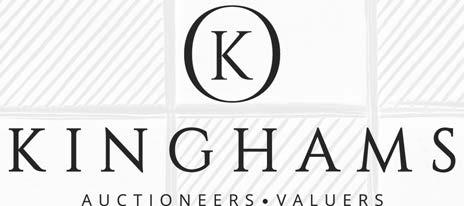
To be held at: 10-12 Cotswold Business Village, London Road, Moreton-in-Marsh GL56 0JQ
MONDAY 9TH & TUESDAY 10TH JUNE 2025
Viewing
Thursday 5th June – 10.00am to 4.00pm
Friday 6th June – 10.00am to 4.00pm
Saturday 7th June – 11.00am to 3.00pm
Monday 9th June – 9.00am to 10.00am
Tuesday 10th June – 9.00am to 10.00am
Day of the Sale
Auction scheduled to start at 10am with bidding in the room and live bidding on the internet bidding platforms. Telephone bids and commission bids are accepted and potential bidders will need to be registered with us before the sale.








Live internet bidding is available on www.kinghamsauctioneers.com, www.the-saleroom.com, www.invaluable.com, and www.easyliveauction.com together with a fully illustrated catalogue.
Catalogue £10.00 (£14.00 by post)
Kinghams Auctioneers Ltd 10-12 Cotswold Business Village, London Road, Moreton-in-Marsh GL56 0JQ
NB. Please telephone to arrange collection.
01608 695695 | enquiries@kinghamsauctioneers.com | www.kinghamsauctioneers.com

Peter Cameron is a world-renowned scholar and expert who has traded as a specialist in antique silver for fifty-two years. Peter is a Freeman of the Goldsmiths’ Company in London, and was a long-serving member of the Antique Plate Committee (subsequently, the Hallmarking Authentication Committee), an internationally renowned body, that adjudicates and advises on the authenticity of British silver. After studying history at Peterhouse, Cambridge, Peter Cameron began researching and dealing in antique silver in 1973. On his maternal side, the family’s involvement in the silver and jewellery trade dates back to the early 1800s, with a great-grandfather joining Lambert’s of Coventry Street in 1848, and a great-great-uncle founding London and Ryder at 17 New Bond Street in 1850.
In the world of antique silver, the name Peter Cameron is synonymous with quality, scholarship, and expertise. Peter has a well-earned reputation as a true expert with exacting standards. Kinghams Auctioneers is delighted to be entrusted with handling a collection of this calibre.
Matthew Lafite
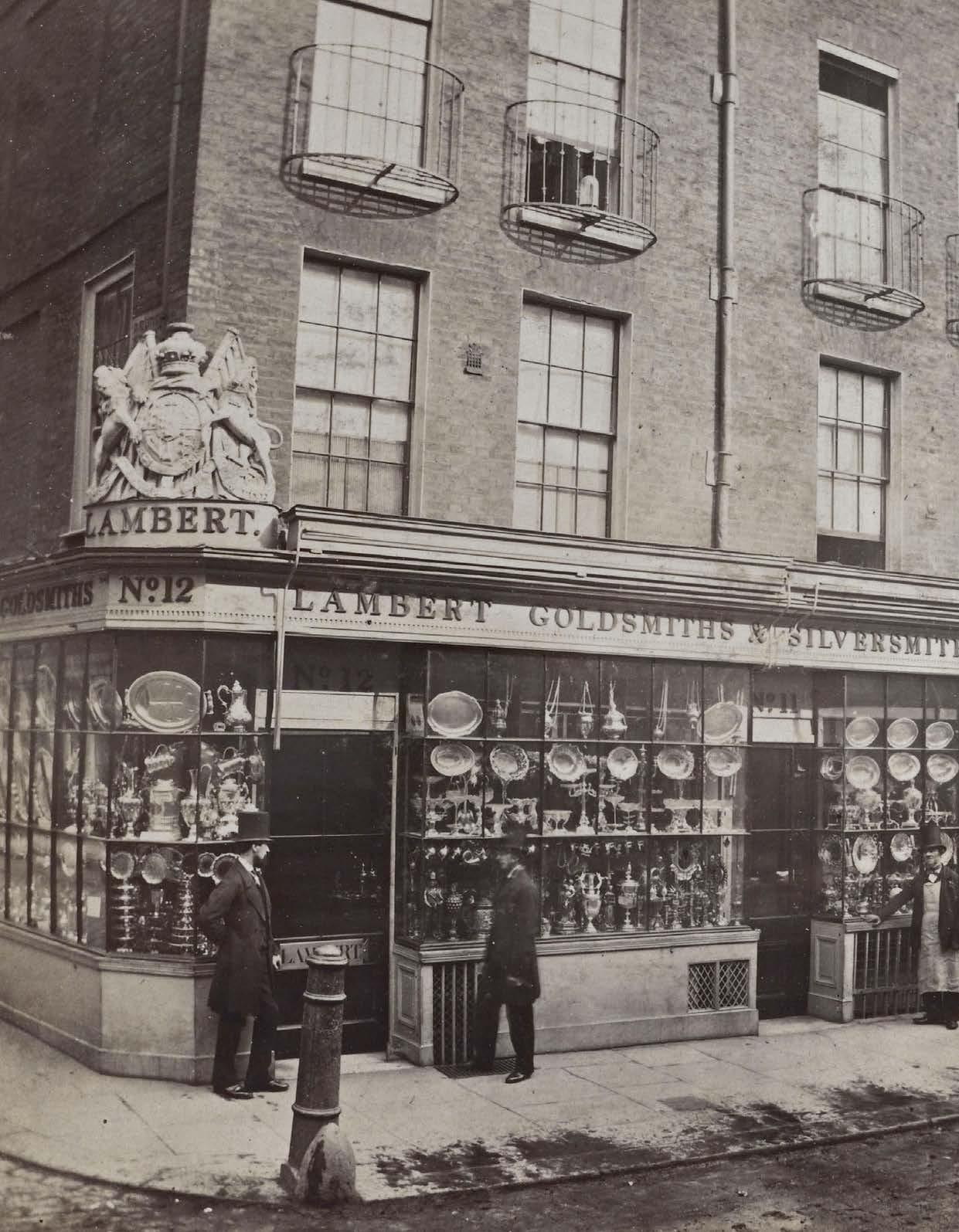
After fifty-two years of trading as a specialist in antique silver, I made the decision last summer to retire and I am delighted that Kinghams have agreed to undertake the sale of my pieces.
I became fascinated with silver, the most subtle, malleable and magical of metals, as a child: my mother’s family, Harman, had been directly involved in the jewellery and silver retailing trade since the early 1840’s- latterly at 177 New Bond Street. As John Bourdon-Smith often told me, when I used to hang around in the basement of his shop in Conduit Street, an antique dealer needs to love his stock a little’. My interest was not only in the material, silver, but also in the stories of the objects created out of it: their uses, designs, makers and owners. The lots in this sale represent my pursuit of these narratives. Hence, there is an engraving of the amazing Jernegan Wine Cistern, together with a number of the lottery silver prize medals and a catalogue of the lottery sale itself [only one other, in the British Library, is known], acquired during my researches into the Kandlers, silversmiths, working in London from 1728. The Kandlers are now known to have been brothers of the Meissen modeler, Johann Joachim Kaendler,. From the 18th century, also, are several pieces of ‘French plate’ – silvered brass made to imitate solid silver, called ‘French plate’ because immigrants from France, arriving in London, introduced the technique of plating with silver leaf. I still plan, eventually, to develop my two articles on ‘French plate’ makers into a larger work.
From the nineteenth century I am offering a few pieces made by the brothers Henry William and Louis Dee, who supplied extraordinary objects to the retail trade: their careers coincided with the early period of the Martin Brothers, pottery manufacturers, and some of the Dee’s bizarre designs are comparable to the Martin brothers’ work. I am also offering pieces made by the firm of Hukin and Heath, a partnership which, from 1870, when John Thomas Heath became Hukin’s partner, manufactured articles in silver-plate and in silver, using innovative design and the latest techniques. From the mid 1870’s into the 1880’s the firm employed the designer Dr. Christopher Dresser, of course, and his association with the firm thereafter, in the absence of archival proof, remains the subject of much uncertainty and speculation. My concern, in writing the article ‘The Partnership of Hukin and Heath’ was to focus on the family which ran the business and to point up their continuing enthusiasm for modern style: supplying articles fit for the new industrial age, often working in collaboration with ceramic manufacturers like Doulton and Coalport, and with glass makers, like Stevens and Williams. A significant part of the offering in this sale focuses on the ‘naturalistic’ objects – surely deriving from Dr. Dresser’s botanical and ‘aesthetic’ interests – which developed from the lotus bowls of the early 1880’s through to the range of ‘hammered’ designs displayed by Hukin and Heath at the Exposition Universelle in Paris in 1900.
Finally, amongst the assorted curiosities, including pieces of ‘medical silver’, I offer a group of tea strainers, essential utensils in the making of a proper cup of tea, which developed from simple pierced spoons with spiked handles, (19th century antique dealers re-named these strainers ‘Mote Spoons’), through the little buckets intended to hang from teapot spouts, introduced in the 1770’s, and on to infusers of various shapes and two-handled strainers based on the earlier lemon strainer but completed with little stands to hold drips of liquid.
Peter Cameron

Our auction centre is located in the historic Cotswold market town of Moreton-in-Marsh
We are centrally located on the A44 in reach of motorways the M5, M4, M40 and M42. Ample free parking.
Moreton-in-Marsh’s train station is less than a mile from the auction centre.

The nearest International Airports are Birmingham, 45 miles and Heathrow, 70 miles.
www.cotswolds.com/accommodation
We offer an in house packing service for most items up to 110cm x 80cm. Please email enquiries@kinghamsauctioneers.com for a quote or call 01608 695695 for a quotation


Please see full Terms and Conditions at the back of this catalogue.
There are several ways you can bid at our auctions; by leaving a commission bid, on the telephone and live via the internet.
It is essential that all prospective buyers register with us prior to the auction. Proof of identification will be required in order for a bidding number to be allocated which can then be used when bidding for an item.
Kinghams will execute bids if you are unable to attend the sale. Bids can be left with our staff during or after viewing, or in advance by telephone or e-mail: enquiries@kinghamsauctioneers.com

Lines must be booked by 5pm the day before the auction begins. Lines are booked on a first come first served basis. Full name, address and telephone numbers will be required together with proof of identity. Bank and/or credit/debit card details are necessary to secure the line.
Register online via www.kinghamsauctioneers.com, www.the-saleroom.com, www.invaluable.com and www.easyliveauction.com. Various charges apply, please check with your bidding platform.
Bidders must satisfy themselves as to the condition of each lot. Condition reports are available on request. (no later that 48 hours before the sale).
There is a buyer’s premium of 26% plus VAT on the first £500,000 of the hammer price of each lot. 18% plus VAT on the excess of £500,001 and up to £1,000,000 of the hammer price of each lot, and 15% plus VAT on the excess of £1,000,001 of the hammer price of each lot.
Must be made in full before items can be removed from the premises. If buyers are unknown to us, we cannot handover purchase until payment has been cleared.
Payment Methods - We accept payment by:
• Cash - up to £9,000 (subject to money laundering regulations).
• Cheques - we do not accept cheques.
• Debit cards accepted. We do not accept any credit cards.
• Bank transfer to:
HSBC Bank, 32 Bridge St., Evesham, WR11 4RU
Account No.: 51655345
Account Name: Kinghams Auctioneers Ltd
Sort Code: 40-20-27
IBAN: GB91MIDL40202751655345
SWIFTBIC: MIDLGB22
Please note that a fee of £15 will be added for international bank payments
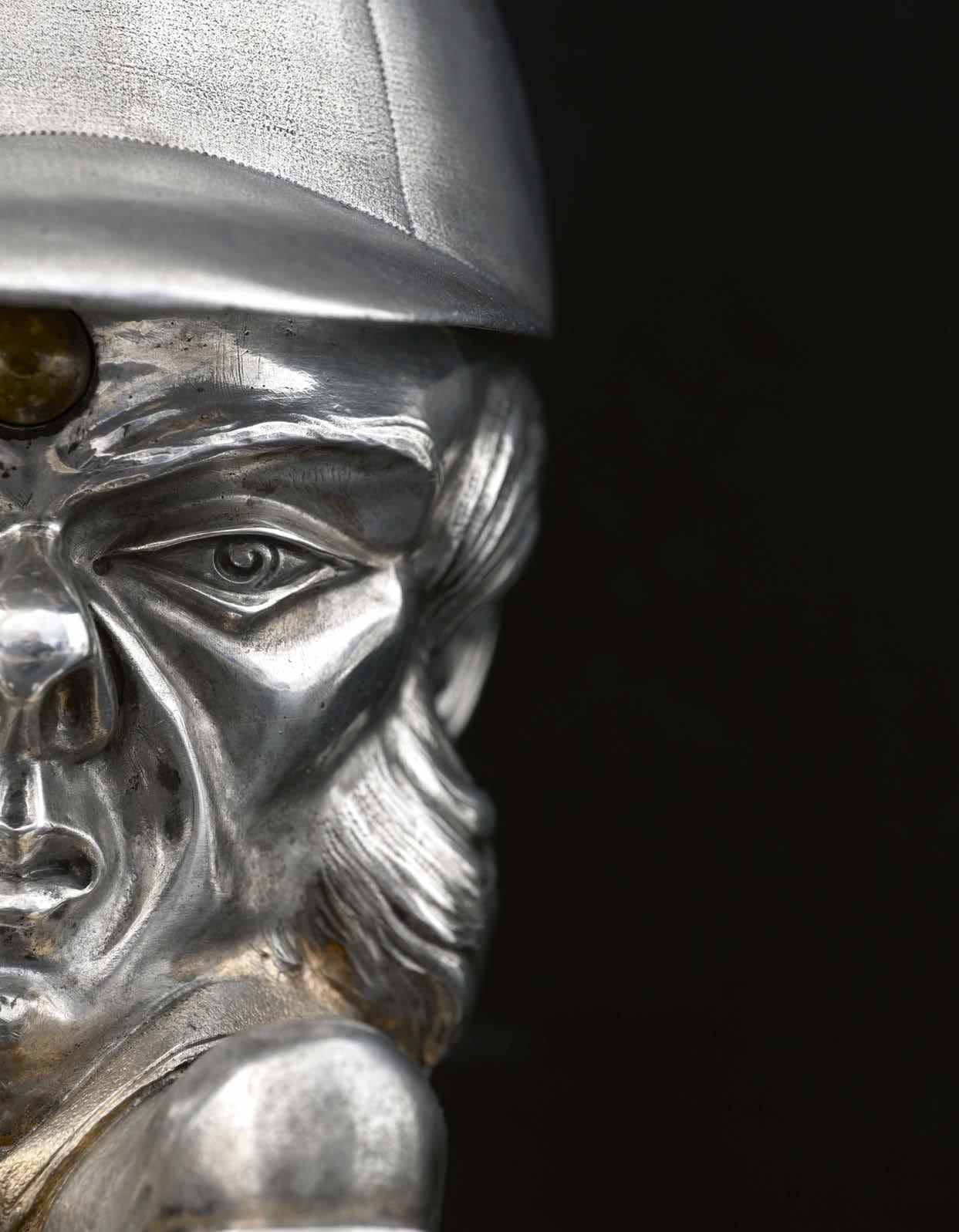


DAY ONE
Monday 9th June 2025 at 10:00

1 A pair of Victorian silver game skewers, each with cockerel finial, Josiah Williams & Co. (George Maudsley Jackson), London 1889, length 17cm, combined weight 36g/1.15ozt approx (2) £50 - £100

2
2 A set of four George V silver salt spoons/ladles, each with turned finial, Francis Higgins & Son Ltd., London 1914, length 8.3cm, together with a set of three whiplash salt spoons, Francis Higgins II, London 1861, combined weight 54g/ 1.73ozt approx £50 - £80

3 A Victorian silver sifter ladle, King’s pattern variant, cast in relief with flowers and shells, the pierced and gilt bowl with scalloped rim, George Adams, London 1858, length 14.2cm, together with a William IV Onslow pattern ladle, Jonathan Hayne, London 1830, combined weight 60g/1.92ozt approx £60 - £90

4

7
7 A set of six Victorian silver trefid pattern cake forks, each with rat tail, London 1900, by Thomas Bradbury, length 13cm, combined weight 124g/3.98opzt approx £100 - £150
8. Two Victorian silver butter knives, to include a lily pattern example, Thomas Smily, London 1867, length 19.7cm, and a fiddle, thread, and shell pattern example, by John Newton Mappin, London 1889, combined weight 135g/4.34ozt approx (2) £100 - £150

4 A single pair of early Victorian cast silver naturalistic tea tongs, with foliate-capped finger rings and arms, and shell bowls, William Theobalds & Robert Metcalfe Atkinson, London 1838, length 15.4cm, weight 102g/3.27ozt approx £70 - £100 5
5 A set of six Victorian cast naturalistic silver spoons, each with whiplash terminal, capped with foliage, and shell bowl, John Henry Williamson, London 1880, length 10.4cm, combined weight 94g/3.02ozt approx £70 - £100
6 Ireland, a mid-eighteenth century Irish silver marrow scoop, David T Peter, Dublin 1761, length 23.3cm, weight 55g/1.76ozt approx £80 - £120
9 A late Victorian silver cheese scoop, with shaped ribbed stem and foliate engraved decoration, Henry Atkin, Sheffield 1900, fitted in the original case with retailer’s name, ‘Gaydon & Sons, Jewellers to Her Majesty, Kingston-on-Thames’, length 20.2cm, weight (sans case) 75g/2.41ozt approx £100 - £150

10
10 A set of six Victorian silver dog nose rat-tail pattern salt spoons, each with gilt bowl, armorial and crest of a griffin, Francis Higgins III, London 1880, length 10.4cm, combined weight 97g/3.11ozt approx (6) £80 - £120

11 An early Victorian silver marrow scoop, the reverse of the bowl inscribed, ‘A wedding present from their affectionate children May 17th 1856’, Lias Brothers, London 1838, length 23.2cm, together with a second marrow scoop, by ‘JRH’, hallmarked London 1842, combined weight 114g/3.66ozt approx (2) £100 - £150

12. A George IV silver fiddle pattern fish slice, London 1829, Emes and Barnard, the handle engraved with crest of stag head coupled, length 26.3cm, weight 138g/ 4.43ozt approx £100 - £150
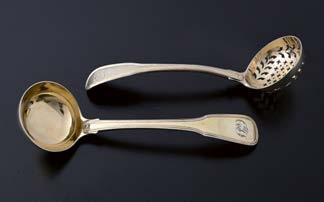
13 A pair of George III silver-gilt fiddle and thread pattern dessert servers, comprising a small ladle and sugar sifting spoon, London 1803, Eley and Fearn, engraved with script owner’s initials ‘CJT’, length 16cm, combined weight 110g/ 3.53ozt approx (2) £100 - £150
14 Newcastle, A George III English provincial silver skewer, Newcastle 1790, Langlands and Robertson, length 34.3cm, together with a George III silver game skewer, hallmarked London 1794, combined weight 162g/5.20ozt approx (2) £120 - £180

15 A collection of four marrow scoops, comprising a George III silver beadedge example, William Sumner & Richard Crossley, London 1774, length 21.9cm, a George III silver feathered-edge example, maker’s mark rubbed, London 1781, and two electroplated marrow scoops, combined weight of hallmarked examples 99g/3.18ozt approx (4) £120 - £180
16 A pair of Victorian silver butter spades, with registered design number ‘46069’, Elkington & Co (Frederick Elkington), Birmingham 1888, length 17.5cm, together with a cased pair of Victorian silver butter knives, Allen & Darwin, Sheffield 1897, combined weight 145g/4.66ozt approx £120 - £180

17 A Victorian silver cream ladle, the handle cast and modelled as a bullrush, with textured leaves, and gilded circular bowl, by Edward Stockwell, London 1875, length 12.5cm, weight 42g/1.35ozt approx

£120 - £180 18
18 A late 19th century French silver scoop with long wooden handle, by Edgar Morgan of Nice and Paris, the scoop engraved: ‘Carnaval Nice 1896.’, length 38.5cm approx
Note: The purpose of this scoop, perhaps for confetti or for sweets, is uncertain. The Carnival in Nice originated in the medieval period but was renewed in 1873.
£120 - £180

19
Ireland, a set of six George III Irish silver teaspoons, Dublin circa 1765, Michael Keating, with feather edge engraving and asymmetrical scroll cartouche, length 12.6cm, combined weight 83g/2.66ozt approx
£120 - £180
20 Three Victorian silver butter spades, the stem of one decorated with foliate tendrils, on a stippled ground, with armorial crest, Francis Higgins, London 1865, length 16.8cm, one with Rococo shell terminal, and feathered bands, Martin & Hall, Sheffield 1872, one of Hanoverian pattern, Francis Higgins, London 1884, combined weight 158g/5.07ozt approx (3)
£150 - £200
21 Two eighteenth-century silver marrow spoons, to include a scroll back example, Thomas Chawner, London 1775, length 22.7cm, the second by ‘WT’, London 1765, combined weight 104g/3.34ozt approx (2)
£150 - £250

22 Two eighteenth-century English silver sugar tongs, to include an example of fire-tong type, circa 1720, struck once on the inside of each pan with a maker’s mark only possibly R’, length 13cm, and a pair of George III silver sprung example, with feather edge decoration, John Booth I, London circa 1780, combined weight 50g/1.60ozt approx (2)
£150 - £200

23 A set of four George III silver graduated game skewers in three sizes, struck with an unattributed maker’s mark, possibly ‘JP’, and a lion passant only, each with a stylised shell finial, circa 1780, length of longest 21.3cm, combined weight 77g/2.47ozt approx (4)
£150 - £200
24 A punch ladle with a turned wood handle, the interior of the bowl struck with a single maker’s mark only, ‘P.I’, unidentified, possibly Scottish provincial, length 32.5cm, together with an early Victorian silver punch ladle with turned wood handle, Birmingham 1838, Joseph Willmore, length 35cm approx (2) £150 - £250

25 A set of three eighteenth-century silver hooked condiment ladles, London circa 1765, one pierced for sifting, the larger ladle struck twice with maker’s mark only ‘P. & W’, for Parker and Wakelin, length (of larger) 13.4cm, combined weight 109g/3.50ozt approx (3)
£150 - £200


30
30 Ireland, a pair of heavy eighteenth-century Irish silver tablespoons, Dublin 1789, John Pittar, in imitation of a European fiddle pattern, each engraved with a later crest, length 20.3cm, combined weight 193g/6.20ozt approx (2) £150 - £200
31 A George III silver meat skewer, decorated with foliate scrolls on an etched ground, initialled ‘SB’ or similar, George Wintle, London 1812, length 32.7cm, together with a meat skewer by Eley, Fearn & Chawner, London 1812, combined weight 170g/5.46ozt approx (2) £170 - £200
£150 - £200
26 A nineteenth-century Scottish punch ladle with turned wooden handle, maker’s mark only, probably Peter Sutherland, Edinburgh, circa 1830, the bowl of the ladle chased with stags and eagles amidst Scottish scenes of hills, waterfalls and plants, length 38.5cm approx
27 A George I silver punch ladle, London 1724, Louis Cuny, with turned wood handle, fully marked to the underside of the bowl, length 32.5cm approx
See: Grimwade 3715 for maker’s mark.
£150 - £200

32 An unmarked 19th century punch ladle, with wooden handle, probably Scottish, circa 1835, the bowl chased with vine and grapes and a Bacchic head, the socket formed as an entwined grape branch, length 41.5cm, together with a George III silver punch ladle, London 1813, possibly by Elizabeth Morley, the handle of baleen, the interior of the bowl engraved with a gourd and ‘Reward of Merit’, the exterior engraved with a bell below ‘Isleworth’, length 43cm approx (2) £180 - £220

33
£150 - £200
28 A cased individual pair of George IV silver-gilt grape scissors, vine and grape decoration, Charles Rawlings, London 1824, length 14.8cm, weight 115g/3.69ozt
29 Two Scottish silver marrow scoops, one hallmarked for George McHattie, Edinburgh 1827, length 23.1cm, the other marked with the duty and thistle marks only, combined weight 99g/3.18ozt approx (2) £150 - £200
33. A George II silver marrow scoop, London 1747, Ebenezer Coker, the reverse of the scoop engraved with owner’s initial ‘JR’, length 24.4cm, together with an eighteenth-century marrow scoop by Charles Hougham, and a Victorian silver Hanoverian pattern single scoop, London 1899, combined weight 125g/4.01ozt approx (3) £180 - £220

34. An individual pair of French first standard silver sprung Asparagus servers, circa 1890, engraved on each side with the owner’s cipher, length 9.5cm, together with a French first standard silver sauce or papboat, engraved with foliage and birds, circa 1860, length 14.6cm, combined weight 289g/9.29ozt approx (2)
£180 - £220
35 A pair of George III silver single struck old English thread pattern gravy spoons, each with an armorial crest, London 1799, H. Northcote, length 29.4cm, weight 209g/6.71ozt approx (2) £180 - £220
36 A George III silver shell-end skewer, maker’s mark only, Thomas Chawner, London circa 1775, with armorial crest, length 35.5cm, together with a smaller skewer, hallmarked London 1770, combined weight 225g/7.23ozt approx (2)
£180 - £220
37 A set of four George III English provincial silver skewers, Sheffield, 1799, John Younge & Sons, engraved with a family crest, two larger and two smaller, length (of larger) 25.7cm, weight 237g/7.61ozt approx (4) £200 - £300
38 A George III old English pattern silver gravy spoon, London, 1771, Thomas Dealtry [probably], the spoon terminal is engraved with the crest of Acland of Killerton, Devon, length 28cm, together with a Hanoverian pattern silver basting spoon, Elias Cathcart, London 1752, Engraved with a contemporary crest for a branch of the family of Lawson of Northumberland, combined weight 237g/7.61ozt approx (2)
£200 - £300
39 A George IV Scottish woodenhandled silver punch ladle, Robert Gray and Sons, Glasgow 1829, length 47.5cm, together with a George II punch ladle, London 1731, George Greenhill Jones, the bowl engraved underneath, ‘Ex Dono T.S’, length 35cm approx (2) £200 - £300

40 A pair of Victorian silver fiddle thread and teardrop pattern fish servers, London 1867, George Adams, each piece engraved with a family crest, length (of knife) 32cm, combined weight 287g/9.22ozt approx (2)
£200 - £300
43 A nineteenth-century silver folding combination fork, spoon, and toothpick, modelled in the early 18th century manner, engraved with the coronet of a British marquess above script initials ‘FH’, circa 1820, length 20cm, weight 64g/2.05ozt approx
Note: Identified almost certainly for Francis Seymour Conway, Marquess of Hertford, 1777-1842, much of whose art collection now forms the Wallace Collection, London. £200 - £300
£180 - £220
41 Hunt and Roskell, a pair of Victorian silver Admiralty pattern table forks, together with a table spoon, London 1866, the reverse also struck with the War Department incuse arrow head, length (of fork) 20.5cm, combined weight 236g/7.58ozt approx (3)
42 A cased pair of late Victorian parcel-gilt silver sugar tongs, the Farriers’ Company for Queen Victoria’s Diamond Jubilee, incorporating horseshoes as the grips and at the bow end, London 1897, by Stuart Clifford, the outer side of the bow engraved with an inscription, resented by he Worshipful Company of Farriers 1897 length 10.6cm, together with a cased pair of novelty horseshoe form napkin rings, Birmingham 1928, combined weight (sans cases) 61g/1.96ozt approx (2) £200 - £400
44 A set of four toy spoons, old English pattern with bright-cut decoration, struck with a maker’s mark ‘W. Bold’, unattributed, circa 1800, length 5.7cm, together with a set of six Hanoverian pattern miniature spoons, maker’s mark only in script letters, possibly for Marmaduke Daintrey, London, circa 1750, combined weight 27g/0.86ozt approx £200 - £300
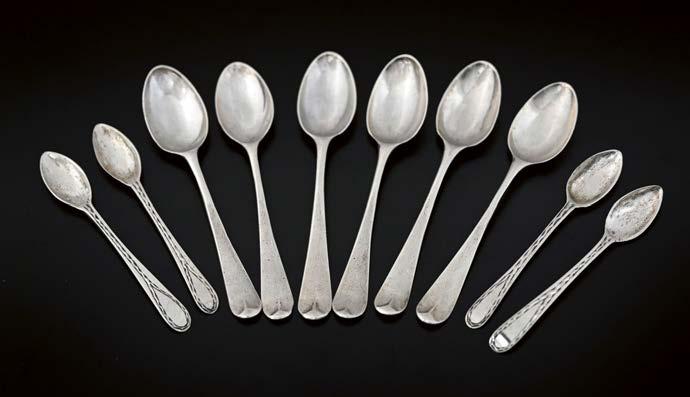

45
45 A set of three cast silver serving spoons, each with cast stem decorated with flowerheads and anthemion, and gilt lobed bowl, Mappin & Webb (John Newton Mappin), London 1888, length 24.3cm, combined weight 282g/9.06ozt approx (3)
£200 - £300
49 Two George III silver Old English pattern salad forks, each terminal with an armorial crest, one marked for Richard Crossley, London 1799, the other George Smith, London 1798, length 28.3cm, combined weight 248g/7.97ozt approx (2)
£220 - £280

50
52 A William III silver trefid spoon, London 1700, by Thomas Spackman, with beaded rat tail, the back of the terminal engraved with contemporary owner’s initials ‘E.H.’, length 19.9cm, weight 60g/1.92ozt approx
Note: Spackman entered his mark on the 25th May in that same year. £250 - £350
53. France, a pair of eighteenthcentury Strasbourg silver fiddle and thread gravy spoons, Abraham Wenk, 1768, each engraved on the front with an English family crest, length 29.5cm, combined weight 316g/10.15ozt approx (2)
£250 - £300
46 Three silver cheese scoops, one fiddle, thread and shell pattern example by Francis Higgins, London 1881, length 22.4cm, a George IV example by William Bateman, London 1826, and one other hallmarked London 1925, sponsor’s mark rubbed, combined weight 311g/9.99ozt approx (3)
£220 - £280
47 France, a late 18th-century French silver ladle, or ‘louche’, Salins, FrancheComte, circa 1780, Pierre-Ignace-Joachim Thiebaud, the reverse of the handle, engraved with coats-of-arms accole beneath a ducal coronet, length 38.3cm, weight 288g/9.25ozt approx
Note: this form of large ladle is apparently peculiar to this area of France, adjacent to the Swiss border.
£220 - £280
48 Newcastle, a George IV English provincial silver fiddle and shell pattern strainer spoon, with script initials ‘JEB’ or similar, Thomas Watson, 1828, length 29.3cm, together with an old English pattern gravy spoon, John Langlands, 1802, the terminal engraved with a fortified building above the gothic letters ‘CFC’, length 30cm, combined weight 275g/8.84ozt approx (2)
£220 - £280
50 Two Victorian silver grape scissors, to include an example with cast grape feet, London 1838, by Theobalds and Atkinson, length 15.7cm, together with a further example by John Aldwinckle & James Slater, London 1882, combined weight 232g/7.45ozt approx (2)
54 A Victorian silver Albert pattern hinged server, maker’s mark rubbed, London 1862, length 23cm, together with a single pair of salad tongs, Sheffield 1933, combined weight 305g/9.80ozt approx (2)
£250 - £300
£250 - £350
51 A pair of Victorian silver salad servers with twisted handles imitating whalebone, London 1872, George Adams, length 32.2cm, combined weight 185g/5.94ozt approx (2)
£150 - £200

55 A pair of George III silver needleform skewers, with ring terminals, London 1783, by Charles Kandler, each skewer engraved with a contemporary crest, length 32.5cm, combined weight 236g/7.58ozt approx (2)
£250 - £350

56
56. A French silver pierced server, decorated with foliate scrolls, circa 1900, length 22cm, together with a nineteenthcentury French silver-gilt server, the handle decorated in relief with fruiting vine, scrolls, and shells, length 23.7cm, combined weight 288g/9.25ozt gross approx (2)
£250 - £350

57 A Victorian cased silver cucumber saw, the blade mounted with a replacement wood handle, London 1887, Hirons & Plante, in an original retailer’s case for Martin & Co., Cheltenham, length 22.4cm, weight (sans case) 60g/1.92ozt approx £250 - £350
60 York, a single pair George III English provincial silver large silver-handled scissors, Barber and Whitwell, circa 1815, length 20.2cm approx
Note: the York assay office registers show five pairs of grape scissors sent for assay by Barber and Whitwell: two on August 15th 1814; another one on October 16th 1815; and two on November 13th 1815.
£300 - £500

61 York, a long pair of George III English provincial silver and steel scissors, one arm engraved with a crest, Prince and Cattles [incuse mark], York, 1805, length 22.3cm approx
Note: the scissors are struck also with 'E' in a rectangular punch,
£250 - £350
58 A single pair of Victorian silver asparagus servers, Francis Higgins, London 1886, length 22.3cm, together with a Victorian silver server, George Adams, London 1855, combined weight 309g/9.93ozt approx (2)

59
59 A set of nine Victorian silver Albert pattern teaspoons, each engraved with a crest, George Adams, London 1850, length 14.7cm, combined weight 327g/10.51ozt approx £250 - £350



for Lias Brothers, London 1845, length 24.3cm, the other by George Adams, London 1872, combined weight 405g/13.02ozt approx (2)
£300 - £500


65 A single pair of Victorian silver serving or asparagus tongs, London 1851, by Elizabeth Eaton, the arms pierced and engraved, with a cast and applied scroll-capped terminal, struck with a design registration lozenge for 28th April 1852, engraved with an owner’s crest, length 31.7cm, together with a Victorian silver server by George Adams, London 1863, combined weight 378g/12.15ozt approx (2)
£300 - £500
66 A Victorian rococo pattern silver soup ladle, London 1854, George Adams, 33cm, together with an Onslow pattern ladle, C. S. Harris, London 1898, combined weight 425g/13.66ozt approx (2)
£300 - £500
67 A group of three silver gravy spoons, to include a Victorian Old English pattern spoon, the terminal with armorial crest, George Adams, London 1850, length 29.8cm, together with a Victorian Old English thread gravy spoon, George Adams, London 1861, and a Hanoverian rat-tail spoon, David Landsborough Fullerton, London 1917, combined weight 418g/13.43ozt approx (3) £300 - £500
68 A pair of Victorian silver Kings pattern gravy spoons, each terminal with an armorial crest, London 1894, Charles Boyton, length 29.5cm, together with a further hallmarked Kings pattern gravy spoon, Josiah Williams & Co., London 1911, combined weight 599g/19.25ozt approx (3) £500 - £800
69 A George IV silver-gilt knife, fork and spoon, modelled in the mid-17th century European manner, London 1825, William Eley, the steel knife blade also struck with the retailer’s mark of Rundell, Bridge and Rundell below ‘GR’, length of knife 27.1cm, weight (sans knife) 323g/10.38ozt approx (3)

71
71 A composite part flatware canteen, old English thread pattern, eighteenth-century and later, the majority containing the armorial crest of Acland, baronet, Killerton, Devon, and Holnicote, Somerset, blazon: On A Sinister Arm In Fesse Vested Az., Gloved Arg., A Hawk Perched Of The Last, Beaked And Belled Or., multiple dates and makers, the majority by Richard Crossley, London 1785, with incuse duty mark, comprising: forty-eight main course forks six tablespoons five dessert spoons twenty entree forks twenty-three silvergilt dessert forks twenty-four silver-gilt dessert spoons thirty teaspoons four sauce ladles a sifter ladle four condiment spoons three basting spoons a single pair of asparagus servers a single pair of sugar tongs twelve main course knives with steel blades and silver handles six entree knives with steel blades and silver handles Combined weight (sans knives) 9,281g/298.39ozt approx £6,800 - £7,800
Note: for two spoons of this pattern by William Eley, also 1825, see ‘English Silver Spoons, Michael Snodin, p. 60, pl. 46 - part of a set with two knives and a fork [C.J. Vander].
£800 - £1,200
70 A seventeenth-century German silver-gilt spoon, Ulm circa 1665, by Hans Ludwig Kienle, the reverse of the spoon engraved with coats of arms and initials, that on the right identified as Neidhart or Neydhart, below the initials ‘IN’, the arms on the left below the initials ‘MN’, length 16cm, weight 50g/1.60ozt approx
Note: the Neidharts were one of a group of patrician families in Ulm.
See: ‘Goldschmiedekunst in Ulm, Die Werke im Ulmer Musem’, pp. 94-5, for a spoon of the same form. £1,000 - £1,500
72 Winchester School interest, a George III silver marrow scoop, London 1760, by John Gorham, the stem engraved, circa 1800, with ‘Coll. Winton.’, length 22.5cm, together with a Victorian silver marrow scoop, George Adams, London 1848, combined weight 110g/3.53ozt approx (2)
£150 - £200
73 Glasgow, a pair of heavy Scottish fiddle pattern silver gravy spoons, Glasgow 1827, by WM over AM, the top engraved with a contemporary crest above a script ‘C’, length 29.7cm, combined weight 352g/11.31ozt approx £300 - £500
74 A pair of George III silver single struck old English thread pattern gravy spoons, of unusual length, each terminal with an armorial crest, London 1813, Samuel Godbehere and Edward Wigan, length 33.8cm, combined weight 263g/8.45ozt approx (2) £250 - £350
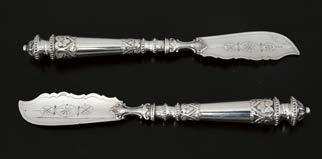
75
75 A pair of Victorian silver butter knives, the blades decorated with brightcutting, the handles foliate scrolls, and beaded edge, Martin & Hall, Sheffield 1870, length 19cm, combined weight 101g/3.24 gross all-in approx (2) £80 - £120

76
76 Nathaniel Mills, a cased Victorian silver castle top card case, of shaped rectangular form, with an unidentified engraved landscape scene, featuring a castle and a ruin, the exterior decorated with engineturning, ensuite with a fitted presentation case, retailed by ‘Thos. Reynoldson, Queen St. Hull, by special appointment to...The Prince of Wales’, Birmingham 1852, length 9.8cm, weight (sans case) 62g/1.99ozt approx £250 - £350

77
77 Nathaniel Mills, a Victorian silver nutmeg grater, of rectangular form with reeded decoration, the hinged cover applied with a rectangular cartouche engraved with a crest, the interior with a fixed steel rasp, Birmingham c.1850, length 4.6cm, weight 41g/1.31ozt gross approx £200 - £400
79 A George III silver nutmeg grater, of rectangular form, with dual hinged covers, the top engraved with an armorial crest of a goshawk, with motto above, ‘Virtutem coronat honos’ (Honour crowns virtue), possibly for Clan Drummond, the interior with a fixed steel rasp, Thomas Phipps & Edward Robinson, London c.1800, length 4.1cm, weight 47g/1.51ozt gross approx £200 - £300
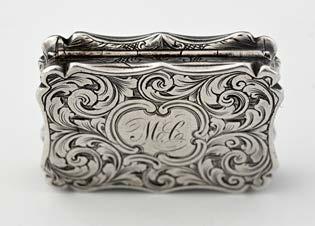
80

78 An early Victorian silver nutmeg grater, of rectangular form, with reeded decoration, with dual hinged covers, the interior with static steel rasp, Charles Rawlings & William Summers, London 1839, length 6.1cm, weight 93g/2.99ozt gross approx £250 - £350 79
80 A Victorian silver vinaigrette, of shaped rectangular form, with cast applied floral scroll thumbpiece, the cover with an engraved unidentified harbour scene, Nathaniel Mills, Birmingham 1849, length 3.7cm, weight 18g/0.57ozt approx £200 - £300
81 A group of four Victorian silver items from a ladies’ necessaire, comprising a vinaigrette, scent bottle, a shuttle, and a pincushion, each engraved with flowers amidst foliage and the name arguerite London 1873, William Thomas Wright and Frederick Davies, length of scent bottle 5.2cm, combined weight 84g/2.70ozt gross all-in approx (4) £300 - £500


82
82 A Victorian silver castle top vinaigrette, Nathaniel Mills, Birmingham 1849, of shaped oval form, the cover with an engraved view of Holyrood Palace, and Edinburgh, with Arthur Seat in the background, the hinged cover opens to reveal a gilt interior, and a hinged grille pierced with foliate scrolls, ensuite with a presentation inscription, ’To Mrs Maitland along with token of regard presented to her husband by friends and workmen of C B Distillery Sept 1856’, length 5.2cm, weight 24g/0.77ozt approx
Note: the scene is perhaps after the drawing, olyrood Palace from the roadby James Duffield Harding, originally produced for John Parker Lawson cotland Delineated in a Series of Views(1847-1854).
£350 - £450

83
83 A mid-Victorian silver engineturned vesta case, of rectangular form and dual hinged covers, one opening to reveal an internal striking compartment, gilt interiors, Birmingham 1853, Cronin & Wheeler, length 5cm, weight 28g/0.90ozt gross all-in approx £80 - £120

84
84. An Edwardian silver combination sealing wax holder, desk seal, with vesta case, London 1904, the maker’s mark unattributed, the body engraved ‘C.J.C. from F.C.C. 1904’, the seal matrix with a coat-ofarms for Carter, length 20.5cm, weight 83g/2.66ozt approx
Note: the probable donor of the case is Brigadier General Francis Charles Carter and the possible recipient Charles [Edwin] James Carter. £100 - £200

85
85 A late Victorian silver heartshaped vesta case, Birmingham 1898, A. Zimmerman, the hinged cover affixed with a suspensory loop, one side engraved with contemporary initials ‘F.G.P.’, length 4.5cm, weight 39g/1.25ozt approx £100 - £150

86
86 A Victorian novelty silver table vesta in the form of a milk churn, the body with coopered bands, London 1892, Saunders and Shepherd Ltd, the lid with inset match holder as a ‘Go to Bed’, with weighted base, height 7cm approx £100 - £150

87
87 A Victorian silver novelty vesta case, modelled in the form of an attach case with flap and catch, London 1893, Wilkinson & Holland, with gilt interior, the base with integral striker, length 3.8cm, together with a silver vesta case with sprung lid and catch, Birmingham 1881, Joseph Hayes Taylor, combined weight 37g/1.18ozt all-in approx (2) £150 - £200

88
88 A Victorian cast silver novelty zoomorphic vesta case, modelled in the form of a standing pig, the hinged head secured to the body by a catch, with pushbutton release, the interior of the cover with integrated striker, Jane Brownett, London 1880, length 8cm, weight 107g/3.44ozt approx £350 - £450

89
89 A Victorian silver novelty vesta case, formed as a shoe last, London 1877, Brownett and Jones, the sole enamelled with “Here the Last.”, length 7cm, weight 27g/0.86ozt approx £400 - £600

90
90 An Edwardian novelty silver match box holder, London 1904, A. Barrett & Sons, the pierced top engraved with a sleeping pig and ‘Scratch Me’, the sides engraved with rural scenes of a farmer and a farmer’s wife leading a pig to market, set of four bun feet and engraved under the base with the retailer’s name and the address 63 & 64 Piccadilly, length 7.2cm, together with an unmarked white metal pipe case/holder, the perforated hinged cover with an Earl’s coronet, length 12.4cm approx (2)
£200 - £300
91 An Austrian silver and enamel combination cigarette case, vesta compartment, striker and fusee, with hook and chain, Georg Adam Scheid, Vienna, circa 1893, marked ‘G.A.S.’ and the Austrian 900 standard mark, the front of the case applied in enamel with a hunting scene and engraved ‘Bechtolsheim-Dragoner Holics 1898. the inner rim engraved with a retailer’s name ‘L. Schuchs, Nachf, Wien.’, length 10.1cm, weight 212g/6.81ozt gross approx

93
93 A Victorian cased silver combined flask, cigar case and vesta case, London 1849, William Francis, engraved also with a design registration number for the 17th March 1849, no. 1815, the Flask is later engraved with a presentation inscription to Mr. William Riley of the Cambridge Music Hall in Commercial Road, London in October 1886, ensuite with a fitted presentation case, length 19.1cm, weight (sans case) 572g/18.39ozt approx
Note: the presentation of this ‘refreshment flask’ to Mr. Riley on his departure to America is recorded in “The Era” (London, England), Saturday, October 23, 1886; Issue 2509. £800 - £1,000
£600 - £800
Note: The firm of L. Schuch’s, Austrian Imperial Court supplier, was founded in 1831, and was succeeded by G. Edlauer. Holics, in Slovakia, was at this date a part of the Hapsburg empire. The Bechtolsheim Dragoons, the fifteenth Dragoon regiment of the Austrian Imperial army, was otherwise known as Archduke Joseph Lower Austria and Moravian Dragoons and was composed largely of troops of Czech nationality.
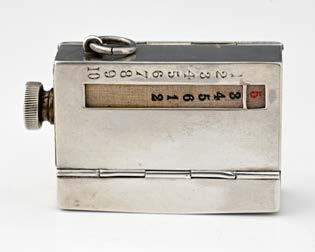
92
92. An Edwardian silver combination ten gun shooting butt marker and vesta, of rectangular form, the hinged cover opening to reveal a sectioned interior housing ten bone and composite peg markers, the front with a scrolling aperture for 5-10 guns at 1-10 positions, a further hinged cover with an internal fitted striker, designed to take matches, the obverse engraved, “From Minna 1909”, retailed by ‘J. C. Vickery. 179. 181. 183. Regent St’, sponsor’s mark John Collard Vickery, London 1909, dimensions 6.2x3.8x1.5cm approx
£700 - £900

94
94 A Victorian fusee box, London 1861, Benjamin Barling, engraved with a contemporary crest and the retailer’s name: ‘Carlin, 189, Regent Street.’ Length 6cm, weight 34g/1.09ozt gross approx
Note: Thomas Carlin, Cigar Merchant, took out an advertisement in the Standard on 26th February 1895: ‘IMPORTANT NOTICE. Carlin, 189, Regent Street, W., Cigar Importer, established 1825, begs to inform his patrons and the public that he is in NO WAY CONNECTED with ANY OTHER HOUSE, and his only address is as above.’
£100 - £150

95
95 Nathaniel Mills, an early Victorian silver snuff box, of rounded rectangular form, the exterior decoration with foliate-capped scrolls on a textured ground, the cover inscribed, ‘From Lieut. Wm. Seymour Scroggs 5th Fuss. to Joseph Banting. April 1845’, the hinged cover opens to reveal a gilt interior, fully hallmarked for Birmingham 1843, length 9.1cm, weight 76g/2.44ozt approx £150 - £200

96
96 A nineteenth-century novelty base metal snuff box, modelled in the form of a fox’s head, length 7.9cm, together with an Old Sheffield Plate cylindrical nutmeg grater, in the form of those produced by Matthew Boulton and others, length 6.9cm approx (2) £150 - £200

97

98
98 Cape silver, a nineteenth-century silver snuff box, the exterior decorated in the manner of a Birmingham-made box of circa 1820, with gilt interior, by Lodewyck Beck, circa 1850, length 6.1cm, weight 69g/2.21ozt approx
See: Stehan Welz, ‘Cape Silver and Silversmiths’, p. 145, for an illustration of Beck’s marks £200 - £300

99
99. A Victorian silver snuff box, with presentation inscription, “Presented by D. Nicholson of North Terrace Wandsworth to Wm. Fell Esqr. for the unwearied attention during his Beloved Parents Illness 1858”, George Unite, Birmingham 1858, length 8.6cm, weight 90g/2.89ozt approx £250 - £350

100
£180 - £220
97 A late-seventeenth or early-eighteenth-century silver and parcel-gilt snuff box, of oval form, decorated in relief with flowers and foliage, the underside with a standing bird, the hinged cover with ‘squeeze’ opening mechanism, and gilt interior, apparently unmarked, Continental, circa 1680-1720, length 6.2cm, weight 58g/1.86ozt approx
100 A small Victorian silver snuff or pill box, Birmingham 1840, J. Tongue, the exterior with scrollwork engraving and the script name ‘Chappell’, length 3.8cm, together with a George IV silver narrow rectangular Vinaigrette, the base and lid with engine-turning, the sides reeded, Birmingham 1827, Ledsam, Vale, and Co., combined weight 32g/1.02ozt approx (2) £200 - £300

101 Hester Bateman, a George III silver snuff box or tobacco box, of navette form, the detachable cover engraved with two armorials, flanking a central circular mount, missing the inset plaque or panel, the interior of the base fully hallmarked, with corresponding part marks struck to the cover, also stuck with the incuse duty mark, London 1785, length 12.1cm, weight 150g/4.82ozt approx
£300 - £400


104 An early eighteenth-century terrapin shell snuff box, as a tortoise with head and legs, the interior of the hinged cover struck thrice with maker mark within a shaped cartouche, Hor I unascribed, possibly English or European, circa 1700, length 7.4cm approx
£1,000 - £1,500

105
105 An eighteenth-century snuff horn, with unmarked silver mounts, the hinged cover applied with a silver boss engraved with a shovel and rake above ‘AR // 1759’, and the body with an applied silver plaque, ‘From J.T.M who in Dorking doth dwell, To John of the Hotel’, with a crown and anchor, together with a small snuff horn with unmarked silver mounts, length (of larger) 11.2cm approx (2)
£350 - £450
102. An early eighteenth-century silver and mother-of-pearl snuff box, the cover inset with a relief-carved panel depicting a classical scene, with gilt interior, apparently unmarked, circa 1730, length 8cm approx

103
103 Maritime and Betsy Cains interest, a circular wooden snuff box, the pull-off lid inset with copper, inscribed ‘Made from the Wreck of the Betsy Cains 1688, which brought King William to England.’ and in the centre: ‘A. Reed 1827 Mayor’, diameter 8.6cm approx £350 - £450
£220 - £280

106
106 A George III snuff horn, mounted in unmarked silver, the hinged cover decorated in relief with foliate-capped scrolls, with central cast foliate thumbpiece, inset with a polished cairngorm, length 8.5cm, together with a second snuff horn, the hinged cover applied with a silver boss of a bulldog and a kennel (2) £250 - £350



107 York, an early nineteenth-century English provincial silver-mounted snuff horn or snuff mull, the interior of the plain hinged cover struck with hallmarks, James Barber & William Whitwell, York c.1820, length 10.5cm approx
109 A Dutch silver box and cover, circa 1700, the body decorated with flowers and foliate scrolls, the detachable cover with a repouss scene, the interior of the base marked ‘J.P’ or similar, height 2.2cm, diameter 4.3cm, weight 26g/0.83ozt approx
Note: for an early example of a wedding box with the same scene, see a box, unmarked, by Harmen Dircks, Friesland, circa 1623, illustrated in J.W. Fredericks, ‘Dutch Silver’, vol. 3, plate 271, p. 226. £80 - £120
110 A Victorian Scottish silver box, the cover with armorial crest of a boar’s head, initialled ‘MB’, Marshall & Sons, Edinburgh 1862, length 8cm, weight 107g/3.44ozt approx £150 - £200
111 Three eighteenth-century silver and agate boxes, the smaller example struck with maker’s mark only, ‘NH’ or ‘HN’, circa 1720, diameter 2cm, together with an upright box with hinged cover, unmarked, circa 1745, height 2.7cm, and a larger box with detachable cover and gilt interior, unmarked, circa 1760, diameter 3.9cm, combined weight 44g/1.41ozt gross all-in approx (3)
£150 - £200
£250 - £350
See: Baggott, M. (2010). An Illustrated Guide to York Hallmarks 1776-1858 and a Transcript and Index of the York Assay Office Ledger 1805-1821, p.131 where it is listed that a “snuff horn” was recorded in the Assay Office ledger at York, and page 153 where it is listed that on March 14th 1820, Mess. Barber & Whitwell submitted “mounting for a horn” for assay and touch.
108 A Victorian snuff horn form vinaigrette, with applied silvercoloured metal mounts decorated in relief with thistles and foliage, inset with faceted cairngorms, the hinged cover opens to reveal a gilt interior with pierced hinged grille, the body applied with a design registration lozenge and vacant shield-shaped cartouche, apparently unmarked, length 10cm approx
£250 - £350


112
112 A seventeenth-century German silver-gilt box, the detachable cover inset with a polychrome enamel plaque, depicting an interior view featuring two figures, with a raised floral surround, apparently unmarked, circa 1680, length 4.5cm, weight 30g/0.96ozt gross approx £200 - £300


113 A 17th-century silver patch box, the pull-off lid engraved with a seeded rose, maker’s mark only inside the base ‘RC’, English, circa 1680, diameter 3.4cm, weight 17g/0.54ozt approx £200 - £300
114 A late 17th-century box, brass alloy, with an enamel plaque inset in the lid depicting: on the top, a figure of Venus in a landscape; and inside, a man fishing at the water’s edge with boys’ heads watching him from the water. German or North European, circa 1700, length 3.6cm, together with an 18th-century German snuffbox, shell form with stylised leaf decoration to the base and flower decoration to the lid, Augsburg 17735, the hinged lid is opened by squeezing the sides of the base, length 6.5cm approx (2) £200 - £300

115
115 A George III silver toothpick box, of rectangular form with canted corners, the exterior decorated with bright-cutting, depicting flowers, and foliage, initialled ‘MB’, Samuel Pemberton, Birmingham 1812, length 8.1cm, weight 29g/0.93ozt approx £250 - £300

116
116. Germany, a seventeenth-century silver counter box, of cylindrical form, engraved with a cipher surmounted by a coronet, the detachable cover engraved, ‘Margretha Carlerin 1675’, the underside of the base hallmarked, Stuttgart, circa 1675, length 5.2cm, weight 61g/1.96ozt approx £300 - £500

117 A late-seventeenth or earlyeighteenth-century silver spice or comfit box, of octagonal form with ‘squeeze’ opening mechanism, with a domed and panelled hinged cover, the exterior with decorated vignettes, and mottos above, the underside decorated with arrowed hearts, with ‘Vnis A Lamais’ above, the base of the interior struck with a single fleur-de-lys mark, European, circa 1680-1720, length 4.3cm, weight 23g/0.73ozt approx £300 - £500

118
118 A late 17th-century parcel-gilt silver box, of oval form, with pull-off lid, the cover decorated in relief with a classical scene featuring a cupid and reclining maiden, marks struck to the underside, possibly ‘I/GB’, unascribed, possibly German or Baltic, circa 1700, length 8.2cm, weight 61g/1.96ozt approx £400 - £600
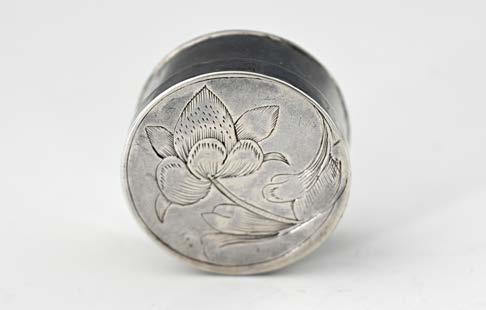
119. A late 17th-century small silver box with pull-off lid, maker’s mark possibly ‘R’, fully hallmarked London 1689, the lid engraved with a stylised plant head, diameter 3.1cm, weight 17g/0.54ozt approx £500 - £800

120
120 Two 18th-century silver tobacco boxes, both oval and with hinged lids, the earlier example, maker’s mark only, Francis Harache, London circa 1755, the cover engraved with the crest, and the base with the arms, of William Wither, circa 1703-1789, of Manydown, Hampshire, length 10cm, the second example James Phipps, London 1781, engraved on the lid with script initials, perhaps RH, below a crest of an arm in armour holding a battle-axe, perhaps for the families of Hagley, Halke, or Hall, and further engraved under the base with script letters, ‘D’ over ‘WW’, above ‘R’ over ‘RH’ and the date 1782, the later box was probably a gift from William Wither, combined weight 317g/10.19ozt approx (2)
£800 - £1,200

121 A 17th-century unmarked silver-gilt box, German, almost certainly Augsburg, circa 1680, the pull-off lid of the box is engraved with an Italianate view of figures in a landscape before a circular Romanesque church, the whole framed with a band of laurel leaves, the box sides engraved with festoons of fruit suspended on ribbons, ‘Michael’ scratch engraved on the base, length 10.9cm, weight 188g/6.04ozt approx
£800 - £1,200

122 A late 17th-century silver cut-cornered rectangular box, maker’s mark only ‘TT’ with crown above, possibly Thomas Tysoe, circa 1680, London, the lid of the box is engraved with scrolling foliage with cupid at the centre a fruit in each hand, below the motto ‘Malgre la Vie’; the base of the box is engraved with an eagle displayed, in one claw a group of arrows, in the other an olive branch, below the motto ‘A la guerre et a la Pais’; the sides of the box plain apart from the owners’ initials ‘G’ above ‘A G’ at the front, length 4cm, weight 29g/0.93ozt approx
£800 - £1,000
123 Two nineteenth-century unmarked silver gilt boxes and covers, engraved with a garter crest and motto ‘Optimum Pati’, possibly for Sheldon, diameter 5.1cm, combined weight 113g/3.63ozt approx (2) £100 - £150

124 University of Oxford interest, a pair of George II silver oval seal boxes, maker’s mark only, Robert Collier, of London, circa 1750, the lids engraved with the arms of the University of Oxford, and one box containing the original wax seal impression with silver thread embroidered blue ribbon, length 9cm, combined weight 141g/4.53ozt approx (2)
Note: these boxes are illustrated in both editions of ‘Silver Boxes’ by Eric Delieb. Delieb, however, mis-attributed the maker in both editions. [Second edition, see p.23, plate 32] “A custom prevailed both at Oxford and Cambridge, in the seventeenth century, if not earlier, to provide the Chancellors with silver boxes containing their personal seals and those of the Universities. But some if not most of these have been melted or converted in to other objects, perhaps cigarette boxes. The only boxes which I have succeeded in tracing so far are a small pair...which contained the seals of the third Duke of Portland, Prime Minister in 1783 and 1803, which are still preserved at Welbeck Abbey. They were made in London in 1792-3 by Peter and Ann Bateman.” (Silver Boxes for the Official Seals of Oxford, 1934) References: Delieb, E. (1979). Silver Boxes. 2nd ed: Ferndale Editions. Silver Boxes for the Official Seals of Oxford. (1934). The Burlington Magazine for Connoisseurs, [online] 64(372), pp.14045.
£1,500 - £2,000
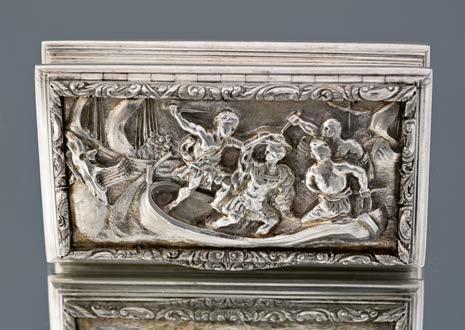
125
125 A William IV silver snuffbox, the lid inset with a cast classical scene in relief, Birmingham, circa 1835, Joseph Wilmore, the maker’s mark struck twice, once apparently over the date letter, length 8cm, weight 135g/4.35ozt approx £500 - £800

126 A George III silver oval snuffbox, London 1772, James Phipps, with gilt interior, the lid inset with a repousse panel depicting Aphrodite and Adonis, both the base and cover fully hallmarked, length 8.8cm, weight 95g/3.05ozt approx £500 - £800
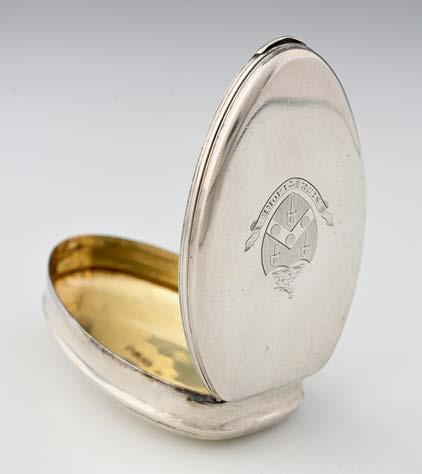
127 A George IV silver oval snuffbox, with bombe sides, London 1822, John Linnit, the lid engraved with a contemporary armorial for a branch of the McCormack family of Scotland and Ireland, length 10.1cm, weight 137g/4.40ozt approx £400 - £600

128
128 An early 18th century unmarked European snuffbox, the exterior cast with a battle scene on the lid and military figures with trophies of war within scroll work on the sides, circa 1710, length 6.5cm, weight 86g/2.76ozt approx £200 - £400
129 Unascribed Colonial, a fiddle pattern caddy spoon, the bowl with a scalloped edge, struck with pseudo London marks ‘IH’ and ‘g’ for 1823, circa 1830, length 8.8cm, weight 28g/0.90ozt approx £60 - £80
130 A George III silver novelty caddy spoon modelled in the form of a right hand with upturned palm, by Joseph Taylor, Birmingham 1808, length 6cm, weight 7g/0.22ozt approx £100 - £150
131 A group of four George III silver caddy spoons, to include an example modelled in the form of a leaf, Thomas Wallis, London 1800, length 10.5cm, together with a scoop example, miss-struck ‘T...’, London 1808, two shell bowls, makers marks ‘IP’, London 1892, and Thomas Wallis, London 1796, combined weight 43g/1.38ozt approx (4) £140 - £180
132 Two nineteenth-century silver caddy spoons, to include a scoop form caddy spoon by Joseph Willmore, Birmingham 1822, and a Victorian silver cast example with scroll finial, by the Lias Brothers, London 1850, combined weight 42g/1.38ozt approx £120 - £180
133 A French silver-gilt tea strainer and caddy spoon, decorated with flowerheads on a stippled ground, both pieces struck with the Minerva mark, length (of caddy spoon) 9.7cm, combined weight 46g/1.47ozt approx (2) £80 - £120

134 A Victorian parcel-gilt silver tea equipage set, comprising bead-edged caddy spoon, sugar spoon, and sugar tongs, London 1868, Henry Holland, in the original case with gilt inscription to Mabel Strey Attenborough from her uncle and godfather 1869, combined weight (sans case) 67g/2.15ozt approx £100 - £150

135
137 An Elizabeth II silver caddy spoon, by A. E. Jones, Birmingham 1971, together with a Keswick School of Industrial Arts spoon, Chester 1928, with a silver spoon with pierced gilt bowl, with pierced-through London hallmarks, combined weight 70g/2.25ozt approx (3) £100 - £150
135 R.E. Stone, a silver caddy Spoon, London 1936, the handle formed as a stylised crown with red enamel, the date 1937 and ‘E VIII’ for the coronation of Edward 8th, together with a bowl commemorating the same event, both pieces engraved with the facsimile signature of ‘R.E. Stone’, diameter of bowl 7.8cm, combined weight 91g/2.92ozt approx (2) £150 - £200 136

136 A. E. Jones, a George V silver Arts and Crafts caddy spoon, with a spothammered fig-shaped bowl, the terminal with applied strapwork and spherical finial, Birmingham 1929, length 8.6cm, weight 19g/0.61ozt approx £100 - £150


138
138 Sandheim Brothers, a silver caddy spoon in the arts and crafts manner, with beaten bowl and interlaced decoration on the handle, Birmingham 1920, length 7.1cm, weight 17g/0.54ozt approx
Note: an identical spoon of this year was exhibited by the Society of Caddy Spoon Collectors and illustrated in the catalogue page 44, ‘The Story of the Caddy Spoon c1775 - 2015’, at the Antiques for Everyone Fair, the NEC, Birmingham 2015.
£150 - £250

139
139. A. E. Jones, a George V Arts and Crafts silver caddy spoon, Birmingham 1919, the spread heart-shaped bowl with spot-hammered decoration, the handle with applied wire-work scroll decoration, the terminal with an applied spherical finial, length 7.2cm, weight 21g/0.67ozt approx £150 - £250

140 Stuart Devlin, a parcel-gilt silver caddy spoon with textured loop handle, London 1975, length 7.4cm, with a fitted box, together with a silver-gilt egg pendant, London 1985, combined weight 43g/1.38ozt approx (2) £250 - £350

141
141 An Elizabeth II silver coffee caddy spoon, pierced for ‘Coffee’, by Annabet Wynaham, London 1988, width 7cm, weight 28g/.9ozt approx £70 - £90

142
142 An eighteenth-century English silver ‘basket of flowers’ mote spoon, with pierced bowl, and barbed terminal, the stem with maker’s mark struck twice, London c.1760, length 12.6cm, weight 10g/0.32ozt approx £170 - £200

143
143 A mid-18th century silver mote spoon, with scroll back, circa 1760, maker’s mark only struck twice ‘FW’ script, or possibly ‘JW’, length 13.3cm, together two other similar examples, combined weight 27g/0.86ozt approx (3) £250 - £350
144 A South-East Asian silver tea strainer on stand, formed as a dragon’s head, apparently unmarked, possibly Malay, length 13.3cm, weight 83g/2.66ozt approx £60 - £80
145 Indian Colonial, a tea or milk strainer, the hinged cover with turned wood finial, the exterior profusely decorated with foliate scrolls, apparently unmarked, diameter 11.5cm, weight 205g/6.59ozt gross all-in approx £140 - £180

146 A Victorian cased silver tea infuser, the pierced body formed in two halves and secured by a central hinge, with gilt interior, also pierced with a cypher, below an earl’s coronet, John Harris, London 1856, length 5.5cm, weight (sans case) 56g/1.80ozt approx £180 - £220

147 A late Victorian silver tea infuser, of ovoid form, the perforated body in two sections, secured by a hinge, and a catch, Atkin Brothers, Sheffield 1899, with suspensory chain, length (of infuser) 6.6cm, together with a German example, marked ‘800’, combined weight 164g/5.27ozt approx (2) £150 - £200
148 A Victorian silver tea infuser, the pierced body formed in two parts, secured by a central hinge, with suspensory chain and hook, John Harris, London 1863, length (sans chain) 7.5cm, together with a Victorian silver tea strainer, Charles Rawlings & William Summers, London 1839, and with another silver infuser, Gorham Manufacturing Co, Birmingham 1904, combined weight 87.6g/2.8ozt approx (3) £320 - £380
149 A Victorian cased silver “Teaette” patent tea infuser, the fitted case with tooled exterior, the cover with “Edith” in gilt lettering, George Gray, London 1892, length 14cm, together with a second silver tea infuser, Hammond, Turner & Sons, Birmingham 1901, combined weight (sans case) 54g/1.73ozt approx (2) £100 - £150

150
150 A Victorian silver “Teaette” patent tea infuser spoon, George Gray, London 1892, length 14.5cm, together with a hallmarked silver “Hinge-Unicus” patent tea infuser, combined weight 57g/1.83ozt approx (2) £100 - £150

151 An American silver tea strainer by Tiffany & Co., circa 1900, length 12.8cm, combined weight 60g/1.92ozt approx £60 - £80

152 Florence Stern, an Edwardian Arts & Crafts silver tea strainer, the perforated base decorated in relief with fruiting vine, the handle with an applied turquoise cabochon, Birmingham 1907, length 13.7cm, weight 35g/1.12ozt gross approx £150 - £200

153 A Scottish silver tea strainer and stand, after a Traprain pattern, Brook and Son, Edinburgh 1937. The base of the stand is struck with the retailer’s name ‘Brook and Son, 87, George Street, Edinburgh.’, the strainer itself is a pierced version of the Traprain dolphin-handled spoon, length 12cm, combined weight 102g/3.27ozt approx £100 - £150
154 Three silver tea strainers, including a George IV example, with cast foliate border, Charles Rawlings, London 1827, diameter 4.9cm, together with a Victorian example, Stokes & Ireland, Birmingham 1884, and an unmarked basket-weave strainer, combined weight 64g/2.05ozt approx (3) £150 - £200

155 Asprey, a silver tea strainer on stand, the perforated bowl section secured by a gimble, with wood handle, hallmarked London 1970, length 15.5cm approx £80 - £120
156 A George V silver patent tea strainer on stand, with articulated arm, Philip Hanson Abbot, London 1912, length 14cm, weight 89g/2.86ozt, together with a plated tea strainer, with sprung articulated arm, length 10.3cm approx (2) £100 - £150
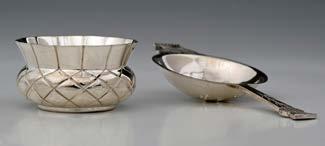
157 R.E. Stone, a silver tea strainer and bowl, London 1946, each piece with Stone’s facsimile signature, the bowl formed as a thistle head, the handle shaped and engraved with thistle heads and the strainer pierced and engraved with the lion rampant of Scotland, length 15.4cm, weight 121g/3.89ozt approx (2) £100 - £150
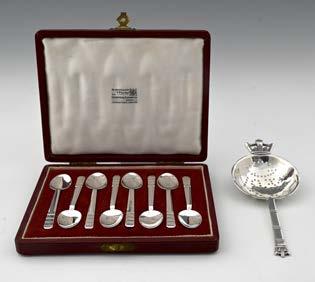
158 R.E. Stone, a Jubilee silver tea strainer, London 1935, the bowl pierced ‘G’ above ‘M’ and ‘1935’, length 14.5cm, together with a cased set of eight coffee spoons, London 1949, combined silver weight 98g/3.15ozt approx £130 - £180
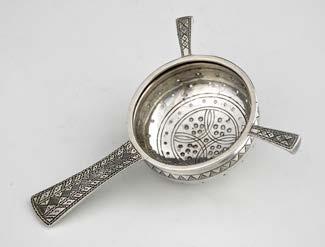
159 Liberty & Company, a George VI silver tea strainer, in the Celtic style, Birmingham 1938, length 11.5cm, weight 61g/1.96ozt approx £120 - £180
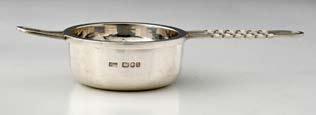
160 Robert Welch, a silver tea strainer on stand, with rope-twist looped handle and pierced base, London 1988, length 14.2cm, weight 98g/3.15ozt approx (2)£120 - £180

161 An Elizabeth II silver tea strainer on stand, with pierced bracket-form handles, sponsor’s mark ‘HH’, Sheffield 1962, length 10.6cm, together with a George V silver tea strainer, Sanders & Mackenzie, Birmingham 1930, height 5.2cm, weight 167g/5.36ozt gross approx £120 - £180

162 Christopher Lawrence, a silver tea strainer with stand, London 1968, length 16cm, combined weight 128g/4.11ozt gross all-in approx £150 - £200
163 A Modernist silver tea strainer, with a pierced bowl, the angular handle inset with looped wire detail, Peter Mason, London 1955, length 13.9cm, together with a silver tea strainer, hallmarked ‘WHI’, Sheffield 1959, combined weight 90g/2.89ozt approx £70 - £90

164 An Elizabeth II silver tea strainer on stand, decorated with texturing, Roger John Squires, Birmingham 1980, diameter of the bowl 6.5cm, length of strainer 14.1cm, height of bowl 3.3cm, weight 97g/3.11ozt approx £70 - £90
165 Three silver-coloured metal tea strainers, each with tripod base, one struck with indistinct marks, possibly Continental, height (of tallest) 6.8cm approx (3) £100 - £150

166
166 A silver cocktail strainer, circular with a coiled wire around, William Suckling Ltd., Birmingham 1958, length 16.9cm, weight 148g/4.75ozt approx £120 - £180

167
167 An eighteenth-century silver strainer, likely for punch, with a perforated base, the affixed clip with loop terminal, the London marks pierced through, diameter 9.2cm, weight 95g/3.05ozt approx £100 - £150

168 Henry William Dee, a Victorian bronze dish, modelled as a grotesque figure, with a hallmarked silver liner, H. W. Dee, London 1878, height 4.5cm, diameter 5.5cm approx £150 - £250

169 A Victorian novelty silver vesta case in the form of a horseshoe, with engineturned decoration, London 1865, Thomas William Dee, engraved on the interior with the retailer’s name ‘Henry Wilson, 60, Pall Mall.’, the exterior of the lid is engraved ‘Mr. & Mrs. F. Garden Campbell’ and ‘To B. Rolfe 1866.’, length 5.2cm, weight 42g/1.35ozt approx £180 - £220

170 A Victorian novelty silver locket formed as a padlock, London 1873, Henry William Dee, when unlocked, the hinged front panel opens to reveal an internal space for two photographs, the base engraved with retailer’s name: John Cooper, 41 St. James St., length (closed) 5.1cm, weight 51g/1.63ozt all-in gross approx £200 - £300

171 Henry William Dee, a Victorian silver novelty case or etui, formed as an anchor, the exterior decorated with arabesque scrolls, London 1869, retailed by ‘Thornhill 144 New Bond St.’, length 13.5cm, weight 120g/3.85ozt gross approx £220 - £280

172 Louis Dee, a Victorian novelty silver jug composed from circles with Georgian coins inset, London 1883, engraved underneath with the retailer ‘Clark, 20 Old Bond Street and 33 New Bond Street.’ height 9.5cm, weight 186g/5.98ozt approx £250 - £350

173 Grand Steeple-Chase de Paris, a Victorian silver and leather mounted tobacco jar with match strikers, London 1875, Henry William Dee, the lid impressed ‘Ventriloque 5 Juin 1876’, and the body impressed ‘Comte L St. Sauveur.’, height 16.5cm approx
Note: this race, first known as the Grand Steeple Chase in this year, with a prize of 30,000 Francs, was won by Ventriloque, owned by the Comte de Saint- Sauveur. The Graphic of 10th June: ‘Hence the Grand Steeple Chase de Paris was run at Auteuil on Sunday last again horresco, or editorially and plurally horrescimus and a good race it was, sixteen foreign and English horses, the latter predominating, coming to the post. Baron Finot Coureuse de Nuit was made favourite, but failed to get a place. Count de St. Sauveur Ventriloque (this is not the French for a oarer gentle reader), but little fancied, was returned the winner, the English horses, Chimney Sweep (an unlucky animal) and Congress, finishing second and third.’
£500 - £800

174 A Victorian novelty cast silver pepper pot, modelled in the form of a medieval knight in full armour wielding a spiked mace, the visor hinges to enable the pot to be filled, the interior and parts of the exterior are gilded, Louis Dee, London 1880, height 10.5cm, weight 168g/5.40ozt approx £600 - £800

175
175 Louis Dee, a pair of Victorian silver cases with suspension chains, Louis Dee, London 1883, retailed by Alfred Clark of 20, Old Bond Street, London, each case is formed as a Japanese Oni mask, double-sided, one case has a blue silk interior purse, the other is fitted out as a blue velvet lined sewing necessaire, with stiletto, crochet hook, thimble and bodkin [unmarked] on one side, and, on the other side, folding scissors with silver handles by maker ‘AF’ [probably Alfred Fridlander] engraved also with Clark, 20 Old Bond Street, a folding silver-sided steel knife and a needle case [each of these unmarked].
Note: Louis and his brother, Henry William Dee, produced some of the most characterful and well-modelled silver in Victorian London. £800 - £1,000

176 A Victorian silver novelty zoomorphic sewing case, and hand mirror, modelled in the form of a dab flatfish, the underside with a hinged cover, inset with a glazed mirrored panel, opening to reveal a lined, fitted interior, containing sewing accoutrements, including scissors, a thimble, pen knife, crochet hook, needle case, and bodkins, multiple pieces engraved with a baron’s coronet, and inscribed, ‘BETTY’, hallmarked to the body, with corresponding part marks struck to the flange on the hinged cover, sponsor’s mark of Louis Dee, London 1881, retailed by ‘Leuchars & Son, 38 & 39 Piccadilly London, & 2 Rue de la Paix Paris’, length 19cm approx £2,000 - £3,000

177 A Victorian cast parcel-gilt silver figural inkstand in the form of a huntsman, London 1879, Henry William Dee, the underside engraved with a registered design lozenge number 344200, engraved on the underside of the cap with the retailer’s address, ‘A. Thomas, 39B Old Bond St.’, the hinged cap secured by a push-button release, opening to reveal a fitted clear glass liner with silver mount, height 10.8cm, weight 610g/19.61ozt gross all-in approx
Note: Possibly modelled after a cartoon of the Duke of Argyll. Henry William and Louis Dee made high-quality silver novelties, including a number in the form of political caricatures. This design was entered by Henry William and Louis Dee of 8, Sherwood Street, on 13 December 1879
£3,500 - £4,500

178. A Victorian cased novelty miniature silver timepiece, in the form of a horseshoe suspended from a stirrup, ensuite with a fitted presentation case, secured by a horseshoe clasp, retailed by Thornhill of New Bond Street London, sponsor’s mark of Thornhill & Co. (Walter Thornhill), London 1879, height (sans case) 4.3cm approx
£200 - £300
179. A Victorian silver-mounted chatelaine compendium with multiple devices - a gimlet, corkscrew, button hook, quill cutting knife and a broader knife blade entitled ‘Princess Maud Knife’, Walter Thornhill, London 1886, length (when collapsed) 6cm, together with a silver etui, makers marks ‘TH’, London 1828, and mother of pearl and silver folding knife, Aaron Hadfield, Sheffield 1842 (3)
£250 - £350
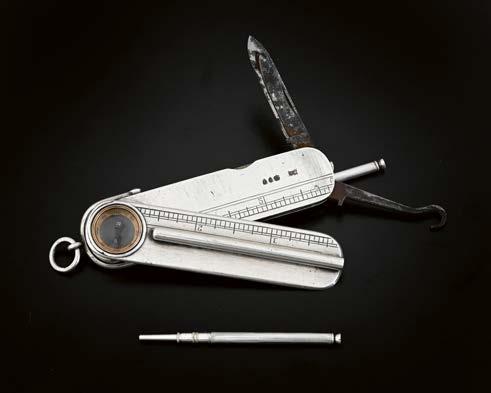
180

181 A Victorian novelty silver table lighter, with vesta tray and spill holder, formed as a ragged boy selling matches standing beside a post box, London 1877, James Barclay Hennell, the hinged lid of the post box is engraved with an inscription ‘Arthur Scott From Yarborough, September 1881. the underside of the rim of the post box lid is also engraved with the retailer’s name ‘ W. Thornhill & Co., 144 New Bond St.’ the paving stone base is engraved with a design registration lozenge and the whole silver scene is set upon a painted ebonised wooden plinth, length of base 16.9cm, height 15.5cm approx
£900 - £1,200

182 An early nineteenth-century silver-coloured metal travelling tooth brushing set, possibly Regency, the tooled red morocco case with three fitted implements, comprising toothpaste box with two hinged compartments, toothbrush holder and tongue depressor/scraper, all implements are engraved ‘Adolpha’, apparently unmarked, length 14 cm approx £150 - £200
180 A Victorian silver combination multi-tool, comprising a rotating rule, with a scale up to six inches, compass, two fold-out knives, button hook, and three propelling pencils, inset with blue, red, and black enamel respectively, with central suspensory loop, Frederick Edmonds, London 1894, retailed by ‘W. Thornhill & Co., 144 New Bond St.’, length when collapsed 8.8cm, length when extended 15.5cm approx
£500 - £800

183 Medical silver, a Victorian silver sick siphon or cobbler’s tube, of conventional form with perforated base, with suspension clip which is fully hallmarked, John Tongue, Birmingham 1851, length 9cm, together with two unmarked examples, combined weight 62g/1.99ozt approx (3) £200 - £300

184
184 An early 19th-century goldcoloured-metal tongue scraper, applied with mother-of-pearl, circa 1835, apparently unmarked, weight 6g/0.19ozt, together with two silver-coloured metal examples, one marked twice, ‘ID’, for John Douglas, circa 1810 (3) £250 - £350
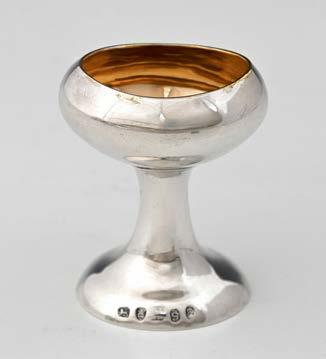

185 Medical silver, a Victorian silver sick siphon or cobbler’s tube, of conventional form with hinged perforated base, the body engraved with a monogram above the date 1863, with suspension clip, length 16.5cm, together with a similar example, also with a hinged perforated base, both apparently unmarked, combined weight 97g/3.11ozt approx (2) £200 - £300

186
186 An unmarked silver feeding tube or straw, circa 1780, with a pierced shellform bowl, probably Spanish colonial, length 13.3cm, weight 46g/1.47ozt approx £70 - £100

187 Medical Interest, an eighteenthcentury George III silver eye bath, the bowl section with flared rounded sides, with gilt interior, atop a spreading oval form foot, with script initials ‘RF’, fully hallmarked to the foot rim, sponsor’s mark slightly indistinct, possibly George Smith & Thomas Hayter, London 1793, height 5.4cm, weight 35g/1.12ozt approx £600 - £800
188 Medical Interest, an eighteenthcentury George III silver eye bath, the bowl section with moulded border, atop a waisted stem, the spreading circular form foot with reeded edge, fully hallmarked, sponsor’s mark possibly ‘IR’, London 1795, height 5cm, weight 25g/0.80ozt approx £600 - £800
189 Medical Interest, an eighteenthcentury George III silver eye bath, the bowl section with flared rounded sides, with gilt interior, atop a waisted stem with reeded collar, the spreading circular form foot with a reeded edge, fully hallmarked to the underside, sponsor’s mark of Thomas Phipps & Edward Robinson, London 1789, height 5cm, weight 27g/0.86ozt approx
£600 - £800
190 A nineteenth-century unmarked silver lancet case, in the form of a tombstone, with an applied cartouche, engraved ‘To WN From RH’, the hinged cover opens to reveal four fitted lancets, length 6cm, weight 48g/1.54ozt gross approx
£60 - £80


191
191 A group of tortoiseshell-mounted folding lancets, eighteenth-century and later, each with a steel blade, likely originally from an etui set (qty) £80 - £120

192
192 A Victorian silver medicine spoon, with graduated opposing bowls, the handle with a contemporary cypher, Thomas Johnson, London 1878, length 17.2cm, 54g/1.7ozt approx
£100 - £150

193
193 A George III silver travelling toothbrush, the hinged foldout handle ensuite with a carrying case with hinged cover, the handle of the brush hallmarked for Richard Lockwood & John Douglas, London 1801, length (when fully extended) 13cm, together with a Victorian silver fold-out dental mirror, John Harris, London 1852 (2) £120 - £180

194 A nineteenth-century French silver-plated wine label, of crescent form, surmounted with a scene of a gentleman at the dining table, circa 1870, length 6cm, and a novelty barrel example, pierced for ‘PORT’, together with a ‘RUM’, ‘BRANDY’, and ‘POTASH’ example (5)
£50 - £80

195
195 Six plated wine labels, pierced for ‘GIN’, ‘HOCK’, ‘PORT’, and ‘RUM’, each with belcher chain, length of larger 6.6cm approx (6) £50 - £80

196
196 A set of eight Old Sheffield Plate crescent wine labels, circa 1790, engraved for ‘Orange’, ‘Currant’, Mountain’, ‘Grape’, ‘Cherry’, ‘Mulberry’, ‘Mead’ and ‘Brandy’, length 4.2cm approx (8) £100 - £150

197
197 A set of four Victorian silver wine labels or bottle tickets, each of shaped cartouche form, decorated with foliate scrolls, incised for ‘CURACOA’, ‘PARFAIT AMOUR’, MARASCHINO’, and ‘ANISETTE’ respectively, each with belcher chain, Samuel Evans, Birmingham 1849, width 5cm, weight 39g/1.25ozt approx (4) £250 - £350
198 A William IV silver wine label, pierced for ‘SHERRY’, by the Barnards, London 1836, length 6cm, with an oval label pierced ‘WHISKEY’ label, by Stokes & Ireland Ltd, Chester 1909, length 4.8cm, and a further oval label pierced ‘ BRANDY’, by Robert Robertson, Edinburgh 1875, length 4.8cm combined weight 45g/1.44ozt approx (3)
£60 - £80


202
202 A pair of George III Scottish silver plain rectangular wine labels, engraved for ‘Gin’ and ‘Brandy’, Edinburgh, circa 1810, MK conjoined, possibly J. McKenzie, length 3.8cm, combined weight 11g/0.35ozt approx (2)
£80 - £120
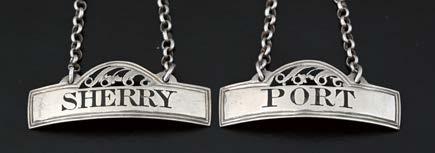
203
£100 - £150
199. A Victorian silver Bacchic wine label pierced for ‘Claret’, London 1839, Sampson Mordan, length 5.9cm, together with a silver fruiting vine ortlabel, possibly by Charles Rawlings, London c.1825, combined weight 49g/1.57ozt approx (2)

200
200. Five Victorian silver die-stamped wine labels or bottle tickets, each decorated with Rococo shells and scrolls, pierced for ‘PORT’, ‘SHERRY’, and ‘MADEIRA’, Charles Reily & George Storer, London 1843-6, width 5.7cm, combined weight 100g/3.21ozt approx
£150 - £200

201
201 A modern silver wine label, engraved for ‘Port’, the top formed as a cast stylised squirrel, London 1972, Catchpole and Williams, length 7cm, together with a ‘Dubonnet’ label, Crichton Brothers, London 1952, and an unmarked pierced ‘Sherry’ and a ‘Whisky’ label, length 7.5cm approx, combined weight 57g/1.83ozt gross all-in approx (4)
£100 - £150
203 A pair of George III silver wine labels ‘Port’ and ‘Sherry’ with pierced arch above, circa 1800, maker’s mark only J.T./I.T., probably John Teare of Dublin, length 4.8cm, combined weight 17g/0.54ozt approx (2)
£100 - £150

204
204. Three nineteenth-century cast wine labels or bottle tickets, each of shaped cartouche form, with gadrooned border, pierced for ‘MOUNTAIN’, ‘MADEIRA’ and ‘PORT’ respectively, with belcher chain, apparently unmarked, width 5cm, combined weight 44g/1.41ozt approx (3)
£100 - £150

205
205 A Victorian Scottish silver wine label, cast and formed as ‘C’ from foliate scrolls, Alexander Graham Wighton, Edinburgh, circa 1860, length 5.3cm, together with two Victorian silver labels ‘C’, and ‘S’, by Rawlings and Summers, combined weight 36g/1.15ozt approx (3)
£100 - £150
206 An eighteenth-century silver escutcheon-shaped wine label, maker’s mark R.P. struck twice, circa 1760, engraved for ‘MADEIRA’ and flat-chased with vine and grape decoration, length 5.5cm, together with two Victorian silver labels for ‘SHERRY’, and ‘CLARET’, combined weight 22g/0.70ozt approx (3) £120 - £150

207
207 Hester Bateman, a George III silver crescent-shaped Red Port wine label, incised ‘R.PORT’, maker’s mark only, London circa 1780, length 4cm, together with a Rawlings & Summers silver ‘PORT’ label, combined weight 17g/0.54ozt approx (2) £120 - £180

208 Hester Bateman, a set of three George III wine labels for Madeira, Claret and White Wine, London, circa 1780, engraved with a crest and the motto Soli Deo Gloria, length 5.1cm, combined weight 32g/1.02ozt approx (3) £250 - £350
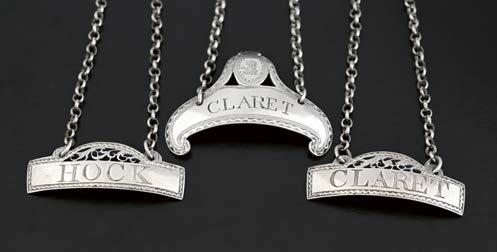
209

210
210 A pair of George IV silver die-stamped wine labels or bottle tickets, each decorated in relief with a fox head and fruiting vine, on a textured ground, with a matt central banner, pierced for ‘PORT’ and ‘SHERRY’ respectively, with belcher chain, Robert Hennell II, London 1826, width 6.5cm, combined weight 59g/1.89ozt approx (2) £120 - £180

211
211 A George IV silver wine label, John Reily, London, 1820, incised ‘Blonde’, with replacement chain, length 3.6cm, weight 8g/0.25ozt approx
Provenance: Ex. Arthur Holder Collection. £200 - £300

212
209 Hester Bateman, three George III silver wine labels, including a pair incised for ‘CLARET’ and ‘HOCK’, and a ‘CLARET’ label surmounted by an armorial crest, length 5cm, all with sponsor’s mark and lion passant, London c.1780, combined weight 27g/0.86ozt approx (3)
£150 - £200
212 China Trade, a ‘Sherry’ Wine Label, circa 1840, maker’s mark only ‘P’, length 5cm, a pair of George III Wine Labels, engraved for ‘Port’ and ‘Madeira’, Birmingham 1816, Matthew Linwood, and a Prince of Wales feathers wine label, engraved for inger-Wine Batemans, London 1804, combined weight 37g/1.18ozt approx (4) £150 - £200

213 Three wine labels or bottle tickets, to include a pair of unmarked silver examples, of shaped rectangular form, incised for ‘Claret 1’, and ‘Malmsey Madera’, respectively, circa 1740-50, length 4.6cm, together with a plated label with bead edge, incised ‘Hammicks Moriles No. 5’, length 5.1cm, weight (sans plated label) 25g/0.80ozt approx (3) £300 - £400

214 A matched pair of modern silver wine labels, engraved for ‘Port’ and ‘Whisky’, with cast and applied tops formed as birds alighting, the Whisky marked for London 1972, Catchpole and Williams, the Port for Mappin and Webb, Birmingham 1972, length 5.8cm, combined weight 40g/1.28ozt approx (2) £50 - £80

215 Sir Henry Edwardes, 9th Baronet [1787-1841], a pair of Victorian cast silver wine labels, pierced for ‘Port’ and ‘Sherry’, formed as the Edwardes family crest, Rawlings and Summers, London 1837, length 5.8cm, combined weight 69g/2.21ozt approx (3)
£700 - £1,000
216 An Edwardian silver bottle stopper, enamelled with a terrier dog in polychrome, John Collard Vickery, Chester 1905, length 7.5cm approx £40 - £60

217
217 A set of three Victorian silver-mounted decanter stoppers, the ring-pull handles incised for ‘GIN’, ‘BRANDY’, and ‘RUM’ respectively, each with bead edge border, Daniel & Charles Houle, London 1865, height 7.5cm approx (3)
£80 - £120
218 A group of associated etui fittings, to include scissors with fold-out finger holes, bodkins, a toothpick, tweezers, eighteenthcentury and later (qty)
£100 - £150
219 An early 19th-century gold-coloured metal pencil holder, circa 1835, length 9cm, weight 5 grams, together with two unmarked gold-coloured metal fob seals, each with a hardstone matrix, the larger engraved, ‘Of all I see, I fancy thee’, the other with three wheat sheaths, combined weight 11g/0.35ozt gross all-in approx
£250 - £350

220
220 A Victorian silver novelty paper knife or letter opener, modelled in the form of a sword, Holland, Aldwinckle & Slater, London 1895, length 13cm, weight 23g/0.73ozt approx
£60 - £80

221 A set of six Victorian silver and enamel teaspoons, each with gilt bowl, and finial decorated with individual flowers in polychrome enamel, Cornelius Desormeaux Saunders & James Francis Hollings (Frank) Shepherd, London 1891/3, length 11.6cm, combined weight 78g/2.50ozt all-in approx £60 - £80
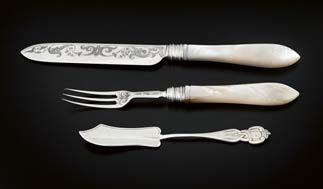
222 A Victorian silver and mother-ofpearl knife and fork set, each with a decorated silver blade, Hilliard & Thomason, Birmingham 1881, length (of knife) 22.5cm, together with an Edwardian silver Coronation souvenir butter knife, Sheffield 1901 (3) £60 - £80

223
223 A pair of Victorian silver novelty pepper pots, formed as croquet balls, John Round, Sheffield 1899, height 3.1cm approx £60 - £80

224 A pair of George V silver pierced servers, Mappin & Webb, Sheffield 1919, length 14.4cm, together with a pair of silver pickle or olive forks, with rope-twist stem, combined weight 94g/3.02ozt approx £70 - £90
225 A late Victorian Scottish horn spoon with unmarked silver mounts, an engraved salmon on the stem and the terminal with an engraved mount with a tag suspended from a ring, the tag engraved ‘With Best Wishes For 1895 and in Recollection of three Pleasant Days on the Tweed’, length 21cm approx £70 - £100
226 A Victorian glass tea caddy. with silver-gilt cover, secured by a screw thread, the faceted glass body inscribed ‘TEA’, Thomas Whitehouse, London 1889, height 9.7cm approx £70 - £90

227 An Edwardian Scottish silver key, ensuite with a fitted presentation case, David MacGregor, Edinburgh 1904, length 11.3cm, weight (sans case) 57g/1.83ozt approx £70 - £90

228 A George V silver combination ruler and letter opener, the rule with a scale to twelve inches, Drew & Sons, London 1913, length 30.3cm, weight 72g/2.31ozt approx £80 - £120
229 Benjamin Smith, a William IV single octagonal trencher salt cellar, with applied shells at each corner below the rim, engraved on the side with a crest and script initials ‘T.A.’, hallmarked London 1835, length 8cm, weight 88g/2.82ozt approx £80 - £120

230
230 A Victorian silver novelty letter opener, modelled in the form of a sword, London 1865, Henry Holland, length 15.1cm, together with a Scottish silver kilt pin, in the form of a sword, Glasgow, 1959, Robert Allison, combined weight 59g/1.89ozt all-in approx (2) £80 - £120

231
231 A pair of unmarked silver and steel dividers with an outer case of silver and brass, the top of the case engraved ‘John Duckworth.’, circa 1790, length of case 6.8cm, length of dividers when extended 10cm approx £80 - £120


232 A George II silver pap boat, with engraved initials to the underside, ‘B B*M’, William Gwillim, London 1736, length 11.2cm, weight 56g/1.80ozt approx £80 - £120
233 An Edwardian wood and silver pepper grinder barrel, John Grinsell & Sons, Birmingham 1903, height 9.4cm approx £80 - £120
234 A small 20th-century silver copy of a 17th-century Cup, London 1935, J.S. Harman, the panels on the bowl engraved, ‘Small Replica of Loving Cup 1656’, and ‘The Frame Work Knitters Company London.’, height 10.8cm, weight 115g/3.69ozt approx £90 - £120
235 Peter and Ann Bateman, a George III silver small-size wine goblet, London 1799, with gilt interior and engraved with script initial ‘JW’, height 10cm, weight 100g/3.21ozt approx £90 - £120
236 An Edwardian silver novelty cricket-themed napkin ring, sponsor’s mark rubbed, Birmingham 1903, height 4.2cm, together with another napkin ring with cricketing interest, Atkin Brothers, Sheffield 1930, and two napkin rings decorated with birds, Walker & Hall, Sheffield 1951, hallmark rubbed, London 1930, combined weight 114g/3.66ozt approx £90 - £120

237 A late Victorian silver mustard pot in the late 18th-century manner, London 1898, John Marshall Spink, overstriking another, the pot is struck with the retailer’s name ‘Spink & Son, London’ and engraved on the front with a crest, ensuite with a blue glass liner, height 9.5cm, weight (sans liner) 122g/3.92ozt approx £100 - £150
238 An eighteenth-century German silver-gilt small funnel, Augsburg 1751-3, maker ‘CW’, the spiral fluted bowl with repousse foliate shells, length 6.5cm, weight 22g/0.70ozt approx £100 - £150
239 A Victorian silver combination seal, and sewing necessaire, the stone matrix cut with gothic initials, the case chased with scrollwork and birds of paradise, the domed hinged cover secured with a catch, opens to reveal an unmarked thimble and spool winder, Thomas Johnson, London 1876, length 7cm, weight 42g/1.35ozt gross all-in approx £100 - £150
240 A silver caster or powderer, of tapered cylindrical form, the pierced cover decorated with a Tudor rose, and secured by a screw thread, apparently unmarked, possibly seventeenth century, height 6.2cm, weight 55g/1.76ozt approx £100 - £200

241 A Victorian silver beaker, the body decorated with foliage, atop a cast and applied foot, Stephen Smith, London 1877, height 6.3cm, weight 124g/3.98ozt approx £100 - £150



242

245
245 A cased pair of late Victorian silver Art Nouveau sardine servers, Henry Wigfull, Sheffield 1901, length 12cm, together with a cased pair of Victorian silver servers, hallmarked London 1898, combined weight (sans cases) 99g/3.18ozt approx (2) £100 - £200
£100 - £150
242 A pair of early Victorian silver peppers, each of vase form with a domed detachable cover pierced with scrolls, ensuite with a crest of an earl’s coronet below A Wolf Rampant Arg., Collared Gu., possibly for the Earl of Arran, with gilt interior, Joseph Angell I & John Angell I, London 1838, height 8.3cm, combined weight 128g/4.11ozt approx (2)

243
243. An early Victorian silver-mounted woven-cane-clad glass flask with integral drinking straw, the silver mount with rotating top, the collar engraved ‘Alfred Seymour’, the silver hallmarked for Charles Rawlings & William Summers, London 1844, height 11.3cm, together with a Victorian silver-mounted glass flask with integral drinking straw, Sampson Mordan, London 1885, height 13cm approx (2)
£100 - £150

244
246 A Victorian miniature reproduction of the Great Paul Bell, formed as a brooch, length 4cm, and a novelty brooch formed as a nutcracker, ensuite with a fitted case, length 4.6cm approx (2)
Note: The Great Paul Bell is Britain’s heaviest swinging bell, weighing 16 ton-14 Cwt. It is in St Pauls Cathedral in London and rings at 1pm every day. £100 - £150

247
247 A pair of nineteenth-century spurs, of conventional form, each marked ‘Peal / Duke St / 876’, and affixed with a silver buckle, sponsor’s mark ‘IC’, London 1835, length 16.3cm approx (2)
Note: Founded in 1791 by Samuel Peal in Wirksworth, Derbyshire, the company gained fame for waterproof footwear. It moved to 11 Duke Street in 1830, later to Oxford and Wigmore Streets. Run by the Peal family for six generations, the business grew through global sales and exposure at horse trials, attracting celebrity clients, including movie stars and royalty. £120 - £180
£100 - £150
244 A Victorian glass jug decorated with turquoise coloured jewels, the body with a central band of etched flowers, and set upon a silver foot, marked for Birmingham 1874, by Hilliard and Thomason, height 6.7cm approx

248 A Victorian silver-mounted jug, with threaded glass body, the hinged cover with pierced thumbpiece, Drew & Sons (Samuel Summers Drew & Ernest Drew), London 1894, height 12.1cm approx £120 - £180

249 An early Victorian silver-mounted stoneware pottery ale jug, set with a hinged lid applied with a cast ram’s head thumbpiece, London 1838, John Wilmin Figg, the top of the lid engraved with a crest of a double-headed eagle, the bulbous body in cream and dark brown, decorated with bucolic figures above a hunting frieze, height 23cm approx £120 - £180

250 A Victorian silver cased tot cup, with gilt interior, London 1888, Stuart Clifford over-stamping another, the cup exterior is engraved as a measure, showing levels for up to 4 Tablespoons and 8 Teaspoons, also engraved with an Earl’s coronet above an ‘R’, ensuite with the original fitted case, height 5.5cm, weight (sans case) 61g/1.96ozt approx £120 - £180

251
251 Two George VI silver serving forks, both with matching crest of a lion rampant, Anthony & Richard Parsons trading as Tessiers Ltd., London 1937, length 13.3cm, together with a serving spoon with forked terminal, Josiah Williams & Co., London 1904, and a serving fork, Walker & Hall, Sheffield 1892, combined weight 144g/4.62ozt approx £120 - £150

252 A cased set of three instruments, comprising compass, barometer, and thermometer in Centigrade and Fahrenheit, the silver compass marked ‘WS’, London 1885, the others apparently unmarked, ensuite in a fitted presentation case, retailed by ‘Ross & Co., Opticians, New Bond St.’, diameter (of compass) 2.6cm, length (of case) 11.3cm approx £120 - £180

253 A pair of cased Victorian silver gilt Bezique markers and cards, the markers hallmarked for London 1896, made for Collingwood of London. Ivory Declaration Submission Reference Number: DCUCPD59 £120 - £180

254 A Victorian silver diamond shovel, engraved “William Boore 54 Strand.”, Stephen Smith, London 1873, length 8.5cm, weight 31g/0.99ozt approx
Note: William Boore was an important 19thcentury dealer in silver, jewellery, porcelain, paintings and other works of art, born in 1818 in Bristol, who took over the premises in the Strand of the uriosity dealer William Forrest. After his death, in 1902, sales of his stock and collection took place at Christie over many days. His daughters donated several pieces to the Victoria and Albert Museum. £120 - £180



255 An early George III silver cream pail, the coopered body with rope-twist swing handle, with script initials ‘OLJE’ or similar, the underside of the base and the handle struck with sponsor’s mark, the handle additionally with the lion passant, John Alderhead, London circa 1760, height (top of raised handle) 8.6cm, weight 64g/2.05ozt approx £120 - £180
256 A George V silver and leathermounted glass spirit flask, Sheffield 1920, William Hutton and Sons Ltd., with integral fitted hallmarked silver beaker, the hinged lid secured with a bayonet fitting, length 19cm approx £120 - £180
257 An early 19th century Spanish unmarked scent bottle, circa 1810, shieldshaped, the border bright-cut and engraved ‘Regimiento de Infantera Inmemorial del Rey n.¼ 1 3rd Batallon.’, height 8.2cm, together with two English silver miniature perfume funnels, Saunders & Sheppard, Chester 1895, and Thomas & James Phipps, London 1816, combined weight 65g/2.08ozt approx
Note: The infantry regiment ‘Del Rey’, the oldest of the Spanish regiments, was named ‘Immemorial’ in 1766 by the King. £130 - £160
258 A George III silver goblet with reeded rim and foot, London, 1800, the maker probably William Frisbee, engraved ‘Omnis feret Omnia Tellus’ within an oval cartouche with bow above, this line from Virgil’s fourth Eclogue was often engraved on prizes awarded by Agricultural Societies of the period, height 13.7cm, weight 158g/5.07ozt approx £140 - £180
259 A Victorian silver mug with glass inset bottom and gilt interior, the rim on the underside marked, ‘Hunt & Roskell 5048’ by John Hunt & Robert Roskell, London 1875, height 9cm approx £140 - £180
260 A Victorian silver prize goblet, Birmingham 1882, by Hilliard and Thomason, in the Aesthetic style decorated with engraved bullrushes and a presentation inscription: ‘Fleet Regatta. Hobart. Commodore’s Cup. Won By 1st Whaler H.M.S. Nelson,’ above a cipher ‘JRO’, height 19cm, weight 149g/4.79ozt approx
Note: ‘On 29th of June 1881, Commodore James Elphinstone Erskine hoisted his pennant at Chatham in HMS Nelson, an armour belted cruiser, and flagship of the Imperial Squadron on the Australian Station. Commodore Erskine arrived in HMS Nelson in Sydney Harbour on 8th January 1882, amid an impending Russian war scare and great jubilation from the citizens of Sydney Nelson then underwent a thorough refit, coaled, provisioned and after an open day for visitors, she weighed and set sail for Hobart on the 11th February.’ £150 - £200
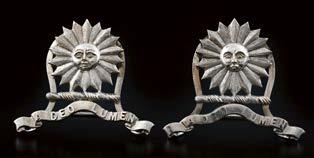
261
261 A pair of Victorian Scottish silver menu holders formed as the crest and motto of the Kerr clan, Edinburgh 1896, by James Aitchison, height 5.5cm, combined weight 62g/1.99ozt approx (2) £150 - £200

262
262 A set of eight Edwardian silver asparagus tongs, Josiah Williams & Co (George Maudsley Jackson & David Landsborough Fullerton), London 1905, length 8.5cm, combined weight 163g/5.24ozt approx (8) £150 - £200
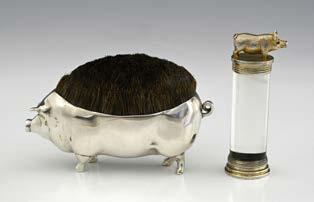
263
263 An unmarked silver and glass desk seal, the top with a cast pig, and the matrix ‘W.W.M circa 1910, together with a large Edwardian silver novelty pen wipe in the form of a pig, with bristle back, London 1903, Goldsmiths and Silversmiths Company, length 11cm approx (2) £150 - £200

264 An Edwardian silver combination page turner, bookmark, pencil, and dip pen, Henry Wells, Birmingham 1903, length 27.5cm, weight 102g/3.28ozt gross approx £150 - £200

265
265 A George V silver Grecian pattern stilton scoop, Goldsmiths & Silversmiths Co., London 1920, length 21cm, weight 106g/3.40ozt approx, together with an American white metal cheese scoop with reticulated mechanism, length 28.3cm approx (2) £150 - £200

266
266 A Victorian novelty silver whistle, modelled in the form of a dog’s head, decorated to simulate fur, George Unite, Birmingham c1860, length 4.5cm, weight 7g/0.22ozt approx £150 - £200

267 A George IV silver-gilt Chinoiserie miniature teapot, or scent bottle, of square form, the exterior with chased foliate decoration, and scroll handle, the hinged cover with cast and applied flower finial, the stopper secured to the finial via a suspension chain, with four bracket feet, Joseph Willmore, Birmingham 1830, height 4cm, weight 36g/1.15ozt approx
Note: A similar example is housed in the collection of the Metropolitan Museum of Art, New York, Object Number: 63.53.20 £150 - £200

268 A Victorian silver ham bone holder, or ‘gigot’, the handle section with bobbin turned finial, the tightening mechanism with screw thread and four-pointed star nut, the component parts all with matching hallmarks, Mappin & Webb (John Newton Mappin), London 1897, length 15cm, weight 115g/3.69ozt approx £150 - £200

269 A pair of late Victorian Scottish silver knife rests, the rest supported by a pair of cast lions rampant, Thomas Ross & Sons, Glasgow 1890, length 9.6cm, combined weight 236g/7.58ozt approx (2) £150 - £250

270
270 Four silver and steel scissor snuffers, to include an eighteenth-century hallmarked example, sponsor’s mark ‘IB’, length 16.5cm approx (4) £150 - £250

271
271. A Victorian silver cheroot case, Birmingham 1865, Frederick Marston, the exterior decorated in relief with flowers and scrolls, on a stippled ground, the central cartouche engraved with an inscription, ‘T. Gilton 23 August 1865’, length 13.5cm, weight 186g/5.98ozt approx £150 - £200

272
272 An early George III silver-gilt swing handle basket, decorated with fruiting vine, the base with a crest with motto above, ‘Deo Juvante’, William Plummer, London 1764, length 15.7cm, weight 146g/4.69ozt approx £150 - £200

273 A cased pair of Victorian silver-gilt napkin rings, London 1899, Goldsmiths and Silversmiths Co., each engraved as a golden wedding present, together with a Scottish napkin ring by George & John Morgan, and a pair of engine-turned napkin rings, combined weight (sans case) 196g/6.30ozt approx £150 - £200

274
274 A George II silver waiter, the border decorated with shells, the base with rococo scrolls and flowers, atop three pad feet, Hugh Mills, London 1750, diameter 16.4cm, weight 226g/7.26ozt approx £160 - £180

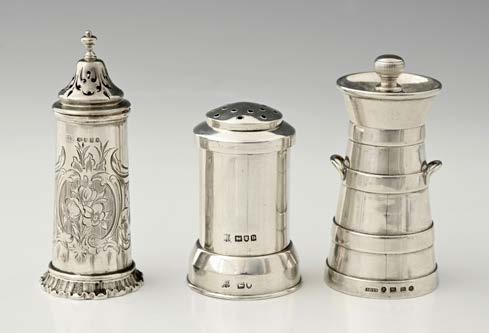
275 A George II silver waiter, with shaped scroll border, the centre with an armorial crest, atop three pad feet, Robert Abercromby, London 1734, diameter 16.1cm, weight 225g/7.23ozt approx £160 - £180
276 A Victorian silver novelty pepper grinder, in the form of a milk churn, John Grinsell & Sons, Birmingham 1886, height 8.7cm, together with a silver pepper grinder, by Gibson and Langman, London 1897, and a Victorian silver pepperette, height 9.8cm approx (3) £160 - £220
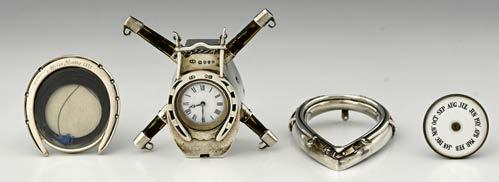
277
277 A Victorian silver novelty clock, modelled in the form of a stirrup and horse harness, disassembled, John Griffiths, London 1882, at fault, height 7.5cm, together with an unmarked small silver frame in the form of a horseshoe, inset with hair, engraved ‘Miss Batty 1871’, length 5.6cm approx (2) £170 - £220

278
278 A Victorian silver collapsible picnic beaker, engine-turned with gilt interior, London 1859, Abraham Brownett & John Rose, height (fully extended) 7.4cm, weight 139g/4.46ozt approx £180 - £220

279 A Queen Anne Britannia standard (0.958) silver dog nose spoon, the back of the terminal engraved with contemporary initials, ‘E B’, Edward Gibson, London 1705, length 20.3cm, weight 57g/1.83ozt approx £180 - £220

280
280 Two early eighteenth-century Dutch silver miniature goblets, each conical bowl decorated with fluting, atop a petal-form foot, apparently unmarked, circa 1720, height (of tallest) 4.1cm, combined weight 21g/0.67ozt approx (2) £180 - £220

281
281. A nineteenth-century Indian colonial silver pap boat, with hinged cover, Hamilton and Company, Calcutta circa 1850, length 12.8cm, weight 240g/7.71ozt approx £180 - £220
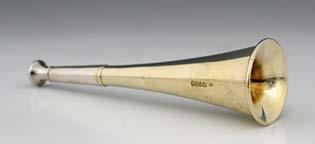
282 A Victorian silver parcel-gilt novelty table lighter, modelled in the form of a hunting horn, Joseph Braham, London 1887, height 19.4cm, weight 127g/4.08ozt approx £180 - £220

283 An Edwardian silver model of a folding campaign daybed, London 1902, William Comyns, ensuite with a later fitted presentation case, length 12.1cm, weight (sans case) 62g/1.99ozt approx £180 - £220

284
284 A Victorian silver-mounted champagne bottle decanter, the glass body with a band of simulated straw work decoration, the silver collar hallmarked John Round, Sheffield 1897, height 32cm approx £180 - £220

285
285 An Edwardian silver novelty scoreboard, affixed with four hooks, below the name ‘Holly Lodge’, ensuite with seven synthetic ivorine tiles, with the numbers, ‘0’, ‘2’, ‘5’, and a double-sided tile, ‘Feb. 11. 1910’, and ‘Well played!’, Thomas Ducrow, Birmingham 1909, height 10cm, width 5.4cm, weight 55g/1.76ozt, together with a novelty ‘go to bed’, modelled in the form of a post box, the interior housing a fitted miniature taperstick, and striker, height 9cm approx £180 - £220

286
286 A George III silver waiter, London 1768, by John Carter, the waiter stands upon three scroll legs with hoof feet and the border is of scrolls interspersed by shells, with a chased border of flowers around the plate, the centre of the waiter engraved with a crest below a viscount’s coronet, diameter 16.8cm, weight 241g/7.74ozt approx £180 - £220
287 An Edwardian silver paper knife or letter opener, the terminal formed as a cast and applied terrier, realistically modelled, the body textured to simulate fur, London 1908, William Hornby, length 24.4cm, together with a hallmarked silver example, pierced with a hunting scene, combined weight 117g/3.76ozt approx (2) £180 - £220

288
288 A George V silver letter opener or paper knife, the terminal adorned with a cast fox head, inset with red glass eyes, Thomas Callow & Son, London 1914, length 25.5cm, weight 100g/3.21ozt gross all-in approx £200 - £300

289
289 An Edwardian cased silver fruit serving set, comprising a pair of servers, each with gilt bowls, together with a pair of grape scissors with integral hook, Sheffield 1905, Hilliard and Thomason, ensuite with an original fitted case for Sharman D. Neill, of 12, Donegall Place, Belfast, By Appointment to H.R.H. The Prince of Wales, case length 26.2cm, combined silver weight 227g7.29ozt approx £200 - £300

290
290 A Victorian silver shaped-oval sugar basin, with hinged handle, and gilt interior, the exterior decorated with stylised floral engraving, London 1883, W & J Barnard, length 17.5cm, together with a matching sifting spoon, combined weight 251g/8.06ozt approx (2) £200 - £300

291
291. A George III silver fob seal, London circa 1780, marked ‘TL’ overstriking another maker (probably Hester Bateman), the matrix cut with a coat-of-arms and motto, apparently for a branch of the family of Holme of Hulme, Lancashire, height 2.5cm, together with an unmarked fob seal, circa 1780, European, the matrix cut with an armorial, and a steel fob seal (3) £200 - £300

292
292 A Victorian silver two-bottle Inkstand, London 1848, Barnard Brothers, engraved with a presentation inscription: ‘Presented to Mr. John Sykes by the Licensed Victuallers Association of Glossop for his valuable services as Secretary to the Society Feby 6th 1850.’, length 20cm, together with a Victorian silver inkstand, London 1883, combined weight (sans glass) 274g/8.80ozt approx (2) £200 - £300

293 A miniature novelty silvermounted liqueur bottle shaped as a Champagne bottle, Vienna circa 1900, by Franz Heid, the body of light green glass, the hinged lid, with internal cork stopper, height 17.8cm approx £200 - £300

294 An Edwardian silver hunting horn, with an affixed central suspensory loop, initialled ‘B.J.W’, the interior of the horn end inscribed, ‘Kohler & Sons, makers (from Covent Garden) 185 Piccadilly. London. W.’, sponsor’s mark of Kohler & Son, London 1907, length 13.8cm, weight 75g/2.41ozt approx £200 - £300
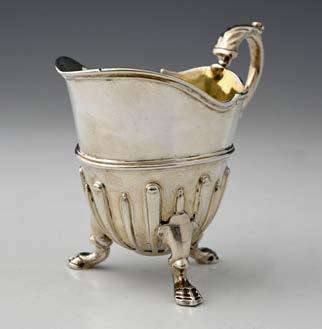
295 A Victorian silver cream jug or milk jug, modelled in the style of the eighteenth-century, the body decorated with semi-fluting, the double C scroll handle with acanthus leaf thumbpiece, atop three hoof feet, with gilt interior, Robert Garrard, London 1849, height 10cm, weight 216g/6.94ozt approx £200 - £300

296 A Victorian silver and glass butter dish, the silver lid with cast and applied finial engraved with a crest and motto for the 2nd Life Guards Regiment, the lid additionally engraved, ‘Purchased at the disposal of the Officers Mess plate 1929’, the silver hallmarked Garrard and Company, London 1882, height 14.5cm, weight (sans glass) 239g/7.68ozt approx £200 - £300

297. A George II silver pap boat, London 1751, the maker in gothic letters, is untraced [see Grimwade mark 3543], the boat is engraved underneath with contemporary owners’ initials ‘T’ above ‘BF’, length 11.1cm, together with a George III silver plain Pap boat, London 1765, attributed to James Waters. Engraved underneath with the owner’s initials ‘A.A.’, combined weight 108g/3.47ozt approx (2)
£200 - £300

298
298 A single pair of cased George V silver ‘Dutch Doll’ sugar tongs, with a painted face in polychrome enamel, the legs closing by squeezing the arms, Cohen & Charles, London 1911, length 12cm, weight (sans case) 84g/2.70ozt approx
Note: The Dutch Doll sugar tongs were inspired by The Adventures of Two Dutch Dolls and a ‘Golli’ by Florence Kate Upton (1895). The characters were staged, with Jessica Black playing Sarah Ann in the 1901 play Katawampus, earning praise for her “wooden” portrayal. In 1905, a Dutch Doll dance featured in The Dancing Doll ballet at the Empire Theatre. £200 - £300

299
299. A George III silver baluster mug, London 1776, Joseph Lock, the mug, with gilt interior, is engraved on the front with the arms of Holland of Plas Cadwgan and underneath with ‘Holland Griffith Esqr, Oriel Coll. Oxford 1776.’ The mug is also engraved on the side with later script initials, height 7.4cm, weight 97g/3.11ozt approx
Note: Holland Griffith, of Llanvethen, the son of John Griffith of Carreglwyd and his wife Mary [Tregarn], heiress of the Griffiths of Berw, inherited his father’s estate in 1776. He had matriculated at Oriel College, Oxford in that same year. This size of mug has been assumed to have been specifically for children or women but it seems likely that such mugs were also used by males for tonics or spirits. £200 - £300

300
300 A set of six Victorian silver miniature nesting beakers, each with a monogram, William Leuchars over-striking another, London 1882, height (of largest) 4.4cm, weight 122g/3.92ozt approx £200 - £300

301
301 An early eighteenth-century German gilt toy ecuelle, without cover, circa 1720, apparently unmarked, length 6.9cm, together with an unmarked silver toy bleeding bowl or porringer, circa 1690, the handle with engraved initial ‘S’, length 5.1cm, combined weight 16g/0.51ozt approx (2) £200 - £300

302
302 A George IV silver toy cream jug, Exeter, 1825, Francis Parsons, height 5cm, weight 17g/0.54ozt approx £200 - £300

303
303 An early 19th century French first standard silver small table bell with wooden handle, Paris circa 1825, by Marc-Augustin Lebrun, height 8.4cm, together with a similar table bell, struck with a Nice hallmark, Southern France, combined weight 260g/8.35ozt gross all-in approx (2) £200 - £250

304
304 George Manjoy, a James II silver miniature or toy shovel, with a twist handle, fully hallmarked to the body, with lion passant struck on the handle, London 1686, length 9.5cm, weight 5g/0.16ozt approx £200 - £300

305 A George II silver waiter, supported on three hoof feet, with a shell and scrollwork border, the centre engraved with a family crest and the reverse with owner’s initials, ‘TL’, by William Peaston, London 1751, diameter 17.2cm, weight 257g/8.26ozt approx £200 - £300

306 A cased Victorian silver two-handled cup, modelled in the early eighteenth-century style, with applied cut-card work style decoration, and gilt interior, London 1884, Charles Stuart Harris, height 10cm, weight (sans case) 253g/8.13ozt approx £200 - £300

307 A cased set of four George V silver menu holders formed as cut-out partridges, Birmingham 1912, Charles and George Hodgetts for Asprey and Company, height 3cm, weight (sans case) 47g/1.51oz approx
£200 - £300

308 China, a set of six Chinese silver tot beakers, decorated with bamboo, on a stippled ground, each struck with a character mark, circa 1900, height 5.6cm, combined weight 214g/6.88ozt approx
£200 - £300

309 An American silver moon face letter opener, George W. Shiebler & Co., c.1910, length 21.5cm, together with a silver naturalistic letter opener, by Asprey & Co. Ltd., and a modernist hallmarked silver example, combined weight 254g/8.16ozt approx (3)
£200 - £300

310
310 A pair of silver circular dishes with gadroon edge, the border composed of wheat ears and vine and grapes overlaying wirework, engraved on the underside with a registered design number and the retailer’s name ‘Carrington & Co., 130, Regent St.’, Martin, Hall & Co., Sheffield 1894, diameter 13.6cm, weight 269g/8.64ozt approx (2)
£200 - £300

311 Two late Victorian silver patent book or page markers, London 1894, Walter Cross, stamped on the inner side ‘Cross’s Patent’ and engraved on the front with ‘R’ below a baron’s coronet, a .Cbelow a baron coronet, the silver clip is applied with a plated spring strip with a wire pin at the end, length 9.7cm, combined weight 19g/0.61ozt gross approx £220 - £280

312 A George III silver chamberstick, the square base with reeded rim, engraved with an armorial crest of a plume of feathers, the loop handle ensuite with the original conical snuffer, Thomas James, London 1805, length 9.4cm, weight 97g/3.11ozt approx £250 - £300

313 Two nineteenth-century candle snuffers, to include a George IV silver example with feathered edge, London 1824, by T. Robins, length 16.9cm, and a silvermounted example, with London hallmarks, sponsor’s mark over-struck (2) £250 - £350

314 An Irish Victorian silver funnel, of conical form, engraved with a double armorial crest, Dublin 1874, J. Smythe, length 10.2cm, weight 81g/2.60ozt approx £250 - £350

315 Police interest, a Victorian silver baluster pint mug, London 1867, Charles Boyton, with gilt interior, the exterior with stylised engraved panels and, on the front, a presentation inscription: ‘Presented to Edward Buss, of the K.C.C. by the Inhabitants of Wingham, in appreciation of his services during the five years he was stationed with them. 1868.’, height 12.8cm, weight 313g/10.06ozt approx £250 - £350

316 A Victorian Scottish silver tea cup and saucer, Glasgow 1857, John Mitchell, the body of both decorated with fluting, the tea cup with a double C scroll handle, diameter of saucer 15.7cm, 326g/10.48ozt approx (2) £250 - £350

317 A Victorian novelty silver condiment set, London 1879, E.H. Stockwell, of naturalistic form, modelled with four eggs, within a fitted stand formed as stylised foliate tendrils, comprising a central mustard pot, and salt, pepper, and cayenne pot, engraved with the crown and initials of the Elector of Hanover, height 8cm, weight 221g/7.10ozt approx £250 - £350
318 Birmingham Assay Office interest, a George III English provincial silver spirit burner and stand, atop four hoof feet, Matthew Boulton & John Fothergill, Birmingham 1777, height 8cm, weight 352g/11.31ozt approx
Note: this piece survives from the early days of the Birmingham Assay Office, after its inception in 1773. The partnership between Boulton and Fothergill ceased upon Fothergill’s death in 1782. £250 - £300
319 An Edwardian silver gyroscopic toasting fork, Edinburgh 1902, Hamilton and Inches, with replacement wooden handle, length (fully extended) 94.5cm approx £250 - £300
320 A Victorian silver-mounted page turner or letter knife, the silver-gilt handle, with writhen fluting and a terminal formed as a collie’s head with collar engraved ‘Jack’, London 1886, with replacement wooden blade, length 38.5cm approx £250 - £350

321
321 A George II silver-gilt cast taperstick, London 1757, William Gould, with a petal base, the gilding probably 19th century, height 12.1cm, weight 125g/4.01ozt approx £250 - £350
322 A Victorian novelty silver-mounted walking cane, the pommel formed as two Oni masks, inscribed “Colonel Thomson . 21. Holland Park Gdns.”, sponsor’s mark, ‘ED’, London 1880, height 90cm approx
Note: Colonel George Cadogan Thomson, 1834-1896.

323 A Victorian silver goblet, and knife, fork, and spoon, London 1865, by Hunt and Roskell, the flatware by Francis Higgins, the foot of the goblet with retailer’s name, ‘Hunt & Roskell, late Storr & Mortimer’ and the pattern number ‘3337’, height of goblet 12.4cm, combined weight 311g/9.99ozt gross all-in approx (4) £250 - £300

324
324 A Victorian silver seven-bar toast rack, atop four cast and applied scroll-form feet, the underside inscribed, ‘Hunt & Roskell late Storr Mortimer & Hunt 5641’, John Samuel Hunt, London 1851, length 16.3cm, weight 303g/9.74ozt approx £250 - £350
£250 - £350 323

325
325 A Victorian silver prize goblet, the stem formed from three rifles with a laurel wreath, London 1862, John Samuel Hunt, the interior of the goblet gilt, the foot rim engraved ‘John Samuel Hunt. John Hunt. Robert Roskell. Augt. 23rd 1860.’, the underneath of the foot rim with a pattern number 1324, height 19.8cm, weight 307g/9.87ozt approx £250 - £350


326
326 A Scottish Victorian silvermounted inkwell, modelled in the form of a snuff horn, atop a turned wood base, the hinged silver cover decorated in relief with thistles, and foliate-capped scrolls, the top inset with a cairngorm, the body applied with a vacant shield-shaped cartouche, the hinged cover opens to reveal a gilt interior, and inkwell reservoir with clear glass liner, sponsor’s mark ‘J.R’, possibly James Rettie & Son of Aberdeen, hallmarked for Edinburgh 1893, height 10.6cm approx £250 - £350


327 A George V silver spirits flask, of cushioned rectangular form, the plain exterior with two sections, the fitted beaker when detached reveals the main body with spout, covered by a cap secured with a bayonet fitting, both sections with corresponding hallmarks, Mappin & Webb, London 1928, length 12.7cm, weight 288g/9.25ozt approx £250 - £300

328
328 A George V silver spirits flask, of cushion form, the base with fitted beaker with a gilt interior, the hinged cap secured by a bayonet fitting, all component parts correctly hallmarked, Robert Pringle & Sons, London 1912, length 14.5cm, 279g/8.97ozt approx £250 - £300

329 Australia, a late Victorian Australian silver spirits flask, of oval form with a squared-off base, the detachable integrated beaker with gilt interior, the body engraved ‘J.F.H / April 10th 1895. / Auf Wiedersehen!’, the hinged cap secured by a bayonet fitting, both sections marked ‘BRUNKHORST’ ‘ADELAIDE’, by August Brunkhorst, Adelaide South Australia, circa 1890, height 12.3cm, weight 163g/5.24ozt approx £250 - £350
330. A European unmarked sealing wax case, circa 1770, length 11.3cm, together with two turned wood mounted hand seals, and three unmarked fob seals, once circa 1700, one with cipher, circa 1750, one with lozenge armorial, circa 1790, and three base metal seals (6) £250 - £350
331 An 18th-century French wine taster, Orleans, 1780, Pierre Caillier, the exterior engraved ‘A Marechal’, diameter 8cm, together with another French wine taster, engraved ‘Francois Perot’, combined weight 282g/9.06ozt approx (2) £250 - £350
332 A late Victorian novelty silver whistle in the form of a bottle, the side of the bottle with an enamel flag with horizontal red and white stripes, London 1893, Gibson and Langman, length 7.4cm, weight 37g/1.18ozt gross approx £250 - £350


333 A Victorian silver sugar basin, London 1873, Robert Garrard, the quilted body with two shaped and embossed escutcheons - one engraved with script initials, height (to rim) 12cm, height (top of handle) 20cm, weight 310g/9.96ozt approx £250 - £350

334
334 A Victorian silver tumbler, London 1872, E.C. Brown, engraved with a wedding presentation inscription below the Mitchell family crest, ‘Ricardo A. H. Mitchell Libertate Decembri Vincula Muaturo Connubialia Prospera Omina AC Felicia Ominatus. D.D. Edmondus Warre. MDCCCLXII.’, height 6.8cm, weight 202g/6.49ozt approx
Note: Richard Arthur Henry Mitchell 1843-1905, born at Enderby Hall, Leicester, was educated at Eton and Balliol and returned to Eton as Housemaster. He was particularly distinguished as a Cricketer. He married, in December 1872, Mary Ley, the daughter of a Clerk to the House of Commons. Their son, Lieutenant Ronald Walter Mitchell of the Buffs was killed in November 1917 in the War. Another son, was Sir Frank Mitchell, who became assistant Private Secretary to George V. £250 - £350
335 Three early Victorian silver castle top pin cushions, one of basket form with swing handle, depicting a view of Windsor Castle, height (of basket) 2.5cm approx, together with a further Windsor Castle thimble, and a castle top cased thimble, with a view of Abbotsford, and two silver thimbles, all apparently unmarked (5)
£250 - £350

336
336 A Victorian silver cream jug, with bead edge border, E. C. Brown, London 1869, height 10cm, together with a Victorian silver double-lipped jug, London 1873, Richard Sibley, engraved with retailer’s name Thomas of 153 New Bond Street, London, combined weight 302g/9.70ozt approx (2)
£250 - £350

337
337 A Victorian silver bowl, with a scalloped rim, atop four lion’s paw feet with mask terminal, the exterior decorated with rococo style shells and scrolls, R & S Garrard & Co (James Garrard), London 1889, diameter 13.8cm, weight 272g/8.74ozt approx
£250 - £350

338
338 A Victorian silver-gilt preserve jar and cover, the pierced body with clear glass liner and matching silver gilt ladle, London 1901, Slater and Holland, retailed by Watherston, height 18.2cm, weight (sans liner) 303g/9.74ozt approx £250 - £350
339 Two eighteenth-century German silver combination pomanders, formed in two parts secured by a screw thread, each with an upper section formed as whistle, circa 1760, height of taller 5.9cm, combined weight 63g/2.02ozt approx (2) £300 - £500

340
340 A small Victorian silver jug, London 1851 by John Keith, the lower part chased with overlapping leaves and engraved on the front with contemporary script initials, height 10.8cm, together with a William IV silver milk jug with gilt interior, London 1835 by Reily and Storer, combined weight 370g/11.89ozt approx (2) £300 - £500

341
341 A set of three Victorian silver elongated shell dishes, each resting on two shell-form supports, London 1885, Thomas of New Bond Street, length 16.5cm, combined weight 363g/11.67ozt approx (3) £300 - £500

342
342 Brian Cain, a silver caster and cream jug, the planished body atop a collet form foot, the underside with signature and stamped ‘DESIGNER’ above, sponsor’s mark Wakeley & Wheeler, London 1954/5, height (of caster) 15.6cm, combined weight 378g/12.15ozt approx (2) £300 - £500
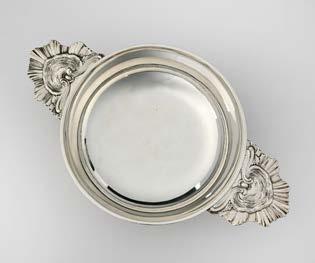
343
343 An ecuelle, in the 18th-century manner, London 1933, L.A. Crichton, the lid engraved with the arms and the base with the crest of Ferguson, with twin handles modelled as rococo shells, diameter 15.1cm, length (across handles) 25cm, weight 435g/13.98ozt approx £300 - £500

344 A Victorian silver novelty letter opener in the form of a Naval Officer’s sword with scabbard, London 1874, E.H. Stockwell, with some parcel-gilding, the sword is locked in place in the scabbard with a hinged flap, length 18.5cm, weight 58g/1.86ozt gross approx
£300 - £500

345

347
347 A Victorian silver milk jug, in the late 18th-century manner, with bead edging and bright-cut decoration, with gilt interior, and the front engraved with a family crest, Robert Garrard, London 1879, height 13cm, together with a Victorian silver milk jug, of ewer form, with gilt interior, and contemporary coat of arms, Benjamin Smith III, London 1837, combined weight 399g/12.82ozt approx (2)
£300 - £500
345. A set of four William IV silver-gilt silk winders, London 1831, Christopher John Buckler, each side is decorated with symmetrical scrollwork against a matted ground and one side with a script reverse cipher ‘JM’ below a baron’s coronet, length 4.3cm, combined weight 60g/1.92ozt approx (4)
£300 - £500

346
346 A George I silver miniature porringer, or small drinking vessel, London 1717, the maker probably John Cowsey, height 2.9cm, together with a George I silver small drinking cup in the form of a porringer, circa 1725 London, maker’s mark only Louis Laroche, combined weight 31g/0.99ozt approx (2)

348
£300 - £400
Note: The exact purpose of these little porringer-shaped vessels remains unclear. It seems unlikely that they were ‘toys’, as produced by the Manjoy and the Claytons. Many are marked by William Fleming, who, like Cowsey, was apprenticed to Nathaniel Locke. Examples have also been noted by James Goodwn [an apprentice of Cowsey], Louis Laroche, and others.
348 A Victorian silver-mounted wooden boot jack, London 1888, John Batson, with a plaque on the upper side engraved with ‘Maude’ and the underside is stamped ‘E. [?] Barrett, Albert Gate, Knightsbridge’, length 31cm approx £300 - £500


349 A pair of George III silver sauce boats, atop three hoof form feet with acanthus terminals, double C-scroll handle, and beaded rim, the body of each with a contemporary armorial crest, Benjamin Mordecai (also known as Mountigue), London 1782, length 16.5cm, combined weight 362g/11.63ozt approx (2) £300 - £500
350 A Victorian silver spirit flask, of rectangular form with rounded shoulders, the body engraved ‘C. Dunlop. / 1st, L.S.’, the cap with integral cork stopper, secured to the body with a screw thread, when released the cap itself converts to a four-drawer collapsible beaker, with registered design lozenge, all component parts comprehensively hallmarked, Thomas Johnson, London 1879, height 11.6cm, weight 133g/4.27ozt all-in approx £300 - £500


351 A Victorian silver and enamel scent bottle or perfume bottle, of heartshaped form, the body decorated with floral sprays in polychrome enamel, initialled ‘H.M.S’ or similar, the cover secured by a screw thread and attached with a suspension chain via a gimble, to prevent the chain being tangled when the cap is unscrewed, with carrying chain and finger loop, Jane Brownett, London 1873, length (of bottle) 8.5cm, weight 72g/2.31ozt approx £300 - £500
352 An early eighteenth-century English silver tea caddy, of octagonal form, the body inset with four glass panels, one engraved with a coat of arms, the underside stuck with a Britannia Standard maker’s mark only, ‘Fo’, for Thomas Folkingham, circa 1720, height 15.2cm approx £300 - £500
353 A Victorian Regimental silver table bell, presented to the 57th Regiment (Middlesex), known as ‘The Die-Hards’, George Unite, Birmingham 1885, height 15cm, weight 246g/8.00ozt all-in approx £300 - £400
354 A Victorian silver-mounted matt basalt Wedgwood jug, the hinged lid with a crest, London 1888, William Leuchars of Piccadilly, London, and Rue de la Paix, Paris, height 18.3cm approx £300 - £500
355 A Victorian Scottish silver bowl, with gilt interior and plain everted rim, and collet foot, the rounded body chased with panels of decoration after the Persian manner, Marshall & Company, Edinburgh 1875, diameter 11.5cm, together with a Victorian silver bowl, hallmarked London 1857, combined weight 359g/11.54ozt approx (2) £300 - £500

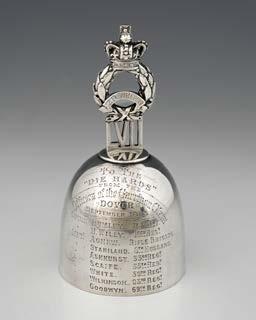


356
356 A George III silver bright-cut sugar basin of helmet form, London 1792, Henry Chawner, the sides with panels containing contemporary crest and script initials ‘JS’, height 9cm, together with a silver navette shape basket with gilt interior, London 1795, combined weight 330g/10.60ozt approx (2) £300 - £400

357

359
359 An early Victorian single silver sauceboat, London 1842, Robert Garrard, atop three cast and applied scroll feet, the side with original crest below an earl’s coronet, the underside with the retailer’s name ‘Garrards, Panton Street, London.’, length 22cm, weight 454g/14.59ozt approx
£350 - £450

360
357 A Victorian frosted silver and parcel-gilt strawberry set, comprising sugar bowl and cream jug, Sheffield 1872, Charles Favell, height (of sugar bowl) 8.8cm, combined weight 354g/11.38ozt approx (2)
£300 - £500

358
358 A George III silver pint mug, London 1776, William Cripps, the body with cartouche, surmounted by a festoon, and banner with motto below, ‘Veritas Vincit’, height 12.5cm, weight 386g/12.41ozt approx £300 - £500
360 A George III matching silver helmet-shaped sugar basin and cream pail, the upper bodies with bright-cut decoration, London 1793, Samuel Davenport, the body of each body is engraved with a contemporary coat-of-arms, length (of sugar basin) 15cm, combined weight 379g/12.18ozt approx (2)
£350 - £450

361
361 A George III silver teapot stand, London 1798, Urquhart and Hart, atop four bracket-form feet, length 18.2cm, together with a George III silver sugar bowl, London 1803, combined weight 417g/13.40ozt approx (2)
£350 - £450

362
362 Two American sterling silver and enamel stamp cases, each modelled in the form of an envelope, made by the Gorham Manufacturing Company of New York, circa 1904, and struck on the inside with a Patent date June 24 [18]90, the exterior of one with enamel stamp and postmarks for 1903 and engraved ‘St. Anthony Hall. the other engraved ‘Ethel Newell Doggett, Fredericksburg, Va.’; the reverse with ‘P.O. 11.12.10 Rec’d’ in enamel, length 3.2cm, combined weight 24g/0.77ozt approx (2)
£350 - £450

363
363 A Victorian silver-gilt pendant, surmounted by an earl’s coronet, containing a photograph of the 13th Earl of Pembroke (18501895), and the reverse with black glass and gold lettering ‘Love, Sincerity, Courage’; ‘Adelaide from Pembroke & Gertrude’ ‘May 3rd 1895’, ensuite with a red leather case with initials ‘G.P.’, sponsor ’s mark of George M. Jackson, London 1895, length of pendant 10cm approx
Note: In 1874 the Earl married Gertrude, third daughter of the Earl of Shrewsbury and this mourning frame was evidently a gift to Adelaide, Countess of Brownlow, Gertrude’s sister. £350 - £450

364
364 A leather nurse’s wallet, ensuite with fittings to include, a thermometer with silver case, an hourglass with silver mount, a hallmarked silver tongue depressor, with initials ‘M.C.L.B’, scissors, & etc., retailed by “Stacy, 4 Newgate St. London”, the silver belt clip with sponsor’s mark of William King Stacey, London 1899
Note: Mary Charlotte Louis Bilney, 1878-1962. At the date of this Nurse’s instrument bag and chatelaine, she was working at the Holborn District Hospital for Sick Children [Great Ormond Street Hospital] £350 - £400

365
365 A set of three George III silver graduated nesting beakers, engraved with Royal cipher and crown, initialled ‘CR’, for Queen Charlotte, with later initials ‘WM’, ensuite with a glass flask, two beakers with rubbed hallmarks, London 1792, the other pieces unmarked, height (of tallest beaker) 10cm, weight 455g/14.62ozt approx £350 - £400


366
366 An early George I Britannia standard silver kitchen pepper, London 1717 by William Fleming, with a removable stepped domed pierced cover, and scroll handle, fully hallmarked to the underside of the base with sponsor’s mark struck to the underside of the cover, height 7.2cm, weight 65g/2.08ozt approx £350 - £450


367 A Victorian cast novelty zoomorphic pepperette, modelled in the form of a seated bulldog, the exterior textured to simulate fur, with a pierced detachable head, fully hallmarked to the body, with corresponding marks struck to the flange of the head, Jane Brownett, London 1889, height 7.5cm, weight 188g/6.04ozt approx £400 - £600

368
368 A Victorian cast silver novelty zoomorphic pepperette, modelled in the form of a seated cat, the exterior realistically decorated to simulate fur, with a pierced hinged head, gilt interior, both the body and interior flange of the hinged cover fully hallmarked, Jane Brownett, London 1887, height 6.2cm, weight 90g/2.89ozt approx £350 - £450
368A A Victorian silver novelty zoomorphic mustard pot, cast and modelled in the form of a standing pig, the hinged cover opening to reveal a gilt interior, ensuite with a spoon with a curly tail finial, atop a wood base with an applied plaque, ‘Rosie Xmas 1880’, the pig hallmarked Jane Brownett, London 1880, the spoon marked for Hukin & Heath, London 1884, length of mustard pot 7.6cm, length of base 10.8cm approx £350 - £450
369 A pair of Victorian cast silver novelty salt and pepper pots, each modelled in the form of a seated child, one laughing and other crying, with hinged bases with retailer’s inscription, ‘Clarke 20 Old Bond Street and 33 New Bond St.’, sponsor’s mark Thomas Johnson, London 1886, height 8.1cm, combined weight 295g/9.48ozt approx (2)
Note: The theme of laughing and crying babies has fascinated artists since the 18th century. Notable examples include a pair of bronze busts by Louis Franois Roubiliac (1702-1762) at the Victoria and Albert Museum and a pair by Adolphe Itasse (1829-1893) shown at the 1871 London International Exhibition. The earliest silver examples may be a pair of condiment shakers, London, 1880, by Robert Hennell & Sons. £900 - £1,200

370
370 A Victorian novelty silver zoomorphic atomiser, modelled in the form of a budgerigar, inset with red glass eyes, the body decorated to simulate feather, Thomas Johnson, London 1882, height 5.1cm, weight 135g/4.34ozt approx £400 - £600

371
371 Two Victorian novelty silver dishes in the form of a swan preening its feathers, London 1884 and 1886, Thomas Johnson, the heads inset with glass eyes, the bodies and wings formed from two cast elements, length 14cm, combined weight 335g/10.77ozt approx (2)
£1,200 - £1,500

372
372 A Victorian silver novelty dish or paperweight, modelled in the form of a bird’s nest, ensuite with four glass eggs, the exterior decorated with foliage to simulate the nest walls, with a weighted base, sponsor’s mark ‘TW’, London 1892, length 9.5cm, height 4.1cm approx
£200 - £300

373
373 A Victorian silver novelty zoomorphic monkey cup, William Leuchars, London 1886, formed as a cast monkey supporting a barrel-shaped cup, initialled ‘RD’, retailed by ‘Leuchars & Son, Paris. London’, height 8.6cm, weight 226g/7.26ozt approx £600 - £800

374
374 An Edwardian novelty silver spill holder in the form of a spherical head, repousse on the front with a troll-like face, the open top inset with a pull-out sleeve with a narrow bar across, engraved ‘Clark, 33, New Bond St.’, marked underneath for London 1903, Alfred Clark, height 7.7cm, weight 224g/7.20ozt approx
£400 - £600

375 A George III miniature silver chess board, with alternating engraved and plain squares, sponsor’s mark ‘IM’, London 1774, length 7.4cm, weight 54g/1.73ozt approx £350 - £450

376
376 A George III silver spirits funnel, with detachable pierced sieve section with clip, William Ellerby, London 1813, length 7.8cm, weight 43g/1.38ozt approx £350 - £450

377 Siege of Sebastopol, a Regimental silver mounted horn flask, Sheffield 1858, Hawkesworth, Eyre & Co., the horn is applied with a plaque engraved ‘Sebastopol Sepr. 8th 1855’ and another with the crest of the 72nd Highlanders, length 32cm approx
Note: the final assault of the siege of Sebastopol took place on the 8th September. The 72nd regiment did not play a major part in the last assault but Captain Cecil Rice of the regiment is recorded as spending that night in evacuating wounded from the trenches. £350 - £450

378 A William and Mary miniature silver mug, fully hallmarked, George Manjoy, London 1689, of cylindrical form with reeded mounts, scroll handle, the body engraved with typical foliate decoration, height 3cm, weight 12.7g/0.40ozt approx
Provenance: Kennard family, ex. Coul Estate
£350 - £450

379
379 Theo Fennell, a pair of novelty silver condiments in the form of cast Scotsman’s legs, with tasselled socks and brogue shoes, London 1998, height 8.9cm, combined weight 373g/11.99ozt approx (2)
£400 - £600
380. A single pair of George I silver candle snuffers, London circa 1720 by Matthew Cooper, the side engraved with a crest, possibly for Walpole, length 14cm, weight 105g/3.37ozt gross all-in approx
£400 - £600

381
381 An early eighteenth-century etui, in filigree silver, now lacking lid, with trailing flowers and foliate tendrils, containing a dog nose spoon, scissors, a knife, and twopronged fork, apparently unmarked, save for the sponsor’s mark of Paul Hanet struck on the spoon, length (of case) 9.9cm approx
See: Grimwade, fig.289 p.158-9, Hanet’s mark first entered in 1721 £400 - £600

382
382 A French first standard silvermounted pepper grinder, in the Empire-Revival style, the cylindrical body decorated with floral garlands, with an engine-turned ground, with three cast and applied hoof-form feet, the top section surmounted by cast putti, the interior houses a Peugeot grinding movement, circa 1900, height 11.5cm approx £400 - £600




383
383 A rare Victorian novelty silver pencil, by S. Mordan and Co., modelled as a carpenter’s plane, with a ring attachment, length (when closed) 5.8cm, weight 14g/0.45ozt approx
Note: this form is illustrated in Bull, K., The KB Collection of Pencils, private publication, 2012, page 116. £400 - £600
384 A Victorian silver adjustable wine bottle holder, with bead pattern decoration, London 1862, George Adams, with removable turned wood base, height (when fully extended) 29.6cm, weight (sans wood base) 320g/10.28ozt approx
Note: bottle pictured for illustrative purposes only. £400 - £600
385 A large Victorian silver caster, heavy gauge, modelled in the early 18th-century manner, London 1875, by F.B. Thomas, with retailer’s stamp under the base for Thomas of 153 New Bond Street, the body of the caster engraved with a family crest, the upper part of the caster pulls away from the base at the moulding above the foot, height 21.2cm, weight 485g/15.59ozt approx £400 - £600

386
386 An Edwardian silver-mounted double letter clip, formed as two cocks, cast and applied to the leather-covered base, London 1907, George W. White & Co., for Ortner & Houle of St. James’s, length 18.3cm approx £400 - £600
387 A Victorian silver coffee percolator, the tapered cylindrical body engraved with an armorial crest of a griffin rampant, with detachable sieve section insert, the detachable cover with bobbinturned finial, Frederick Elkington, Birmingham 1868, height 18cm, weight 482g/15.49ozt all-in approx Ivory Declaration Submission Reference Number: KRG8QTV9 £400 - £600

388
388 The Yorke family, Earls of Hardwicke of Wimpole Hall, Cambridgeshire, three eighteenth-century unmarked silver-gilt hair Lockets, one larger and two smaller, circa 1760 commemorating, the death of Catharine [Freeman], 1716-1759, the wife of the Hon. Charles Yorke, the birth of Philip Yorke, 1757-1834, later the 3rd Earl of Hardwicke, and the deaths of Margaret and Catharine, two daughters of Charles and Catharine Yorke, who died as infants, length (of larger) 7.8cm approx (3) £400 - £600
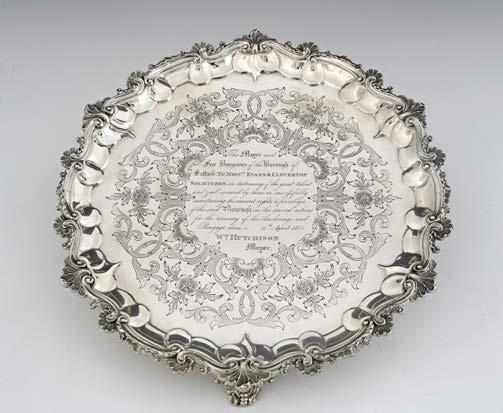
389
389 Saltash, Cornwall interest, a Victorian silver presentation salver, London 1844, William and Henry Paprill, the field of the salver flat-chased with scrolls and flowerheads, the centre engraved: ‘The Mayor and Free Burgesses of the Borough of Saltash to Messrs. Evans & Cleverton Solicitors, in testimony of the great talent and zeal evinced by them in successfully maintaining the ancient rights & privileges of the said Borough in the several actions for the recovery of the Anchorage and Buoyage dues. 11th April 1844. Wm. Hutchison. Mayor.’, diameter 26.7cm, weight 620g/19.93ozt approx

391
391 A Victorian Scottish silver-mounted dirk, Mackay & Chisholm, Edinburgh 1895, the hilt inset with a Cairngorm-type faceted stone, with by-knife and fork, length 42.8cm, together with second dirk with unmarked mounts, and a sgian dubh or skene-dhu (3)
£500 - £800

392
392 A Victorian silver hookah or water pipe base and stem, London 1855, Edward Pairpoint, the body engraved with a crest above the date 12 July ‘64, and with lines on ‘Sublime Tobacco’ from Byron’s ‘The Island’, all component parts duly hallmarked, length 11.3cm, height 12.5cm, weight 169g/5.43ozt approx £500 - £800

393
£450 - £650
Note: this salver is one of two presented to celebrate the defence by the Borough of its rights to dues from Buoyage and Anchorage on the River.
390 A pair of George III silver beef machine brackets by Thomas Heming, 1770, length 20.5cm, combined weight 350g/11.25ozt approx (2) £450 - £550
393 An eighteenth-century novelty cased etui, modelled in the form of a fish, the parcel gilt reticulated body with decoration to simulate the fish’s scales, the hinged head inset with eyes in rubycoloured glass, opening to reveal a fitted interior, ensuite with bodkin, scissors, and a folding pistol-grip handle knife, complete with the original fitted presentation case, with unmarked metal mounts, and applied with a central cartouche in the form of a fish, apparently unmarked, possibly Continental, length 14.7cm, weight (sans case) 42g/1.35ozt approx
£500 - £800



397 An eighteenth-century Spanish silver chalice, of sectional construction, the tapered bowl with central support girdle, and traces of exterior gilding, secured to a central faceted knop stem, atop a panelled stepped foot, the base marked ‘Egularte’, Bilbao, F. Urquijo, height 24.1cm, weight 557g/17.90ozt approx £500 - £700
£500 - £800
394 An Edwardian silver three piece tea set, of unusual design, and diminutive proportions, comprising teapot, milk jug, and sugar bowl, the teapot with hinged cover, and Bakelite spherical finial, each piece engraved with a contemporary crest, Plante and Bannister, London 1906, length (of teapot) 19.4cm, combined weight 530g/17.03ozt gross all-in approx (3)
395 A George III silver-mounted drinking glass, the foot and lower stem hallmarked London 1810, by Robert Garrard, the rim of the foot with Greek-Key decoration, the upper side applied with three ovals containing hair, the enamel border of these with the following in gilt lettering: [1] ‘ELIZ. 27 NOV. O. EDWd. 2 JULY. 5. JULIA 2 OCT. 7.’ (the enamel border in blue) [2] ‘ELIZh. HOWARD. OB. 4 DEC. 1810.’ (the enamel border in black). [3] ‘JULIA HOWARD. OB. 12 JAN. 1808’ (the enamel border in black), height 13.2cm approx
Note: Julia [Juliana] was the daughter of Sir William Molyneux of Willow, Notts., and married Henry Howard of Glossop, Derbyshire, 1713-1787. Julia died in Portugal Street, Grosvenor Square January 13th 1808. Edward Charles Howard, born 1774, was the third son of Julia and Henry. Edward married, on July 12, 1804, Elizabeth (810), the daughter of William Maycock. They had one son, Edward Giles (1805840), and two daughters, Julia (1807856) and Elizabeth (1806835). Edward Howard died suddenly in 1816 at the early age of 42. According to Kurzer, it is reported that, having spent an excessively long time in the steameated rooms of a sugar refinery, Howard suffered a haemorrhage and died shortly thereafter.
£500 - £700
396 A Victorian parcel-gilt silver circular salver, London 1870, George Fox, the central cartouche is engraved in gothic script with a presentation inscription, ‘To Sir William Jenner Bart. With best wishes of his most sincerely T.J. Wynn’, with the baronet’s arms of William Jenner, diameter 24.1cm, weight 635g/20.41ozt approx
Note: T.J. Wynn is likely to have been, the Hon. Thomas John Wynn [1840-1878]. William Jenner, appointed Physician in Ordinary to Queen Victoria, was created a baronet in 1868. £500 - £700

398 A George III Scottish Regency silver wine funnel, decorated with a central band of shells and scrolls on a stippled ground, the detachable muslin ring with gadrooned border, Robert Gray & Son, Glasgow 1819, height 13cm, together with a George III silver wine or liqueur funnel, of conical form, Alice & George Burrows, London 1803, combined weight 145g/4.66ozt approx (2) £500 - £700


399 A Victorian silver novelty spirits flask, modelled in the form of a telescope, the body mounted with shagreen, the base with detachable integrated beaker with gilt interior, the cap secured by a screw thread, with suspensory chains and finger loop, the rim engraved with a registered design lozenge, Thomas Johnson, London 1869, length 10.5cm, weight 148g/4.75ozt gross all-in approx £500 - £800
400 An Edwardian silver desk compendium, of polygonal form, comprising compass, barometer, clock face with Roman numerals, and perpetual calendar with enamelled dial and revolving bezel, John Manger, London 1901, height 7.1cm (a/f) £500 - £800
401 A mid-eighteenth century English tea caddy box, covered in shagreen, with silver mounts, the hinged locking pin marked with the lion passant and obscured sponsor’s mark, atop four ball and claw feet, the hinged cover opens to reveal two faceted glass tea caddies, each with unmarked silver Rococo covers, decorated with scrolls, shells and floral finial, circa 1745, height of box 18.7cm, height of tea caddy 13.3cm approx £500 - £800

402 A Victorian silver bowl, of panelled globular form, the body decorated in relief with foliate tendrils on a stippled ground, atop four cast and applied shell feet, George Maudsley Jackson, London 1893, height 7.5cm, together with a Victorian silver bowl with beaded detail, Joseph & Edward Bradbury, London 1867, combined weight 612g/19.67ozt approx (2)
£500 - £700

403
403 A George III treen and silver lemon or lime squeezer, London 1811/12, Thomas Phipps, Edward Robinson & James Phipps, the hinged mount shaped with goblet outlines, the handles of two different woods, length 24.9cm approx

405
405 An unmarked George II silver tea caddy, circa 1740, the whole engraved with a diaper pattern containing stylised flowerheads, the front of the caddy with a working lock and key, the back with a pseudo key-hole, one panel engraved with a female’s coat-of-arms, of argent a lion rampant, below an earl’s coronet, the other with a script reverse cipher ‘EB’, height 4.7cm, weight 460g/14.78ozt approx
£500 - £800
Provenance: The James Walker Collection of Silver and Vertu, Christie’s South Kensington, 13 July 2006.

404
404 A George II silver kettle stand on flat base, of shaped rectangular form, London 1729, Edward Cornock, the centre engraved with a crest for Upwood of Lovell’s Hall, Terrington St. Clement, Norfolk, length 24.9cm, weight 629g/20.22ozt approx
£500 - £800

406
406 A William III silver tazza, maker apparently over-striking another, London 1701, the underside of the plate engraved, ‘This salver belongs to ye Corporation of Newport, Decmr. 24 1707’, diameter 14.7cm, height 4.6cm, weight 130g/4.17ozt approx
£600 - £800
Note: Thorowgood Upwood, died 1705, acquired Lovell’s Hall through his second marriage. Edward Cornock died in 1734 and is best known for Tobacco Boxes but his mark also appears on a number of salvers and waiters.
£500 - £700
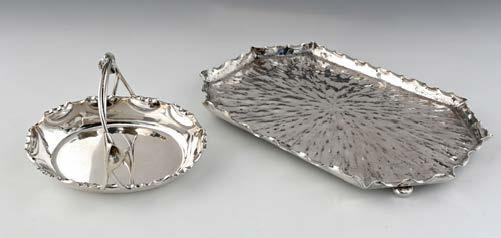
407 A Victorian silver tray, of rectangular form, with a textured base, and naturalistic style crimped rim, atop four ball feet, William Devenport, Birmingham 1897, length 29cm, together with a Victorian silver basket with a similar rim, and fixed handle formed as entwined bifurcated foliate tendrils, James Dixon & Sons, Sheffield 1886, combined weight 755g/24.27ozt approx (2) £600 - £800
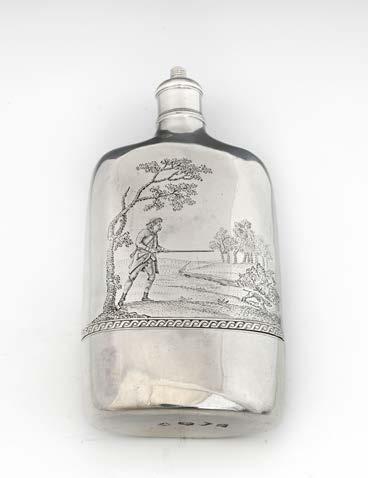
408
408 An early George II silver spirits flask, of rectangular form with rounded shoulders, the base with a detachable beaker, engraved to the front with a gentleman and his hound out hunting in a country setting and decorated with a narrow guilloche band, with a domed detachable screw-on cap, the finial also with a screw thread, which when inverted can be used to screw on to the interior stopper to allow it to be removed, the obverse engraved with a crest of a lion’s head erased, the base of the beaker fully hallmarked, the base of the flask itself with sponsor’s mark, Peter Tabart, London 1727, height 14.5cm, weight 212g/6.81ozt approx
See: Grimwade, p.162, fig.2237, for sponsor’s mark £600 - £800

409 A George III silver large saucepan and cover, the body and cover with an armorial crest of a whippet, with turned wood handle and finial, Walter Brind, London 1789, height (top of finial) 17.5cm, length (to end of handle) 24.5cm, weight 772g/24.82ozt gross all-in approx £600 - £800

410
410 A George I Britannia standard silver Alm’s dish, London 1722, the maker’s mark ‘BE’ with a pellet below and at least one pellet above, the reverse of the dish is engraved, ‘Ex Dono Geo: Turvile Armr. 1724. diameter 21.3cm, weight 242g/7.78ozt approx
Note: George Turvile, citizen and fishmonger, died in March 1735 ‘of a consumptive illness’, apparently without leaving a will. He had inherited considerable property from his father. George Turvile was involved in a court case in 1727 against Stephen Ainsworth, a linendraper, had enticed him with false promises to lay out £4760 in the purchase of South Sea stocks. Turvile was awarded £5600 in damages.
See: Grimwade 3486, the maker’s mark ‘BE’ with a pellet below and at least one pellet above is recorded by Grimwade on a strainer of 1718 and attributed to George Beale. An old paper label pasted on the underside suggests that the maker is James Beschefer but Beschefer’s mark is different. £600 - £800
411 Theft of the Communion plate from the parish church of Hope under Dinmore near Hampton Court Castle, the remains of the Communion plate, apparently unmarked, likely seventeenth and earlyeighteenth century, preserved by the owners of Hampton Court Castle in a cardboard handkerchief box, the underside inscribed, ‘Pieces of old Church Plate belonging to Hope Church - and recorded after being carried off by thieves. An account of the robbery is given in an old book belonging to the parish preserved in the parish chest (oak box with two keys)’, weight 409g/13.14ozt approx
Note: Hampton Court Castle was owned by the Coningsby family from 1510 until 1781, when it was inherited by George Capel, Viscount Malden, son of the 4th Earl of Essex. £300 - £500


DAY TWO
Tuesday 10th June 2025 at 10:00


412 A George III vase-shaped Argyle, London 1787, Daniel Smith & Robert Sharp, the side engraved with a coat-of-arms and the lid with a crest, with wood handle, height 19cm, weight 536g/17.23ozt gross all-in approx £600 - £800 413

413 An early eighteenth-century English silver-gilt spoon tray, London, circa 1710, of oval form with scalloped rim, the underside struck with a maker’s mark only for Edmund Pearce, struck four times, length 17cm, weight 107g/3.44ozt approx £600 - £800 414

414 Two late 19th-century cases, one containing a scent bottle, each covered with shagreen and mounted in unmarked silver in the 18th-century manner. European circa 1890, length (of longest) 12.5cm approx (2) £600 - £800

415 A George II silver teapot, the upper body chased, and the lid applied with an acorn finial, the panels on each side are engraved with the arms and crest of Eliott, with wood handle, hallmarked to the underside of the base, struck twice with the lion passant, Isaac Duke, London circa 1745, height 15.5cm, weight 550g/17.68ozt gross allin approx
Note: research undertaken by Peter Cameron indicates only a small number of pieces marked by Duke are known, particularly noted for sauce boats. £700 - £900
416 A George III silver censer, London 1789, Charles Kandler II, of ogee form, with a detachable pierced cover, atop a stepped spreading circular form foot, height (to top of cover) 19cm, weight 602g/19.35ozt approx
£700 - £900

417
417 A George III silver quart mug, London 1772, Charles Wright, of baluster form, the handle with acanthus leaf thumbpiece, the body engraved with contemporary initials ‘BMK’ above later script initials ‘AMK’, height 16cm, weight 645g/20.73ozt approx
£700 - £900

418
418 West Indian Interest, a George III travelling inkwell with pounce pot and sander in the base, the base is engraved; ‘’The Gift of Samuel Kirshaw D.D. to Thomas Cockburn Esqr. in Acknowledgement of his Good care of his Affairs in Jamaica 1770.’, apparently unmarked, height 8.7cm approx
Note: Dr. Samuel Kirshaw was the son of Dr. Richard Kirshaw, educated Katharine Hall, Cambridge, B.A. 1727, M.A. 1731, D.D. 1740. 1736 succeeded his father as Rector of Ripley, Yorkshire; elected Vicar of Leeds in 1746 but litigation over the election prevented his taking up the post until 1751. He died, aged 80, in 1786. Thomas Cockburn was a lawyer in Jamaica - who evidently acted on behalf of Kirshaw in the island. £700 - £900

419 A George V silver muffin dish, London 1913, Carrington and Company, of octagonal form, the detachable cover with knop finial, the interior houses a removable liner insert, the underside of the rim of the base engraved, ‘Presented to Lady Delia Spencer on her Marriage to the Ho. Sidney Peel February 18th from the Household at Althorp.’, length (across handles) 26.4cm, height (top of finial) 12.5cm, weight 915g/29.41ozt approx
Note: Lady Adelaide Spencer (1889 - 1981), was the great aunt of Diana, Princess of Wales. Carrington and Company were awarded the Royal Warrant by Queen Victoria and subsequently the warrants of Prince Albert, Edward VII and George V, as well as Nicholas I and II and Queen Alexandra of Russia. £700 - £900

420
420 A Louis XVI silver coffee pot, Avignon, circa 1775, JeanPierre Violet, the pot is engraved with a coat-of-arms for Jacques de Tardivon, atop three cast and applied pad feet, the hinged cover with knop finial, the side-pouring turned wood handle, the socket with cutcard work, height 26.2cm, weight 929g/29.86ozt approx
Note: Jacques de Tardivon [1714-1791], who was, in 1761, elected abbot and head of the order of canons of Saint-Ruf de Valence. This order of canons was transferred in 1773 to the order of Saint-Lazare and the estates of the old order were secularized. As former abb, de Tardivon was given the title of ‘Commandeur-Princier’ of the order of Saint-Lazare and the arms of this coffee pot reflect that new title and perhaps also the compensation received by the abb on the abolition of his order. The coronet used in the arms is most unusual: the only other use of a similar coronet being in the new arms of the city of Versailles adopted during the French Revolution. As a young officer in the army, Napoleon was given letters of introduction to de Tardivon on being posted to Valence in 1789. £750 - £950

421 A late Victorian silver-gilt two-handled cup and cover, in the early 18th-century manner, the body and lid ornamented with strapwork formed as alternating asymmetrical scrolls and leaves, the foot and lid with floral scrolls against a textured ground, London 1891, Aldwinckle and Slater, engraved under the foot with the retailer ‘Collingwood & Co. 46 Conduit Street, W.’, height 25.5cm, weight 1,083g/34.81ozt approx £800 - £1,200

422
422 A seventeenth-century German silver stirrup cup, Augsburg, circa 1685, Matthus Baur II, engraved with three vignettes of landscape scenes within scrolling foliage and with a classical male and female head at each end, struck also with a nineteenth-century control mark, with gilt interior, length 13.4cm, weight 83g/2.66ozt approx £800 - £1,200

423
423 A George III silver neoclassical salver, with shaped beaded border, atop three ball and claw feet, London 1774, John Carter, engraved with a coat-of-arms, probably for a member of the Bacon or Bore families, diameter 29.8cm, weight 970g/31.18ozt approx £800 - £1,200

424
424 Ireland, a George III Irish silver two-handled cup, Dublin 1770, Charles Townsend [Freeman in that year]. The foot of the cup with vertical fluting and the lower body chased with vertical gadroons below a beaded festoon with shells and four shells below bold floral festoons to the upper convex body. Around the body, is engraved: ‘The Gift of Mrs. Susannah Drought to her Great Grand son & Godson Francis Mooney Enraught Esq.’ The upper body is engraved with a crest on each side for Drought [a rainbow] and Mooney-Enright, height 24.5cm, weight 1,123g/36.10ozt approx £800 - £1,000

425
425 A large George III Scottish silver flask, with detachable gilt-lined beaker, the flask is engraved with the crest and arms of William Thomson Honyman, 1797-1828, and underneath with a presentation inscription: ‘To W. Thomson Honyman Esqr. of Mansfield, from his Affectionate Wife C. Thomson Honyman Jany 4th 1819.’ William and Patrick Cunningham, Edinburgh 1818, length 23.6cm, weight 770g/24.75ozt approx

427
427 City of London interest, a George III silver salver, Ebenezer Coker, London 1766, engraved with a coat of arms and presentation inscription, o Thomas Baynham Esq. Barister (sic.) at Law, this waiter is presented by Arthur Beardmore as a small token of gratitude for pleading his cause and that of his clerk David Meredith against the Earl of Halifax then Secretary of State for false imprisonment under his warrant commonly called a Secretary of State Warrant that canker of English liberty MDCCLXVI atop three ball and claw feet, diameter 31cm, weight 918g/
£800 - £1,000
Note: William Thomson Honyman died in Naples in 1828. As William Honyman, of Smyllum, Lanarkshire, he had married Catherine Thomson, the daughter of Andrew Thomson of Mansfield and Castlemains, in 1815. His wife had inherited these properties from her father upon his death in 1806 and Honyman added the name Thomson to his own.

426
426. An early 18th-century French provincial silver ecuelle, Angers circa 1723, Laurent Daller, the bowl engraved with the name Claude Corneau in a baroque cartouche and, underneath, with a late 19th-century cypher and coronet, length across handles 29.6cm, diameter 17cm, weight 479g
Note: Arthur Beardmore, a radical City of London politician, newspaper editor and lawyer. This salver, one of seven presented by Beardmore to the members of his legal team, commemorates his release, together with his clerk, David Meredith, after being arrested and imprisoned by the Secretary of State, Lord Halifax for publication in the ‘Monitor’ of articles on Lord Bute and the Princess Dowager. £800 - £1,000

428
428 A William IV hallmarked silver four-section, three-draw, telescope, maker Edward Wrench, 6 Grays Inn Terrace, London, the leather-covered barrel with lens cap, the eyepiece with sliding cover, the silver hallmarked London 1837, sponsor’s mark ‘MH’ incuse, length (fully extended) 100cm approx £900 - £1,200
£800 - £1,000
Note: Laurent Daller was active as a silversmith in Angers 1701-1728. A Claude Cornau, ‘traiteur’ was born in Angers in 1676 and died there in 1753. His father, also Claude, died in 1720. The pattern used for the handles of this ecuelle was still being used in Angers in the second half of the 18th century [see an ecuelle by Guillaume-Ren Hardye of 1760, illustrated in ‘Les orfvres d’Anjou et du bas Maine’, p. 450.]”

429
429 A pair of George III oval silver salvers, London 1794, by Robert and Thomas Makepeace, the borders and the feet with gadroon edging, the centre of each salver with a contemporary engraving of a coat-of-arms in a lozenge for Taylor White II of Wallingwells, Nottinghamshire, length 27.2cm, combined weight 1,374g/44.17ozt approx (2)
430 A George III silver gadroon-edged meat dish, London 1815, Willam Stroud, of oval form, engraved with a coat-of-arms for John Heathcote of Conington Castle, Huntington (1767-1838) and his wife Mary Ann (Thornhill), the reverse engraved ‘Bought with a Legacy bequeathed by my Aunt, Lady Hamilton’, length 41.8cm, weight 1498g/48.16ozt approx
Note: Anne Heathcote, (1729-1816), third daughter of Sir John Heathcote of Normanton, Bart., married Sir Robert Hamilton 4th Bart of Silvertonhill on 6 Feb 1778. General Sir Robert Hamilton died in 1786.
£1,100 - £1,500

431
431 China, a pair of late nineteenth or early twentiethcentury Chinese silver dragon bowls, each applied with three cast dragons, the panelled body decorated with vignettes of traditional scenes, on a stippled ground, one bowl with the rim engraved, ountry Club Squash Racquets April 1899 J. R. H. the underside marked Cand with artisan chop mark, Hung Chong & Co., Shanghai, upon hardwood stands, diameter 14.5cm, height 7.6cm, combined weight (sans stand) 641g/20.60ozt approx (2) £1,100 - £1,300
£1,000 - £1,500
Note: Taylor White died in 1795 and the lozenge suggests that the arms are either those of his widow, Sarah White, who died in 1802, or, more likely, his unmarried daughter, also Sarah White, born in 1769 and died in 1827. Taylor’s wife was the daughter and co-heiress of Sir Isaac Woollaston and was therefore entitled to show the Woollaston arms on her shield. Robert Makepeace II entered the mark in partnership with his brother, Thomas, on 8th January 1794 and remained in partnership with him for just over a year until 20th January 1795.


432
432 A Victorian silver revolving serving dish, London 1877, by Martin, Hall and Company, engraved with a contemporary crest, with bead edge, atop four Neoclassical style paw feet, height 18.5cm, length 27.5cm, weight 1,299g/41.76ozt approx Ivory Declaration Submission Reference Number: BA1ADXVM
£1,300 - £1,500

433 The Marquis of Waterford, a Victorian silver coaching horn, in presentation case, London 1838, William Fitchew, the horn engraved, ‘The Marquis of Waterford to his GUARD, J.L.W.’ and with double crest, the stem of the engine-turned horn also engraved with a spiralling band of coaching scenes within oak leaves, the largest of the coaches with a coat-of-arms on the door and a coachman blowing his horn on top, the presentation case with a silver plaque engraved with the names ‘J.L. Wellesley’ above a double crest and ‘12th Royal Lancers.’, case dimensions 71.3x10.9x9.8cm, length (of horn) 65.12cm, weight (sans case) 222g/7.13ozt approx

434
434 A pair of early George III cast silver candlesticks, of knopped baluster form with gadrooned rims, and petal base, engraved with a coat-of-arms, both with a duly part-marked detachable sconce, Frederick Kandler, London 1764/5, height 27cm, combined weight 1,318g/42.37ozt approx (2)
See: Jackson’s p,197 for sponsor’s mark
£1,500 - £2,000
£1,500 - £2,000

435
435. A pair of early Victorian silver fluted sauce boats with applied leaf decoration, London 1839, Robert Garrard, each with a scroll handle with acanthus leaf thumbpiece, atop three cast and applied scroll-form feet, engraved under the lip with a coat-of-arms, crest, and motto, for William Foster of Norwich, length 21cm, combined weight 1,221g/39.25ozt approx (2)
Note: William Foster of Norwich, 1798-1874, created a baronet in August 1838, who married Mary Anne, daughter of Starling Day, 1821. The Fosters were prosperous solicitors in Norwich.
£1,600 - £2,000

436 A George II silver cup and cover, London 1752, by James Shruder, the lid surmounted with the crest of Onslow, (an eagle attacking a partridge), the lid and body engraved, on opposite sides, with the arms of Onslow and Bristow in pretence, and with the script cipher ‘T.S’, each engraving set within a rococo cartouche, the underside of the foot and the interior of the lid rim are engraved ‘Thos. Smith, Westr.’, scratch weight of 77ozs 9dwt Is engraved under the foot, the twin double C-scroll handles surmounted by an acanthus leaf thumbpiece, height 31cm, weight 2,405g/77.32ozt approx
Note: this cup was evidently made as an heirloom by Thomas Smith, then a Chief Clerk at the Exchequer Office, after the death of his wife, Martha Bristow in May 1753. The Cup is mentioned by Thomas Smith, in his will, written in 1754, as having been given by him to his eldest son, Thomas Onslow Smith, then an infant, together with his ‘Mourning Diamond Ring’ and ‘Cricket Picture’. Thomas Onslow Smith also received his father’s silver and gold repeating watches. He was subsequently apprenticed to a Grocer (1761) and became free of the Grocer’s Company, trading as a Corn Factor in the City of London. He died intestate in September 1793. The marriage between Thomas Smith, then probably living in Charles street, Westminster, and Martha Bristow was recorded in the newspapers. The St. James’s Evening Post of July 11th, 1745, announced ‘On Thursday last, Thomas Smith, Esq.; one of the Chief Clerks of the Exchequer, was married to Miss Bristow, Daughter of Mrs. Bristow, of Charles-Street, Westminster; a beautiful young Lady, with a considerable Fortune.’ £2,000 - £4,000

437 Royal Eisteddfod, Denbigh, a George IV ‘Hirlas’ or drinking horn with silver mounts and hinged silver cover, London 1828, Emes and Barnard, the applied silver rim is engraved “ Presented by the Cymmrodorion in Gwynedd, to Richard Phillips Jones M.D. for his unwearied exertions in promoting the Royal Eisteddfod, held at Denbigh, 1828”, a silver plaque on the horn is engraved with an armorial for Dr. Richard Phillips Jones, ensuite with the original fitted wooden box, but now lacking the stand for the horn, length 42cm approx
Note: the horn was made to the design of the Medalist, David Ellis of John Street, London, as a presentation piece for the Honorary Secretary of the Committee of the Denbigh Eisteddfod, Dr. Richard Phillips Jones, for his work in promoting the festival. David Ellis designed and made a number of other Eisteddfod silver medals, harps and a cup and cover.
£2,000 - £4,000

438 Paul S torr, a pair of George III silver sauce tureens, London 1798, engraved with contemporary arms and crest for the Venerable Anthony Trail, each of navette form with gadrooned border, height 14cm, length (across handles) 22.7cm, combined weight 1,296g/41.66ozt approx (2)
Note: the Venerable Anthony Trail [1755-1831],, Archdeacon of Connor, and Chief Clerk to the House of Lords in Ireland, who purchased Balylough estate, near Bushmills, in 1789.
£2,500 - £3,500

439
439 A set of six Victorian silver napkin rings, each decorated in relief with flower, shells and scrolls, on a stippled ground, Josiah Williams & Co., London 1900-1, length 5.1cm, combined weight 196g/6.30ozt approx £150 - £200

440
440 ‘The Oxford Jug’, a Victorian silver slender narrow jug, London 1888, J.N. Mappin, with a weighted base, in imitation of a 14th-century pottery jug of a type found in the Oxfordshire area, height 17.4cm approx
Note: the Goss pottery also made versions of ‘The Oxford Jug.’ £150 - £200
441 A Regimental table lighter in the form of a flaming grenade, the whole pivoted on a silver-mounted horn handle, Sheffield 1933, Walker and Hall, engraved on the front:’ 1933 Presented by Captain H. Percival, Capt. N.A. Barber, Capt. W. Sprouse, Capt. J.C.B. Stephens.’, engraved above this inscription with the badge of the Royal Army Service Corps, East Lancashire Division, length 43.5cm approx
£300 - £500

442
442 Taunton, a seventeenth-century English provincial silver beaker by Thomas Dare junior, circa 1675, the body with a band of floral decoration below the rim, marked underneath with the Taunton ‘T’ and ‘Tun’ mark and the Dare’s maker’s mark several times., engraved with owner’s initials lightly on the base, height 9.9cm, weight 110g/3.53ozt approx
Note: The Ashmolean Museum, Oxford, has a drawing in pastel and black chalk, almost certainly of Dare, in its collection [WA1940.50].
A number of spoons by the Dare family survive but beakers and other hollow-wares are much rarer. Kent illustrates two beakers, two porringers and a wine-taster, formerly in the collection of G.S. Sanders but subsequently purchased by the Taunton museum, as well as a small wine cup on trumpet foot.


443. Thomas Heming, Principal Goldsmith to the King, a pair of George III silver meat dishes, of shaped oval form with gadroon borders, London 1773, the dishes are engraved with a crest below a baron’s coronet for Peter King [1736-1793], 6th Baron King, length of dish 47.8cm, combined weight 3,735g/120.08ozt approx (2)
£2,500 - £3,500
See: T.A. Kent, ‘When Goldsmiths Dare, published by the Silver Society in ‘The Proceedings of the Silver Society’, Autumn 1984, pp8287, for the remarkable life of this silversmith. Kent tells the story of how Dare, prosecuted for his seditious remarks against the King, was imprisoned in February 1680 but later escaped and fled to Holland where he was given charge of the Duke of Monmouth’s finances and he returned to England with the Duke’s forces in 1685 -only to be shot in a quarrel over a horse.
Note: Peter King married Charlotte, daughter of Edward Tredcroft of Horsham in 1774. These dishes formed part of an extensive dinner service purchased, presumably after his marriage, by Lord King from Heming in 1773.
£2,800 - £3,200
444 A pair of George III cast silver neoclassical candlesticks, each with angled trefoil base, the central column with ram’s heads joined by foliate garlands, flanked by hoof form supports, decorated with Greekkey, acanthus, laurel and bead, the base with vignettes with an oval boss surmounted by festoons, one engraved with the coat of arms of Saltram, the Earl of Morley, John Carter, London 1771, height 31cm, combined weight 1,789g/57.51ozt approx (2)
Note: sold by descent at Sotheby’s London, 19/01/1956, lot 157, one stick illustrated in V. Brett, ed. Sotheby’s Directory of Silver 1600-1940.
£3,000 - £5,000

445 A pair of George II silver candlesticks, London 1734, John Jacob, the bases are stepped with a deep reverse ogee between two convex mouldings, the lower deeper and the upper narrower, the upper flat surfaces of the bases are flat-chased with four female masks within scrolls and stippled panels, the baluster stems are capped at the shoulders with stylised leaves. Each stick is engraved within the well of the base with a reverse script cipher ‘R’ below a baron’s coronet, with later Victorian silver nozzles by Robert Garrard, height 24cm, combined weight 1,725g/55.46ozt approx (2)
Note: Portraits of John [Jean] Jacob and his second wife survive and are now part of the collection held by the Huguenot Museum London. Relatively few pieces struck with Jacob’s mark survive. It seems likely that Jacob began as a working silversmith and later became a retailer. This particular form of candlestick is most unusual and seems to have been particular to Jacob.Two other pairs are known and each is marked for 1734. One pair has a domed centre between the base and the stem, whereas this pair and the other pair have a sunken well which rises conically into the stem. The chased female masks on the upper side of the bases on these candlesticks has not been noted on any other pair. These sticks were produced without nozzles (nozzles began to be made from the later 1730’s) but the later associated nozzles, albeit with worn maker’s mark, can be identified as having been supplied by Robert Garrard in 1838

£3,000 - £5,000


446 Clan Crawford interest, a George III silver soup tureen, by Robert Sharp, London 1788, ensuite with a liner hallmarked London 1792, sponsor’s mark possibly ‘IF’ or ‘IE’, of oval form, with gadrooned border, atop a spreading stepped collet foot, the twin handles with acanthus leaf surmounts, the detachable cover with a naturalistic loop handle formed as a foliate tendril, the base and liner each engraved with a coat of arms and motto, utum te robore reddam(With my strength I’ll give you safety), possibly that of the Craufurd/Crawford family, very similar to the Renfrewshire-based branch at Auchinames, the cover with matching crest, height 33.5cm, length (across handles) 35.5cm, weight 4,419g/ 142.07ozt approx £3,200 - £3,600
447 Sarah Jones, a small silver pin dish, London, circa 1998, the broad rim applied with two cast frogs, date letter rubbed, diameter 10cm, weight (sans fitted box) 70g/2.25ozt approx £60 - £80
448. A George V silver novelty pepper pot, Sheffield 1912, Richard Burbridge for Harrods Stores Ltd., overstriking another (probably William Hutton Ltd), the pot is formed as the figure of Lloyd George, with weighted base, wrapped in the Parliament Act of 1911, the pot is struck with a pattern number on lid and base ‘64’ and with a registered design mark 603837, height 7.2cm approx
Note: the Parliament Act of 1911 was a bill which famously reduced the power of the House of Lords to defeat government bills. £150 - £250


449
449 A George V silver novelty shoe, formed as a Parisian baby shoe, by Elkington and Company, Birmingham 1915, the base of the shoe has the impression of the baby’s name ‘Molly’ and the size ‘Extra’ with ‘L’ and ‘F’, presumably for left foot, length 12.2cm, weight 143g/4.59ozt approx
Note: the details are so exact that the shoe would seem to have been electro-typed, a process in which Elkington and Company specialized. £250 - £350

450 A set of four George V silver menu holders, London 1910, R.H. Halford & Sons Ltd., the centre portion formed as a Farman III biplane, height 3.5cm, combined weight 103g/3.31ozt approx (4)
Note: commemorating the Daily Mail’s competition flight from London to Manchester, which was won by Louis Paulhan. Paulhan’s prize was £10,000. £400 - £600
451 Central School of Arts and Crafts, a pair of covered silver circular dishes with handles, London 1944, the lids with stylised engraving of an ibex or mountain goat in the manner of George Friend (who taught engraving at the Central School), the lid with ebonised wood finial, diameter 20.5cm, length (across handles) 26.8cm, combined weight 2,405g/77.32ozt gross all-in approx £2,000 - £3,000

452
452. Garrard & Co. Ltd., a pair of novelty silver wine labels, pierced with a polo scene, and engraved for Sherry and Port, Birmingham 1987, length 5.2cm, weight 31g/0.99ozt approx (2) £50 - £80

453
453 Mary Syme Boyd, a set of silver coffee spoons, Edinburgh 1988, length 10.2cm, weight 58g/1.86ozt approx
Note: Boyd 1910-1997, best known as a sculptor, Mary Boyd produced a small number of silver pieces. £80 - £120 454

454 The Duchess of Sutherland’s Cripples Guild, a set of three bowls and a cream jug, Birmingham 1910/11, each with foliate decoration, diameter of larger bowl 7.5cm, combined weight 282g/9.06ozt approx (4) £300 - £500

455
455 The Duchess of Sutherland’s Cripples’ Guild, a large porringer, Birmingham 1911, modelled in the late seventeenthcentury style, with cast caryatid handles, the body with one panel engraved: ‘To Catherine Marjorie Shannon on her Wedding December 7 1912 from the Members of the Royal Society of Portrait Painters.’, height 13.5cm, diameter 15.6cm, weight 673g/21.63ozt approx
Note: Kitty Shannon (3 February 1887 24 November 1974), English artist and illustrator. Her father was the artist Sir James Jebusa Shannon, for whom she was a frequent sitter. She married Walter Skarratt Keigwin. £500 - £800

456
456 A George V silver cylindrical case with gilt interior, containing a measuring beaker, with an incised scale for 1 to 4 tablespoons, and teaspoons, respectively, fitted with an internal container, of tapered form, containing three graduated individual compartments, for pills or condiments, all secured together by screw threads, London 1918, Parsons of Tessiers, height 6.9cm, weight 345g/11.09ozt all-in approx £300 - £500

457
457 A George V silver letter opener or paperknife, Chester 1912, B.H. Joseph and Company, the handle inset with an image of two peacocks under a cameo glass, and pierced below with a Celtic knot, length 25.5cm, weight 75g/2.41ozt approx £100 - £150
458 A George V silver punch ladle, Sheffield 1931, Henry Atkins, the terminal decorated with an acanthus leaf, the shaped oval bowl with gadrooned border, length 34cm, together with a Victorian silver fish slice, with pierced and decorated blade, London 1845, combined weight 390g/12.53ozt approx (2) £300 - £500
459. A George V silver sauceboat, London 1925, J.S. Harman, modelled after the eighteenth-century style, struck also with the retailer’s name under the collet foot ‘Harman, 177, New Bond Street, W London.’, length 20.8cm, weight 399g/12.82ozt approx £300 - £400

460
460. A George V silver-mounted folding knife, with nine other implements, including a corkscrew, rasp, and bottle opener, London 1925, J.C. Vickery, length when fully extended 20cm, length when closed 9cm approx £250 - £350

461 A group of nine pierced silver menu holders, formed as a swan, rabbit, a standing hound, a fox, a Scots terrier, a swan, a cockerel, and a grouse, all Birmingham 1912, by G & C Hodgetts, together with a running hound by the same, 1913, each is struck with the registered design number 603046, length of base 4.2cm, combined weight 108g/3.47ozt approx £450 - £650

462 A late Victorian silver cruet frame, with two glass bottles for oil and vinegar, and silver-mounted glass bottles for pepper and mustard, London 1897, James Garrard, engraved with a contemporary crest for Johnson or Beeching, height 15.5cm, weight (of frame only) 382g/12.28ozt approx £300 - £500
463 A modern silver mug, Birmingham 1997, the maker ‘ANG’, engraved near the base with, a tractor, a lawnmower, a country house, and a garden with a sundial, height 14.1cm, weight 697g/22.40ozt approx £500 - £700
464 A novelty leather cigarette case, by Orlik of New Bond Street, London, the front decorated as an envelope with Name, Address, Stamp and two postal dates, circa 1949, length 15.1cm, together with a red-leather-mounted satchel, enclosing a copy of ‘The Regent’ for 1817, length 11.7cm approx (2) £40 - £60
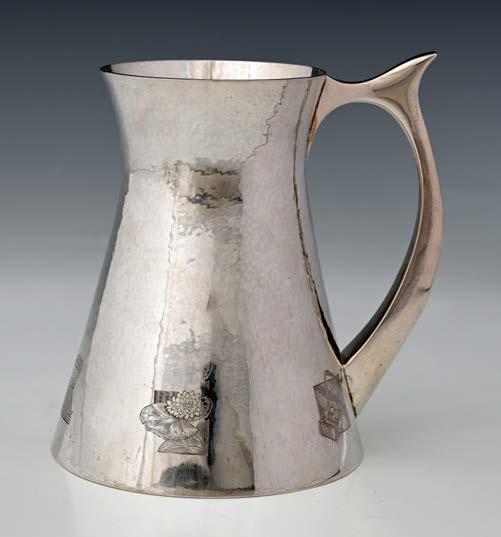

465 A pair of George V novelty cast silver menu holders formed as Punch and Judy, London 1910, Horace Woodward and Company Ltd., height 5.5cm, combined weight 72g/2.31ozt approx (2) £200 - £400

466
466 A pair of novelty silver Vintners’ Company napkin rings, formed as barrels, engraved with the Vintners’ coat-of-arms, by Birch and Gaydon, London 1958, height 6.1cm, combined weight 191g/6.14ozt approx (2) £150 - £200

467
467 A pair of silver table bells, London 1934/5, by Birch & Gaydon, engraved with the arms of the Vintners’ Company, height 11.4cm, combined weight 358g/11.51ozt approx (2) £300 - £500

468
468 A.E. Jones, and Arts & Crafts silver round-bowled spoon, the handle applied with a running fox, Birmingham 1959, length 13cm, together with a set of six unmarked spoons, each with inset hardstone cabochon finial, combined weight 91g/2.92ozt approx £80 - £120
469 Albert John Wilkins 1881-1953, a set of six small silver spoons in the Arts and Crafts manner with pierced stems, London 1935, length 10.3cm, combined weight 92g/2.95ozt approx
Note: Wilkins was born in Islington, the son of a silversmith, Walter John Wilkins, and was apprenticed to Frank Clarke Wheeler. Wilkins was briefly a partner in Murphy’s business whilst the latter was enlisted. £80 - £120
470 Amanda Birkett, a contemporary silver preserve spoon, with hook back, London 1990, length 12.5cm, weight 44g/1.41ozt approx £100 - £150

471
471 An unmarked sugar bowl and milk jug in the arts and crafts manner, circa 1920, the bodies decorated with a band of niello work, the handles formed from three conjoined wires, said to have been made by the silversmith and teacher at Gravesend School, Sidney J. Sparrow, height 10.4cm, combined weight 693g/22.28ozt approx (2) £500 - £800

472
472 Arthur Matthews of Bour nville, a pair of silver napkin rings, Birmingham 1935, one of the napkin rings is engraved ‘AM’ and the other ‘LM’ for Lois Matthews, Arthur’s wife, length 5.9cm, combined weight 95g/3.05ozt approx (2) £120 - £180

473
473 Asprey and Company, a pair of children’s silver alphabet plates, London 1983, diameter 16.2cm, combined weight 498g/16.01ozt approx (2) £400 - £600

474 Charles Boyton, a three-piece Art Deco silver condiment set with a sugar caster in the same pattern, London 1935 and 1936, each piece with signature underneath, each piece engraved with ‘B’, height of caster 10.5cm, combined weight 456g/14.66ozt approx
£300 - £500

475

477 Guild of Handicraft, a silver pedestal bowl, with notched rim, London 1956, diameter 11.4cm, together with a Guild of Handicraft (George Hart) spoon, London 1939, both pieces with planished exterior, combined weight 212g/6.81ozt approx (2)
£180 - £220
478 H.G. Murphy, a set of six silver spoons, each with niello inlay of spring flowers, London 1931, length 11.9cm, combined weight 84g/2.70ozt approx

£250 - £300
479 James Powell & Sons, an Edwardian silver Arts and Crafts decanter stopper, the planished body with an applied spherical finial, London 1906, height 5.7cm approx £80 - £120
475 Christopher Lawrence, a silver water jug, the exterior with bark-like texturing, London 1972, height 23.5cm, weight 982g/31.57ozt approx
£900 - £1,200
476 Gerald Benney, a silver cocktail stirrer, London 1972, the cast and applied terminal formed as a silver nugget, length 24.8cm, together with a long silver serving spoon, with applied wire to the front of the handle and a stylised fish to the reverse, John Capon, London 1980, length 25.2cm, combined weight 94g/3.02ozt (2)
£150 - £200

480
480 Keswick School of Industrial Arts, an Edwardian silver spoon in the late medieval manner, Chester 1906, length 15.1cm, together with a silver spoon by R. E. Stone, Edinburgh 1970, combined weight 62g/1.99ozt approx (2) £100 - £150

481

484
484 Marjorie Clare Amand Watson, two Elizabeth II silver bowls, the larger London 1979, smaller London 1988, diameter (of larger) 13cm, combined weight 313g/10.06ozt approx (2)
£250 - £350
481 Leslie Durbin, a pair of small silver goblets, London 1983, the planished bodies set upon baluster stems, height 11cm, combined weight 308g/9.90ozt approx (2)
£250 - £350

482

485
485 Merchant Taylors’ Company Interest, a George V novelty silver double propelling pencil holder, Sampson Mordan and Co., London 1927, in the form of the Beadle’s staff of the Merchant Taylors’ Company of the City of London, engraved on the shaft of the staff, ‘Merchant Taylors’ Company 1327-1927’, the two pull-out propelling pencils, Mordan Everpoints, form the head and tip of the staff, length 22.6cm, weight 69g/2.21ozt gross all-in approx £180 - £220
£300 - £400
482 Leslie Durbin, a silver bowl, London 1980, with applied cast handles formed as children climbing a branch, height 7.5cm, diameter 12.1cm, weight 286g/9.19ozt approx

483

486
£200 - £300
483 Leslie G. Durbin, a mixed-metal silver beaker, London 1971, the upper side inset with a pattern of gold roundels, height 8cm, weight 163g/5.24ozt approx
486 R. E. S tone, a silver compact, London 1952, of circular form, the hinged cover decorated in relief with a stylised starburst, diameter 8.3cm, weight 206g/6.62ozt approx £180 - £220

487
487 R.E. Stone, a pair of silver and enamel spoons, cased, commemorating the coronation of George VI and Queen Elizabeth, enamelled in blue and red, London 1936, the retailer’s case for the Goldsmiths and Silversmiths Company and impressed GR 1937 below a Royal Crown, length (of spoon) 15cm, together with a cased Art Nouveau silver spoon, hallmarked London 1904, combined weight (sans cases) 75g/2.41ozt approx (2) £120 - £180

488
488. R.E. Stone, a three-piece silver condiment set, comprising mustard pot, pepper pot, and salt cellar, together with a mustard spoon and a salt spoon, London 1954, the interior of the mustard and the salt lightly gilt, engraved with facsimile signature underneath, height (of mustard) 5.5cm, combined weight 331g/10.64ozt approx £250 - £350 489

490
490. Two Scottish silver Traprain spoons, each with swan handle, Brook and Son, Edinburgh 1924/1933, length 10.4cm, combined weight 93g/2.99ozt approx (2) £100 - £150

491
491 Worshipful Company of Blacksmiths, a silver pepper grinder, London 1938, by Mappin and Webb, the finial formed as the Company’s crest and the body engraved with ‘Ex Dono’ and the Company’s coat-of-arms, height 10.7cm, together with a Victorian pepper grinder formed as a milk churn, London 1889, Heath and Middleton, height 6.7cm approx (2) £180 - £220
492 A cased set of four Edwardian silver novelty toast racks, each atop four bun feet, Elkington & Co., London 1906, length 8.5cm, weight (sans case) 211g/6.78ozt approx £150 - £200

489 Two pairs of silver nutcrackers, the terminals decorated with panels of scrolls, Thomas Bradbury & Sons Ltd., Sheffield 1929, length 9.7cm, combined weight 183g/5.88ozt approx (2) £200 - £300
493 A cased silver child’s plate and spoon, London 1948, Wakely & Wheeler, engraved with the nursery rhyme ‘Old King Cole’, diameter 17.8cm, ensuite in a fitted retailer’s presentation case, Reid and Sons of Newcastle, combined weight (sans case) 278g/8.93ozt approx £200 - £300

494
494 A French first standard silver novelty menu holder, in the form of a cast whippet with one paw resting on a gate, circa 1900, struck with a French Minerva mark and the pattern number 1170, length 5.7cm, together with a Victorian silver fox and gate menu holder, L. Emmanuel, Birmingham 1895, combined weight 154g/4.95ozt approx (2) £120 - £180
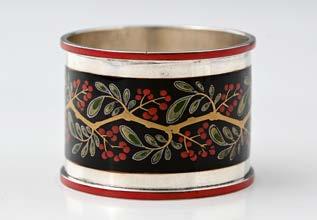
495
495 A George V silver and enamel Arts and Crafts style napkin ring, the body trailing foliage, the body applied with a signature in Japanese script, fully hallmarked, Charles Dumenil, London 1928, diameter 4.7cm, weight 32g/1.02ozt gross all-in approx £100 - £150

496
496 A George V silver and lapis lazuli Art Deco style paper knife or letter opener, George Betjemann & Sons Ltd., London 1930, length 23.7cm, weight 113g/3.63ozt approx £100 - £200
497 A George V silver arts & crafts silver pen tray, of shaped rectangular form, inset with hardstone cabochons, with rope twist border, Frederick Smythe-Greenwood, London 1912, length 21cm, weight 128g/4.11ozt approx £150 - £200

498
498 A George V silver dredger, of conical form with loop handle and detachable pierced domed cover, Wakely & Wheeler, London 1927, height 11.5cm, together with a wood and silver caster, J. Parkes, London 1933, combined weight (sans wood) 178g/5.72ozt approx (2) £150 - £200

499 A George V silver novelty commemorative spade, “Presented to Edith Mary Pitt on the occasion of the planting of the Oak in the gardens of New House Cressing 29th November 1934”, Goldsmiths & Silversmiths Co., London 1934, length 30.4cm, together with four hallmarked silver novelty spades, one by Josiah Williams & Co, Exeter 1876, another by William Hutton & Sons Ltd, Sheffield 1926, Francis Higgins II, London 1871, and Cooper Brothers & Sons Ltd, Sheffield 1920, combined weight 288g/9.25ozt approx (5) £250 - £350

500
500 A George V silver novelty or toy miniature kettle on stand, with ebonised handle, the stand with burner, Horace Woodward & Co Ltd., London 1914, height 13cm, weight 195g/6.26ozt gross approx £220 - £280
501 A George V silver seven bar toast rack, James Deakin & Sons, Sheffield 1931, length 11.7cm, together with another toast rack with a sweeping scroll handle, by James Dixon & Sons, combined weight 250g/8.03ozt approx (2) £200 - £300

502
502 A George V silver-mounted claret jug, the glass body with basketweave decoration, the hinged silver cover with pierced thumbpiece, the scroll handle with acanthus leaf surmount, William Hutton & Sons, Sheffield 1911, height 17.7cm approx £150 - £200

503 A George V silver-mounted claret jug, with hobnail cut glass body, the silver mount with a flat hinged cover, Goldsmiths & Silversmiths, London 1924, height 16cm, together with a Victorian silver-mounted claret jug, height 15.3cm approx (2) £300 - £500
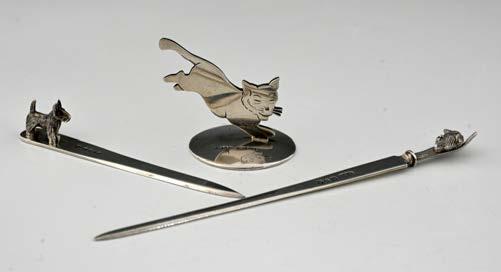
504 A group of novelty silver, to include a menu holder formed as a pouncing cat, Sampson Mordan & Co., Chester 1913, height 4.3cm, together with two hallmarked silver letter openers, each with a cast finial, comprising a kookaburra, and a standing terrier, combined weight 68g/2.18ozt approx (3) £150 - £200
505 A Modernist silver desk compendium, of asymmetrical form, the central dividers flanked by two hinged covers, opening to reveal gilt interiors, lined with turquoise-coloured leather, sponsor’s mark ‘TGH’, London 1981, width 8cm, weight 258g/8.29ozt gross all-in approx £240 - £280

507
507 A Modernist silver mustard pot, Garrard & Co. Ltd., London 1968, height 3.8cm, together with a Victorian silver drum form mustard, decorated with engine-turning, Edward Hutton, London 1883, both with blue glass liners, combined weight (sans liners) 313g/10.06ozt approx (2)
£250 - £350

508
508. A modernist silver pedestal dish, of navette form, ensuite with red phenolic Bakelite handles, atop a stepped rectangular form foot, William Adams Ltd., Birmingham 1962, length (across handles) 30.2cm, weight 527g/16.94ozt gross all-in approx
£400 - £600

509
£220 - £280
506. A modernist silver dish or coaster, by Vincent Ashworth, London 1966, length 7.6cm, together with a two-handled dish, Edward Barnard & Sons, London 1934, and a silver pedestal dish, E H Parkin & Co, Sheffield 1963, length 13.4cm, combined weight 297g/9.54ozt approx (3)
509. A pair of Art Deco silver six-bar toast racks, Martin Hall & Co. Ltd., Birmingham 1927, pattern number 16356, length 7.5cm, combined weight 97g/3.11ozt approx (2)
£80 - £120
510 A pair of Elizabeth II silver Modernist salt cellars, each with removable turned wood liner, sponsor’s mark ‘RR’, Sheffield 1973, diameter 5.6cm, combined weight (sans liners) 199g/6.39ozt approx (2)
£120 - £180
511 A pair of George V silver novelty napkin rings, featuring a Mickey Mouse, and a cartoon dog, respectively, J W Tiptaft & Son Ltd., Birmingham 1931, length 5.7cm, combined weight 26g/0.83ozt approx (2)

£80 - £120

515
512 A pair of modernist textured silver vases, Birmingham 1965, David Lawrence, height 13.5cm, combined weight 397g/12.76ozt approx (2)
£300 - £500

513. A set of four silver napkin rings, decorated with images of country pursuits, including fish, and game birds, J. B. Chatterley, Birmingham 1971, length 5.5cm, combined weight 135g/4.34ozt approx (4)
£120 - £180

514
514 A set of six silver novelty napkin rings, each topped with an animal, to include a monkey, owls, a squirrel, and a duck, with registered design number 767575, Horton & Allday, Birmingham 1931, width 5cm, combined weight 83g/2.66ozt approx (6)
£180 - £220
515 A set of three Art Deco silver-topped glass decanters, with a cork stopper, each cover unscrews to reveal a pourer, incised for ‘VERMOUTH’, ‘GIN’, and ‘LEMONADE’ respectively, ‘D.Bros’, Birmingham 1935, height 19.5cm approx (3)
£200 - £300
516 A set of three Elizabeth II silver nesting dishes, in the arts & crafts manner, each with a central raised dome, maker ‘WAR’, London 1958, diameter of larger 9.5cm, combined weight 194g/6.23ozt approx (3)
£150 - £200

517 A silver-mounted spirits flask, the glass body with leather mount, with detachable silver beaker, the hinged cap secured by a bayonet fitting, James Dixon & Sons, Sheffield 1957, height 10.7cm, together with a smaller example, with silver hallmarked for Chester 1932 (2)
£150 - £200
518 A Victorian silver bowl, decorated with floral garlands, Edward Hutton, London 1883, diameter 10.4cm, together with a bowl struck with the Dutch dolphin mark, used 1893-1905, combined weight 237g/7.61ozt approx (2)
£200 - £300

519 A Victorian silver-mounted claret jug, the glass body with simulated straw work decoration, the hinged cover with pierced thumbpiece, Charles Boyton, London 1896, height 18.5cm approx
£150 - £200

520 An unusual Victorian silver pouch-shaped box with suspension ring and air-tight flush-hinged lid, Rawlings and Summers, London 1845, length 6.7cm, together with a Victorian silver tinder box with steel strike, William Summers, London 1882, the lid engraved ‘Royal Victoria Yacht Club, Ryde.’, length 4.8cm approx (2)
£250 - £350

521 A George V silver travelling lunch set, comprising a silver sandwich box, of rectangular form, with hinged cover, side and carrying handle, together with a leather-covered and silver-topped hip flask with glass body, both pieces with an armorial crest, the silver hallmarked Goldsmiths & Silversmiths Co., London 1910/11, ensuite with a fitted leather travelling case, weight of silver box 200g/6.43ozt, length of leather case 12.5cm approx £250 - £350

522 An Edward VIII silver travelling sandwich box, of rectangular form, with hinged cover, side, and carrying handle, the cover with a crest and motto, ‘Vi Et Copia’, identified for Wetherall of Astley Hall, Hubert Hall, Chester 1936, retailed by Swaine & Adeney Ltd., length 12.7cm, weight 307g/9.87ozt approx £250 - £350

523 A.E. Jones for Cooper Brothers, an Edwardian silver sugar bowl and cream jug, Sheffield 1907, Cooper Brothers and Sons Ltd., in the arts and crafts manner, height 5.7cm, combined weight 247g/7.94ozt approx (2)
Note: the cream jug clearly shows the flooded marks of A.E. Jones, Birmingham 1907, which have been overstamped in Sheffield. £200 - £300

524
524 Amy Sandheim, an Arts & Crafts silver mug, with applied stylised foliate decoration, and planished exterior, London 1925, height 9.1cm, weight 207g/6.65ozt approx £180 - £220
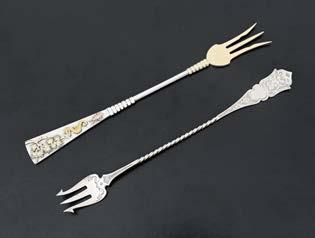
525
525 An American Aesthetic style silver and mixed metal server, with gilt tines, George W. Shiebler & Co., circa 1890, length 20.1cm, together with Victorian English example, Deakin & Francis, Birmingham 1896, combined weight 61g/1.96ozt approx (2) £100 - £200

526
526. An Art Deco silver-mounted glass jam jar, with prism-cut glass body, the detachable silver cover with wood finial, Frank Cobb, Sheffield 1938, height 11.2cm, together with a glass and silver pickle jar, London 1930, height 15.7cm approx (2) £120 - £180
527 An Art Deco style silver mug, the inside of the base inset with an applied silvergilt salmon, Wakely and Wheeler, London 1929, height 8.1cm, weight 167g/5.36ozt approx £140 - £180
528 An early twentieth-century Indian Colonial Arts & Crafts silver mug, the handle formed as a bifurcated foliate tendril, by Cooke & Kelvey, Calcutta, height 8.8cm, weight 184g/5.91ozt approx £150 - £200

529 An Edwardian Arts & Crafts silver bowl, with rope twist border, W. H. Haseler, Birmingham 1914, diameter 11.5cm, weight 143g/4.59ozt approx £120 - £180

530 An Edwardian Arts & Crafts silver two-handled dish, applied with twin cast handles formed as foliate tendrils, George Lawrence Connell, London 1908, length (across handles) 10.6cm, together with a small oval silver Pen Tray, London 1953, by Thomas James Boucher, the upper side engraved with the Royal Arms above a presentation inscription: ‘Royal College of Art, Presented to Basil Ward, Professor of Architecture 1946-1953 “by his colleagues to show their affection and esteem.”, combined weight 175g/5.62ozt approx (2) £150 - £200

531
531 An Edwardian novelty silver toast rack, the divisions form the word ‘TOAST’, atop four ball feet, Goldsmiths & Silversmiths Co., registered design number ‘249288’, London 1906, length 13.6cm, weight 127g/4.08ozt approx £280 - £320

532
532 An Edwardian silver Art Nouveau style letter opener or paper knife, Goldsmiths & Silversmiths Co., London 1902, length 23.7cm, together with a smaller example, retailed by Barrett & Sons of Piccadilly combined weight 191g/6.14ozt approx (2) £150 - £250
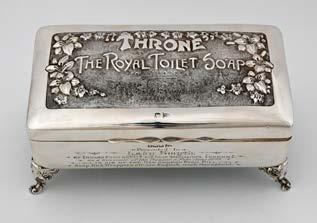
533
533 An Edwardian silver presentation box lined with green velvet, Sheffield 1904, Walker and Hall, atop four scrollwork legs, the lid of the box is embossed with a panel of flowers against a matted background and ‘THRONE The Royal Soap’ above ‘Violet Bouquet Edward Cook & Co. Ltd. The Soap Specialists London.’, the plain front of the box is engraved ‘Presented to Lady Smyth by Edward Cook & Co. Ltd., the Soap Specialists, London, E. as s Souvenir of the Bazaar & Fete, June 1905, in Aid of the New Church Room, Pill. Soap Box Wrappers etc. are English work throughout.’ Length 19.2cm, height 8cm approx £250 - £350

534
534. An Edwardian silver Regimental table cigar cutter, modelled in the form of an elephant, the howdah fitted with the cigar cutter, the ebonised base applied with an engraved plaque, resented to the Officers 2nd Battalion Duke of Wellington Regiment by Lieutenant L H Herapath and Lieutenant Langdale, Lieutenant Ellis, Lieutenant Gill dated September 1901, Goldsmiths & Silversmiths Co., London 1906, height 14.5cm, length of base 14.8cm approx £1,000 - £1,500

535
535 An Elizabeth II Modernist silver bowl and cover, with planished exterior, the detachable cover with stylised floral finial, the underside struck with the Coronation mark, by Sir John Cass Institute, London 1952, height 7cm, weight 262g/8.42ozt approx £200 - £300
536 An Elizabeth II silver Modernist server with triangular blade, London 1988, maker ‘ARE length 24.7cm, together with a silver butter knife, Birmingham 1993, maker ‘S.A.R.’, the handle with textured decoration, combined weight 141g/4.53ozt approx (2)
£100 - £150

537
537 Anthony Elson, a silver wine taster with tree branch handle, London 1977, the bowl engraved with contemporary initials ‘CR’, together with a Japanese silver small jug, circa 1900, the front engraved with a crest within a garter with the motto of the Order of the Bath, height 8.6cm, combined weight 278g/8.93ozt approx (2)
£220 - £280

538 Asprey, a cased set of six Art Deco style silver asparagus tongs, London 1936, ensuite with a fitted presentation case, with retailer’s label, ‘Asprey 166 Bond St. London’, length 8.6cm, combined weight (sans case) 131g/4.21ozt approx £180 - £220
539 Asprey, a cased sporting set, comprising four coldpainted bronze menu or place card holders depicting game birds, each atop a polished green banded agate base, ensuite with an ivory-mounted utility knife, featuring dials with counters for numbers of ‘partidges’, ‘pheasants’, ‘grouse’, and ‘various’, together with folding knife blades, corkscrew, 12 and 16 gauge cartridge measure, and eight peg butt markers, registration number 774524, circa 1930, retailed by Asprey 166 Bond St. London, length of knife when folded 10.7cm, when extended 24cm, height of menu holder 3.6cm approx Ivory Declaration
Reference Submission Number: WZAPFEGK £1,000 - £1,500


540
540 Asprey, a George V Art Deco style silver shoe horn, the body decorated with engine turned, London 1933, length 11.2cm, weight 65g/2.08ozt approx £50 - £100

541 Asprey, a George V silver toast rack, with warming stand and burner, with central ebonised handle, the base plate insert marked ‘Asprey London’ with a crown above, all component parts with corresponding hallmarks, Birmingham 1922, height 17.5cm, combined weight 369g/11.86ozt gross all-in approx £140 - £180

542
542 Brian Leslie Fuller, two silver conical candle snuffers, each with a cast and applied finial, in the form of an owl, and grouse respectively, London 1989 and 1994, height 8.2cm, combined weight 99g/3.18ozt approx (2) £150 - £200


543 C.J.Plucknett & Co Ltd., an arts and crafts silver spoon, London 1931, length 19cm, together with a set of six silver coffee spoons, with twist stem and spherical wirework finial, London 1915, combined weight 113g/3.63ozt approx £100 - £150
544 Central School of Arts and Crafts, a small Art Deco silver jar and cover, set with a circular finial, London 1939, height 9.3cm, weight 165g/5.30ozt approx £150 - £200
545 Charles Robert Ashbee for the Guild of Handicraft, an Arts and Crafts silver bowl and cover, with planished body, the detachable cover with raised beaded border, the centre with applied strapwork supports and inset with a polished hardstone finial, both the cover and bowl fully hallmarked, sponsor’s mark ‘CR/A’ within a shaped cartouche, London 1899, height 10.7cm, diameter of cover 14.55cm, diameter of bowl 13.9cm, weight 359g/11.54ozt approx
Note: this piece is struck twice with Ashbee’s early CRA sponsor’s mark. £2,000 - £4,000

546 Christopher Lawrence for House of Lawrian, a 20th-century silver perfume bottle, London 1978, applied with a band of rose decoration and with a matted screwon stopper, height 7cm, together with a tear-drop shaped silver box, with pull-off lid, the sides engraved with ducks and geese, London 1979, maker ‘K.T.’, length 3.5cm, combined weight 96g/3.08ozt approx (2)
£80 - £120
547 Cyril James Frost, a novelty silver letter opener, modelled in the form of a trowel, London 1951, length 13.1cm, together with an Art Deco silver letter opener, ‘HCB’, London 1946, combined weight 66g/2.12ozt approx (2) £80 - £120
548 Derek Birch, a modernist silver mug, of cylindrical form with elongated loop handle, London 1964, height 10cm, weight 287g/9.22ozt approx £220 - £280

549 Edward Pugin, a small silver hinged locket, one side engraved with the Pugin family crest and a crowned ‘M’ with fleurs-de-lys, for the Virgin Mary, the other side engraved with a ribbon, arranged into a lozenge pattern, with the motto ‘Regina Sine Labe Originali Concepta’ against a background of floriated ornament, apparently unmarked, diameter 3.1cm, weight 18g/0.57ozt approx
Provenance: with Joseph Riddell, who married Margaret, the youngest daughter of A.W.N. Pugin in 1898 and thence by descent.
Note: a present from John Hardman to Edward Pugin on his eighteenth birthday, 11th March 1852, a few months before the death of his father, A.W.N. Pugin. The engraving on this piece is akin to that used by Pugin for encaustic tiles, such as at St. Mary’s Convent in Handsworth. The motto was used in the design of Miraculous Medals derived from the visions of Catherine Labour in 1830 and appeared, for example, in ‘A Novena in Honour of the Most Blessed Virgin Mary of St Carmel, Mother of God, and Our Dear Lady...’, published in 1852. After consultation with bishops from 1851-53, the dogma of the Immaculate Conception was proclaimed by Pope Pius IX in 1854.
£450 - £550

550
550 Elizabeth Kirkwood, a silvermounted coconut bowl and matching spoon, Edinburgh 1951, atop three applied pad feet, the spoon with coconut shell bowl and hallmarked silver handle, height (to rim) 9.8cm, diameter 9.3cm approx
£150 - £250

551
551 A set of four novelty silver napkin rings, each topped with an animal, to include a dog, kangaroo, puppy, and owl, Horton & Allday, Birmingham 1931, with registered design number 767574, length 8cm, combined weight 52g/1.67ozt approx (4) £120 - £180
552 Geoffrey Guy Bellamy, two silver cocktail pieces, comprising a slotted spoon, and two-prong fork, each with long handle, London 1957, length 19.5cm, combined weight 52g/1.67ozt approx (2) £100 - £150

553
553 Georg Jensen, a single pair of Blossom pattern silver sprung tongs, marked ‘Sterling Denmark’, also struck with British import marks for 1944, length 13.4cm, weight 65g/2.08ozt approx £120 - £180
554 Goldsmiths’ Hall interest, a twentieth-century silver presentation plaque, likely from a cigar box, engraved ‘Presented to the Rt. Hon. Harold Wilson. OBE PC MP, President of the Board of Trade on the occasion of the opening of the Design & Research Centre for the Gold, Silver & Jewellery Industries at Goldsmiths’ Hall, London, November 15th 1950’, Asprey & Co. Ltd., London c.1950, length 12.7cm, weight 123g/3.95ozt approx £80 - £120

555 H.G. Murphy, a silver mustard spoon, London 1931, the end applied with three triangles, also struck with the falcon mark, length 10.3cm, together with a small silver spoon by the Artificers’ Guild, London 1932, combined weight 21g/0.67ozt approx (2)
£70 - £90

556

558. Hermes, a cased set of twelve mid-century silverplated novelty horse bit menu holders, ensuite in the original fitted presentation case, retailed by Hermes, Paris, length of each 5.8cm approx £250 - £350
556 Helen West, a pair of cubist silver napkin rings, each inset with a square-cut stone, length 4.2cm, combined weight 65g/2.08ozt gross approx (2)
£50 - £100

557
557 Henry Schlevogt for Curt Schlevogt Co., a Bohemian Art Deco amber glass and English silver mounted scent bottle, the stopper modelled in relief as the Birth of Venus, on an angled geometric base, silver collar hallmarked London 1940, sponsor’s mark indistinct, height 18.2cm approx £200 - £300
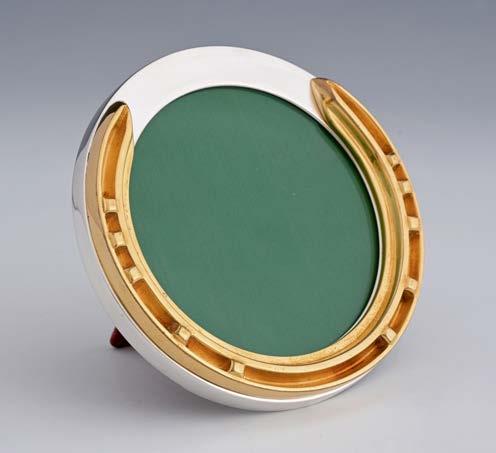
559 Hermes, a twentieth-century French ‘Horseshoe’ photograph frame, the front with an applied gilt horseshoe, the tooled leather easel backboard marked in gilt lettering ‘HERMES / PARIS / MADE IN FRANCE’, diameter 12.4cm approx £500 - £800
560 Jadwiga Billewicz, a set of six silver modern coffee spoons with gilt bowls, maker’s mark ‘J.B’ Edinburgh 1977, length 11.2cm, together with a silver ladle by LW London 1993, combined weight 108g/3.47ozt approx £90 - £120

561
561 Jocelyn Burton, a pair of modern silver goblets, London 1976, the tapering circular bowl, with gilt interior, with a cast sea horse stem, on a raised circular foot, height 19.9cm, combined weight 551g/17.71ozt approx (2) £450 - £650

562
562 John Ferguson Gow, a silver and enamel dish, London 1943, of square form, the centre embossed with a Tudor rose in polychrome enamel, length 9cm, weight 87g/2.79ozt gross approx £200 - £300

563 Leslie Gordon Durbin, a modernist silver bowl, of navette form, with applied shell-form handles, atop a collet foot, London 1953, length 15.8cm, weight 145g/4.66ozt approx £150 - £200

564 Leslie Gordon Durbin, a silver-gilt presentation quill, London 1958, inscribed “Adrian C. Slade, ‘World’s Press News’ Copywriting Award 1961”, length 21.5cm, weight 38g/1.22ozt approx £200 - £300

565
565 Leslie Gordon Durbin, an Elizabeth II silver beaker, of slightly tapered cylindrical form, London 1970, height 7.9cm, weight 158g/5.07ozt approx £150 - £200

566 Liberty & Co., an Edwardian silver aide memoir, the cover decorated in relief with a stylised galleon, the interior houses three composite ivorine panels, with suspensory loop, Birmingham 1902, diameter 4.5cm approx £50 - £100
567 Liberty & Company, a George V silver triangular serving slice, inset with a cabochon stone, Birmingham 1924, length 18.1cm, together with a Liberty spoon, Birmingham 1930, combined weight 129g/4.14ozt approx (2) £120 - £180
£200 - £300
568 Louis Galvin over-stamping H.G. Murphy, two children’s forks, London 1937, one fork shaped and engraved with a polar bear and the other with a squirrel, length 15cm, combined weight 61g/1.96ozt approx (2)

569
569 Malcolm Appleby MBE, a swan and otter silver pendant, Edinburgh 2013, length 4.3cm, weight 20g/0.64ozt approx
£200 - £300

570
571 Michael Allen Bolton, a cased pair of silver dressing brushes, London 1984, length 12cm, ensuite in fitted presentation cases, retailer GB Kent & Sons, by Royal Appointment (2)
£300 - £500
572 Michael Allen Bolton, two silver spoons, to include a spoon, with planished bowl, and cast stem with bead finial, London 1986, length 18.5cm, together with a smaller planished spoon, London 1980, combined weight 57g/1.83ozt approx (2)
£200 - £300
573 Needlework and sewing interest, a silver darning egg, London 1947, by Richard Comyns, engraved around the centre, ‘Xmas comes but once a year, but darning’s always here I fear,’ and at one end ‘Carol from A.C Xmas 1947.’, height 9cm, weight 96g/3.08ozt approx
£120 - £180

574
£300 - £500
570 Malcolm Appleby, a cased set of six silver buttons, each of circular form, and decorated with a crowned leopard’s head, Edinburgh 2014, diameter 2cm, combined weight (sans case) 24g/0.77ozt approx

571
574 R. E. Stone for Asprey, an eight-piece silver Christening set, ensuite with the original fitted case, the bowl and cup with the signature of Stone, all marked for Asprey, London 1938, the bowl engraved ‘Mary quite contrary’ and with an inscription to argaret Victoria Trubshawe, from her uncles Richard and Robert McDougall 12th November 1938. the cup and egg cup, the fork and spoons, all engraved with a girl with a watering can, the knife engraved with a seated girl in a garden, the case retailed by Asprey 188 Bond St., London, dimensions of case 44.7x30.8x9.2cm, combined silver weight 626g/20.12ozt approx
Note: Margaret Louise, daughter of James Gladstone McDougall [of the flour milling family] married the actor Michael Trubshawe in October 1932. They later divorced. The birth of their daughter Margaret Victoria Trubshawe in 1938 was clearly the occasion for this gift. Robert McDougall died in December 1938. £600 - £800

575 R. E. Stone, a George V silver mug, in the arts & crafts style, the planished body atop an octagonal foot, London 1935, height 8cm, together with an R. E. Stone goblet, London 1962, height 12.2cm, combined weight 336g/10.80ozt approx (2) £300 - £500

576 R. E. S tone, two Art Deco silver dishes, each with a triangular handle, inset with an applied carved ivory panel, one fully hallmarked, with facsimile signature, Birmingham 1931, diameter 10cm, the other maker’s mark only, diameter 10.2cm, combined weight 235g/7.55ozt gross all-in approx (2) Ivory Declaration Submission Reference Number: F52DYHZG £200 - £300

577 R.E. Stone, a child’s silver mug, engraved with ‘Hickory Dickory Dock’ and a mouse running up a clock, with a notched angular handle, the underside with the facsimilie signature, . E. Stone London 1949, height 9cm, weight 162g/5.20ozt approx £180 - £220
578 Sibyl Dunlop, a place setting of flatware, London 1926, comprising five pieces, the terminals pierced, length of tablespoon 21cm, combined weight 247g/7.94ozt approx £300 - £500
579 Three twentieth-century American silver novelty bookmarks, each featuring a character from works by Charles Dickens, ‘Miss Squeers’, ‘Mrs Bardell’, and ‘Richard III’, the obverse of each marked ‘STERLING’, by J.F. Fradley, New York 1901-1910, length 10.5cm, combined weight 63g/2.02ozt approx (3)
£350 - £450

580
580 Transatlantic Yacht Race 1964, a silver pint mug, London 1960, by Richard Comyns, the front engraved with a Catamaran. The interior rim engraved with “The Atlantic where the great whales come sailing by, sail and sail with unshut eye” - From the Family 1964.height 12cm, weight 376g/12ozt approx The quote, adapted from lines in Matthew Arnold’s poem, ‘The Forsaken Merman’, 1849, evidently commemorates the 11th place achieved by Mike Butterfield in the race in his boat ‘Misty Miller.’ Butterfield was a Barrister as well as a keen sailor and was the second of two entries in the race by catamarans
£280 - £320

581
581 Two Art Deco silver and enamel wine labels, both for ‘Brandy’, decorated in polychrome guilloche enamel, both with sponsor’s mark of Turner and Simpson, Birmingham 1933 and1934, length 4.8cm and 3.8cm respectively, combined weight 33g/1.06ozt gross approx (2) £250 - £350

582
582 Two early twentieth-century silver Arts & Crafts jugs, the smaller Britannia Standard (0.958), Frank Finley Clarkson, Chester 1904, height 5.4cm, the larger by Thomas D. Bryan, Birmingham 1920, height 6.6cm, combined weight 199g/6.39ozt approx (2)
586 Two similar silver five-bar toast racks, each with a loop handle, atop four ball feet, Walker & Hall, Sheffield 1925 and 1931, length 9cm, together with another silver toast rack, Martin, Hall & Co., Sheffield 1908, combined weight 364g/11.70ozt approx (3)
£300 - £500
587 Two twentieth-century silver strainers, each modelled in the eighteenth-century style, one with two solid flat handles with wavy cut scroll edges, William Comyns & Sons Ltd., London 1938, length 16.8cm, the other with a perforated bowl, and gadrooned border, Harman & Co. (J S Harman), London 1934, combined weight 142g/4.56ozt approx (2)
£120 - £180
Note: Clarkson, who had his pieces hallmarked in Chester, was actually working in Northallerton.
£250 - £350
583 A Victorian silver-mounted novelty jar and cover, modelled in the form of an apple, the glass body with a detachable silver cover, Norton & White, Birmingham 1895, height 15.7cm, diameter of bowl 14cm, weight of cover 176g/5.65ozt approx
£150 - £200
584 Two silver children’s plates, one engraved ‘Peter Pan’, by R.E. Stone, London 1946, the underside with facsimile signature, diameter 16.8cm, a further plate by Edward Barnard & Sons Ltd., London 1912, combined weight 513g/16.49ozt approx (2)
£380 - £420

585

588
588 William Phipps and Denis McQuoid, a contemporary silver egg-shaped box, the planished exterior engraved with a Cuban tody bird, height 7cm, weight 103g/3.31ozt approx
£200 - £300
585 Two silver spoons to include an example from the Malvern School of Art, in the arts and crafts tradition, with hammered surface, Birmingham 1991, length 23.6cm, together with an Isle of Mull Silver Company ladle, Edinburgh 1994, combined weight 76g/2.44ozt approx (2)
£100 - £150


589
589 A nickel alloy or Paktong trick-opening snuffbox, circa 1840, copying a late 17th-century form, the interior stuck with a maker’s mark ‘WH’ and the name ‘W. Howe’ together with two crude pseudo lion passant marks, the outside of the box is engraved with script initials and, on the base, with a view of two donkeys in adjacent fields and the motto ‘When Shall We Three Meet Again?’, the box has a false button catch at the front and opens with a concealed catch attached to an interior spring, length 6.3cm approx £50 - £80



590 An oval brass plaque engraved for the Humanitarian Society, maker’s mark to the reverse, length 10.8cm, together with a further brass shell-shaped plaque engraved, ‘City of Edinburgh’, possibly a gauge, circa 1800 (2) £50 - £80
591 A crested brass verriere, engraved with an armorial crest, circa 1770, length (across handles) 32cm approx £80 - £120
592 A brass basting spoon, circa 1730, together with a mideighteenth-century pewter basting spoon, length 37.8cm approx (2) £90 - £120
593. An eighteenth-century silvered brass taperstick, with knopped stem, atop a stepped and shaped square base, the underside struck with maker’s mark, ‘IW’, struck underneath with pseudo hallmarks identified as those used by John Walker, height 15cm approx
Note: John Walker, Ironmonger and Brazier of Cheapside, London, who advertised “all Sorts of new-fashion French Plate so neatly finish that it is not to be discern from real Silver, he having the very best Workmen, and by him they are wholly employ” £120 - £180
594 An eighteenth-century ‘French plate’ soap or sponge box, the domed hinged cover engraved with an armorial, circa 1740, height 8.5cm approx £150 - £200
595 A pair of silvered brass Neoclassical candlesticks, each with a stepped square base, and central well, the columnar stems with bobbin nozzles, each with a widow’s coat of arms with a lozengeshaped shield, height 31.5cm approx (2) £200 - £250
596 An early eighteenth-century brass spice box, of rectangular form, with canted corners, the hinged cover with an applied agate panel and paste surround, circa 1700, length 6cm approx (a/f) £200 - £250
597 An eighteenth-century ‘French plate’ brass tea tray, circa 1725, struck with pseudo hallmarks by ‘ID’, identified as Josiah Daniel, length 45.5cm approx
See: Cameron, P. (2013). Identifying D With a Crown Above Journal of the Antique Metalware Society, Vol. 21, pp.23. £550 - £650



598 A set of four eighteenth-century Paktong candlesticks, each with a stepped square base, decorated with gadrooning, height 26.5cm approx (4)
£600 - £800
599 An eighteenth-century Paktong coffee pot, the body wide-bellied, with fluted spout capped with a stylised leaf, the foot and lid rims gadrooned, engraved on the outer edge of the foot rim: ‘This Coffee Pot Was Given For The Use of The President And Officers Of The House In The Year 1773.’, also engraved under the foot with initials ‘Eln.’, the interior of the pot tinned, height 28cm approx
Note: Keith Pinn, in ‘Paktong, the Chinese Alloy in Europe 1680-1820’, p. 112, refers to a letter from Matthew Boulton in reply to Lord Valentia in 1771, declining his request to make a ‘teutenague coffee pot’, on the basis that it was an unsuitable metal for such a purpose. Appendix 1, 16, in Pinn’s book has an excerpt from Boulton’s letter, directed to Lord Valentia, Merion Square, Dublin, 26 December 1771 [book E, page 330] - ‘must beg leave to recommend you to a plated coffee pot instead of the teutenague one your Lordship wants for although the teutenague metal is exceeding good for many purposes yet it will by no means do for any cookery vessel as it has the same properties as brown copper, we shall therefore wait your determination respecting it Pinn does illustrate a paktong hot water jug of this period. Several paktong tea urns survive. £700 - £900

600 An eighteenth-century silvered brass rectangular salver, with shaped border, and central armorial, atop four bracket feet, the armorial identified for George Butler Esq., of Ballyragget and his wife, Catherine (King), circa 1730, length 40.7cm approx
Note: Butler was of a cadet line of the Butlers of Ormonde, and she, a daughter of King, Lord Kingston. With thanks to two Irish scholars, Thomas Sinsteden and John Kirwan, for their assistance with the armorial identification. It appears this lot may possibly be the only piece of silvered brass with an identifiable Irish armorial. £700 - £900
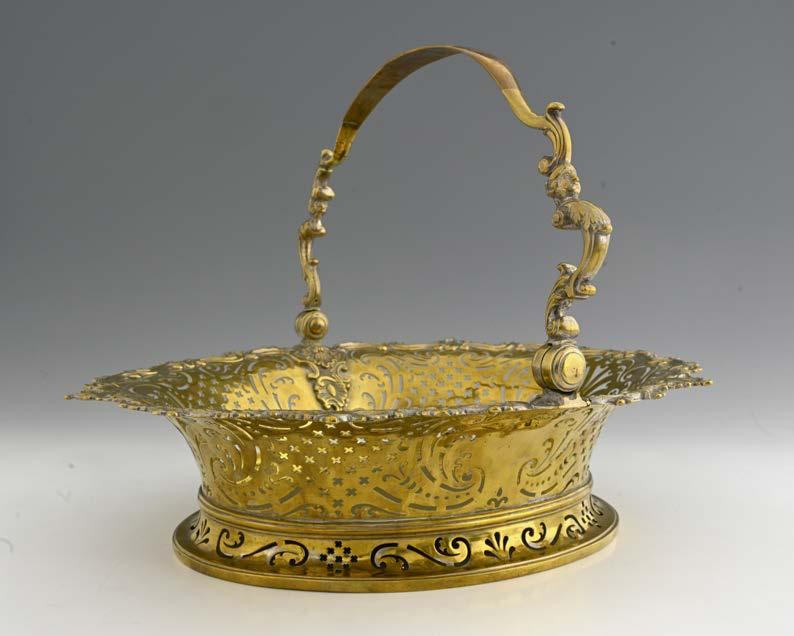
601 An eighteenth-century brass or French Plate cake or bread basket, circa 1740, in the Rococo style, of ovoid form with shell and scroll border, the body pierced with scrolls, with swing handle supported by foliate capped scrolls, engraved initials underneath ‘D&P’, length 39.7cm approx
Note: According to research undertaken by Peter Cameron, only three others are known. One is illustrated in Gentle and Hood on English Domestic Brass. Two others in private collections. £2,000 - £3,000
602 A Victorian silver-mounted wooden bottle holder, with handle, corrugated body, and support stand, Atkin Brothers, Sheffield 1891, length 16cm approx £550 - £650
603 Heath & Middleton, a late Victorian silver patent opening silver box or Jar, London 1896, the lid engraved, ‘Presented to Qr. Mr. Segt. Warren from his old comrades 2nd Dorset Regt. Jany 1898.’, with a gilt interior, the base stamped ‘Francis Meli’. and with a pattern number ‘10618’, height 15.6cm, weight 230g/7.39ozt approx
Note: Francis Meli, retailers of silver and jewellery were established in Valetta, Malta from the end of the 19th century. The Dorsetshire regiment was stationed in Malta from 1897 to 1899. £200 - £300
604 Hukin and Heath, a set of eight George V silver coffee spoons, each with a composite finial, Birmingham 1921, length 10.2cm, weight 65.5g/2.1ozt gross approx £50 - £80


605. Hukin and Heath, a Victorian silver and ceramic night light, the ceramic bowl by Coalport, London 1898, height 8.2cm approx £70 - £90

606
606 Hukin and Heath, a pair of Victorian Art Nouveau silver spoons, each with a handle formed as entwined foliate tendrils, together with a set of three similar Art Nouveau style spoons, all hallmarked Birmingham 1900, length 10cm, combined weight 65g/2.08ozt approx (5) £100 - £150

607 Hukin and Heath, a set of five Art Nouveau silver spoons, each with a lobed bowl, the handle secured by a bifurcated terminal, formed as entwined foliate tendrils, hallmarked Birmingham 1900-01, two with registered design number 364903, length 10.7cm, combined weight 92g/2.95ozt approx (5) £100 - £150

608 Hukin and Heath, a Victorian silver-mounted glass round dish, with scroll handles, and star-cut base, Birmingham 1895, diameter 23.2cm approx
£100 - £150

609 Hukin and Heath, an Edwardian silver-mounted glass jam pot, with a patent removable Lid, the scroll thumbpiece joined to the hinge, Birmingham 1909, Patent 2070.08.No. 368982 Brevete, together with a spoon, Birmingham 1905, also Hukin and Heath, height 10cm approx (2)
£100 - £150

610 Hukin and Heat h, a Victorian silver and glass inkwell, London 1889, the dish and the hinged lid shell-shaped, supported on ball feet, length 19cm, weight (sans glass) 122g/3.92ozt approx
£100 - £150
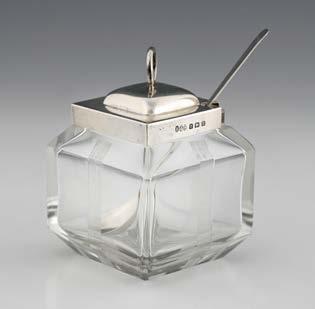
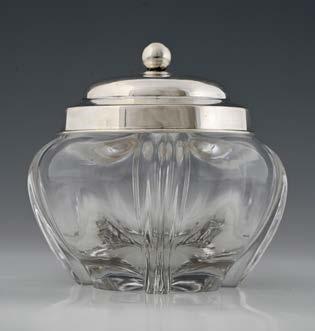
611 Hukin and Heath, a Victorian silver-mounted glass biscuit box, the detachable silver lid with spherical finial, Birmingham 1899, height 15cm, weight (sans glass) 76g/2.44ozt approx
£100 - £150
612 Hukin and Heath, a silvermounted glass jam pot, Birmingham 1926, the cube-shaped jar with bevelled edges and ornamented with bands of parallel lines, ensuite with a preserve spoon, Birmingham 1905, height (of pot) 9.5cm approx
£100 - £150
613 Hukin and Heath, a Victorian silver naturalistic bowl with tapering sides and crimped rim, London 1885, diameter 9.3cm, together with a pair of salt cellars, London 1886, combined weight 118g/3.79ozt approx (3)
£100 - £150

614 Hukin and Heath, five Victorian silver-mounted glass liqueur glasses, various dates, Birmingham 1892-8, height 17cm approx (5) £120 - £180
615 Hukin and Heath, a pair of Edwardian silver salad servers, with naturalistic terminals formed as foliate tendrils, London 1902, length 25.5cm, combined weight 156g/5.01ozt approx (2)
£120 - £180

616. Hukin and Heath, a Victorian silver-mounted glass jam pot, the silver frame with loop handle, the ribbed glass jar with detachable silver domed cover, Birmingham 1893, height 10.8cm, weight (sans glass) 111g/3.56ozt approx £120 - £180

617 Hukin and Heath, A George VI silver novelty preserve pot and cover, modelled in the form of an apple, the cover hallmarked Birmingham 1937, ensuite with a matched preserve spoon, also by Hukin and Heath, height 10cm, combined silver weight 52g/1.67ozt approx £120 - £180



618. Hukin and Heath, a George V silver-mounted glass decanter, with stopper, engraved with an armorial crest, Birmingham 1925, height 32cm approx £120 - £180
619 Hukin and Heath, a Victorian silver commemorative toast rack, for Queen Victoria’s Jubilee, the bars to read ‘VR 97’, London 1897, pattern number 12640, length 11.9cm, weight 87g/2.79ozt approx £120 - £180
620 Hukin and Heath, a set of six Edwardian shot glasses and silver saucers, Birmingham 1906, height (with glasses) 4.3cm, diameter of saucers 7.5cm, combined weight (of saucers) 157g/5ozt approx (6) £120 - £180

621 Hukin and Heath, a George V silver-mounted glass preserve jar, with a patented opening mechanism, Birmingham 1922, height (to top of raised handle) 12cm approx £150 - £250
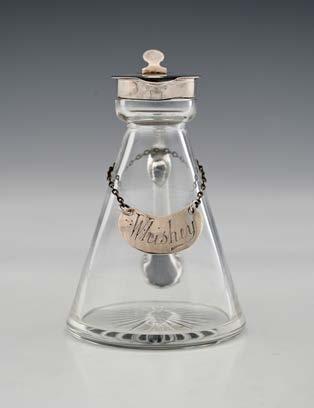
622. Hukin and Heath, an Edwardian silver-mounted whiskey tot or noggin, the conical glass body with star-cut base, ensuite with a silver label engraved ‘Whishey”, London and Birmingham 1908, height 10cm approx £150 - £200

623
623 Hukin and Heath, a George V silver-mounted glass liqueur jug, Birmingham 1913, height 13.5cm approx £150 - £200
624 Hukin and Heath, a silver small bowl, London 1885, the bowl with crimped edge and leafy veins from a flowerhead centre and supported on a waved wire foot with three evenly spaced flower heads, diameter 11cm, together with a sifting ladle, London 1882, combined weight 171g/5.49ozt approx (2) £150 - £200

625
625 Hukin and Heath, an Edwardian silver-mounted glass decanter with detachable glass stopper and star cut base, hallmarked Birmingham 1906, height 22cm, together with a silver-mounted glass preserve jar, with a patented opening mechanism, Birmingham 1922, height (to top of raised handle) 12cm approx (2) £160 - £200


626
626 Hukin and Heath, an Edwardian silver-mounted glass decanter, London 1904, with an intaglio ‘rock crystal’ engraved glass body and stopper, decorated with panels of water lilies, probably by Webb, height 18.7cm approx £170 - £250

627
627 Hukin and Heath, a Victorian silver-mounted glass preserve jar, with a patented opening mechanism, where the hinged cover opens when the swing handle is lowered, the lobed bombe form body with vertical green trailing, probably Stourbridge, height (to top of raised handle) 14.8cm approx £180 - £220

628 Hukin and Heath, an Edwardian wood and silver pepper grinder, Birmingham 1909, height 10.5cm, together with a smaller example with plated mounts, and a pepper grinder with silver body and turned wood top of globular form, hallmarked London 1986, height 10cm approx (3)

£180 - £220

632 Hukin and Heath, a Victorian novelty silver sugar basket, modelled as a coal scuttle with matching scoop, London 1885, length 15cm, weight 244g/7.84ozt approx £200 - £300
629 Hukin and Heath, a Victorian silver naturalistic leafshaped dish, London 1888, length 11cm, together with a second leaf-shaped dish, Birmingham 1893, combined weight 206g/6.62ozt approx (2)
£180 - £220
630 Hukin and Heath, a Victorian silver naturalistic textured bowl with tapering sides and a matching sifting spoon, London 1890, marked for Heath and Middleton, diameter of bowl 10.1cm, together with a Victorian silver naturalistic basket, maker’s mark obscured, Sheffield 1893, combined weight 261g/8.39ozt approx (3)
£180 - £220


633 Hukin and Heath, a silver-mounted glass biscuit box, the handle and hinged cover hallmarked Birmingham 1901, height (to top of raised handle) 22cm approx £200 - £300
£200 - £300
631 Hukin and Heath, a Victorian silver-mounted cream jug and sugar bowl, with tongs, Birmingham 1883, height of cream jug 7.5cm, together with a silver-mounted butter dish, London 1883, diameter 10.6cm approx (4)

634 Hukin and Heath and Coalport, a silver-mounted ceramic jug in cream and gold with boar’s tusk-shaped handle, Birmingham 1895, height 19.7cm approx £200 - £300

635
635 Hukin and Heath, an Art Deco silver-mounted glass decanter, and stopper, Birmingham 1936, height 37cm approx
Note: These were made in three sizes.
See: 1920’s Hukin and Heath catalogue image. £200 - £300

636
636 Hukin and Heath, an Edwardian silver-mounted claret jug, Birmingham 1904, with an intaglio ‘rock crystal’ engraved glass body and stopper, probably by Webb, height 27.5cm approx £200 - £300

637
637 Hukin and Heath, two similar Victorian silver-mounted pinched glass decanters, each with detachable glass stopper, the silver mounts hallmarked, Hukin and Heath, Birmingham 1894, and sponsor’s mark rubbed, London 1887, respectively, height of tallest 30cm approx (2) £200 - £300

638
638 Hukin and Heath, a silver-mounted glass glug glug or scrooge decanter with hinged bun-shaped lid, London 1889, the silver top engraved with an owner’s crest, the underside of the lid with integral cork, height 25cm approx £220 - £280

639
639 Hukin and Heath, a novelty silver toast rack, the divisions form the word ‘TOAST’, atop four ball feet, Hukin and Heath, with registered design number ‘10529’, Birmingham 1923, length 13.4cm, weight 115g/3.69ozt approx £220 - £280

640

643

645
640 Hukin and Heath, a George V silver-mounted glass claret jug, the plain mount with hinged cover, and angular handle, the body baluster-shaped with starcut base, Birmingham 1913, height 19.5cm approx
£220 - £280

641
641 Hukin and Heath, two silvermounted glass preserve jars, and a silver spoon, each with patented opening mechanism, where the hinged cover opens when the swing handle is lowered, Birmingham 1908/10, height of taller (top of handle) 14cm approx (3)
£220 - £280
642 Hukin and Heat h, a Victorian silver naturalistic butter dish, with glass liner, Birmingham 1893, diameter 14.3cm, together with a naturalistic silver bowl, hallmarked London 1882, diameter 13.3cm, combined weight (sans glass ) 272g/8.74ozt approx (2)
£240 - £280
643 Hukin and Heath, a Victorian threaded glass decanter with silver mount, the hinged flat top cover with a handle formed as a foliate tendril also secured by a hinge, Birmingham 1892, height 29.5cm approx
645 Hukin and Heath, a Victorian silver-mounted claret jug, London 1898, the glass body with cut floral decoration, engraved with the pattern number 14696 inside the lid, height 23cm approx
£250 - £350

644
644 Hukin and Heath, two silvermounted pepper grinders, one with a cut glass body, hallmarked Birmingham 1901, together with a novelty example in the form of a brass weight, hallmarked Birmingham 1895, height 9.7cm approx (2)
£250 - £350
£250 - £350

646
646 Hukin and Heath, a Victorian silver-mounted ice bucket and tongs, Birmingham 1890, height (to top of raised handle) 20.2cm, length of tongs 15.8cm approx (2)
£250 - £350

647 Hukin and Heath, a George VI silver-mounted glass decanter, the lozenge-shaped glass body with star-cut base, the stopper with silver mount and a clip which secures to the silver collar, Hukin & Heath Ltd., Birmingham 1945, height 24cm approx £280 - £320

648 Hukin and Heath, an Art Deco locking decanter, the silver mount Birmingham 1926, engraved as a horse race prize, ‘Hayfever’ October 15th 1927, ensuite with key and working locking mechanism, height 21cm approx £300 - £500

649 Hukin and Heath, a Victorian silver-mounted glass ewer, Birmingham 1893, of tall slender form, with naturalistic hinged silver cover, retailed by ‘Gethen. Madrid & Biarritz’, height 40.2cm approx £300 - £500
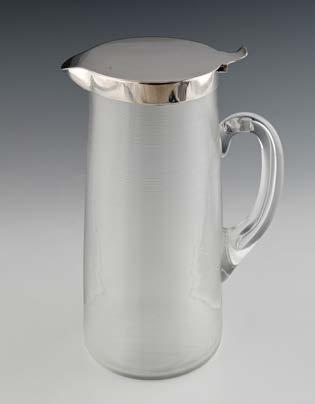
650 Hukin and Heath, a silvermounted lidded lemonade jug, Birmingham 1892, the glass body with threaded decoration, the hinged cover with notched thumbpiece, height 26.5cm approx £300 - £500

651
651 Hukin and Heath, a George V silver-mounted ‘Abbey’ glass decanter, of dimpled square-section, with a flared silver collar, and a compressed hollow blown stopper, the glass by Stevens & Williams, the silver mount hallmarked for 1928, height 21.5cm approx £300 - £500

652 Hukin and Heath, an Edwardian silver-mounted glass preserve jar, with a patented opening mechanism, where the hinged cover opens when the swing handle is lowered, the lobed bombe form body with vertical green trailing, height (to top of raised handle) 14.8cm, together with a silvermounted glass preserve jar, with a patented opening mechanism, London 1902, height (to top of raised handle) 13.8cm approx (2) £300 - £500

653
653. Hukin and Heath, a pair of silver Art Deco style five-bar toast racks, Birmingham 1935, together with one other, Birmingham 1936, length 9.8cm, combined weight 408g/13.11ozt approx (3)
£350 - £450
654 Hukin and Heath, a Victorian silver naturalistic dish, engraved with a cipher surmounted by a coronet, London 1888, length 18.3cm, weight 144g/4.62ozt approx £120 - £150

655

656
656. Hukin and Heath, a pair of George V silver-mounted glass decanters, the body of each decorated with radiating sliced cuts, Birmingham 1912, ensuite with a pair of bottle tickets, for ‘Brandy’, and ‘Whiskey’, Hukin and Heath, London 1913, height 18cm approx (2)
£420 - £480
655. Hukin and Heath, a late Victorian silver-mounted glass lemonade jug and two beakers, the jug Birmingham 1890 and the two beakers London 1889, the glass bodies of each piece ornamented with beaded spiral swirls, height of jug 21cm, height of beaker 11.7cm (3)
£400 - £600

657
657 Hukin and Heath, a pair of George V silver-mounted ‘Abbey’ glass decanters, each with a flared silver collar, the glass by Stevens & Williams, the silver mounts hallmarked for 1928, height 27.5cm approx (2)
£500 - £800
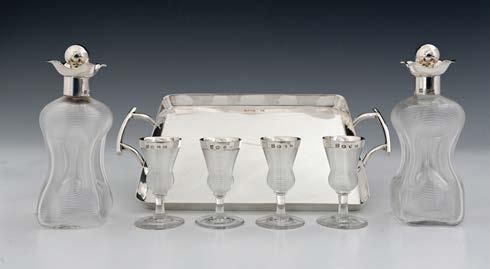
658 Hukin and Heath, a late Victorian silver and glass liqueur set, marked in London and in Birmingham 1896, the underside of the tray engraved with the retailer’s name ‘Wilson & Gill, 134 Regent Street, London.’, comprising two small liqueur decanters and four small tots, in silver mounted glass, the glass with a pattern of horizontal ‘match striker’ lines, height of decanter 14cm, length of tray (across handles) 26cm, weight of tray 428g/13.76ozt approx £500 - £800

659 Hukin and Heath, an Edward VIII silver-mounted wine bucket, with silver swing handle, the glass body decorated with hobnail cutting, and star cut base, the silver mount engraved, “Cheer’O from Carlo”, height (top of rim) 19.8cm, height (top of raised handle) 39.3cm, diameter 19.4cm approx £500 - £800

660
660 Hukin and Heath, a Victorian silver-mounted novelty decanter, modelled in the form of a champagne bottle, with green glass body, the hinged cover with internal cork stopper, London 1897, height 32.6cm approx £600 - £800

661
661 Hukin and Heath, a Victorian silver naturalistic oval fruit dish, with crimped rim and wire-work handle, the foot formed as a creeping plant with gilt flowerheads, London 1888, length 25.5cm, height (to top of handle) 19.5cm, weight 673g/21.63ozt approx £600 - £800

662
662. Hukin and Heath, a Victorian glass claret jug with silver mount and boar’s tusk handle, the hinged flat top cover with a curved flat thumb piece, London 1901, height 26cm approx £600 - £800

663
663 Hukin and Heath, a late Victorian silver eggery, with domed glass lid, and central removable insert with space for six eggs, London 1895, height 18.5cm, weight (sans glass dome) 566g/18.19ozt approx £700 - £1,000

664
664 Hukin and Heath, a silver naturalistic biscuit box or bon bon box, formed as a stylised nut, with swing handle and hinged cover, atop four supports, London 1889, height 15.5cm, weight 439g/14.11ozt approx £800 - £1,000
665. Hukin and Heath, an Edwardian silver-mounted novelty glass decanter, formed as a tyre and with silver steering wheel stopper, the body etched, “When Tyred, Scotch” Birmingham 1907, height 23.5cm approx £800 - £1,200

666
666 Hukin and Heath, a Victorian silver wine bucket or wine cooler, Birmingham 1896, the handles formed from boar’s tusks, height 17.5cm, weight 1,388g/44.62ozt approx £1,000 - £1,500

667 Hukin and Heath, a pair of late Victorian silver-mounted glass liqueur decanters, London 1896, the bodies engraved as the ‘Man in the Moon’, the stoppers formed as crescent moons, the collars engraved with original owner’s initials, height 21.1cm approx (2)
Note: this rare model, pattern 11220, was the smallest of three sizes made by Hukin and Heath.

£1,200 - £1,600
668 Heath and Middleton for Hukin and Heath, a tall late Victorian silver-mounted claret jug, the trumpet-shaped body of clear glass with an entwined green glass snake handle, the silver mounts Birmingham 1896, struck also with French tax marks, the lid of the jug can be raised using the long silver wire handle (stamped with a design registration number 187357), height 36.5cm approx
Note: this model of jug is listed in the Hukin and Heath catalogue as pattern number 10858 priced at £5 4s.
£1,400 - £1,800
669 Hukin and Heath for the Duke of Cumberland (the last Crown Prince of Hanover), a Victorian double magnum silvermounted glass Champagne bottle decanter, London 1892, engraved with a presentation inscription: ‘Herzog V. Cumberland. Steeplechase. Oedenburg. 29th April 1895.’ The glass body engraved with the name of a horse, the neck additionally engraved with the retailer’s name: ‘L. Schuchs, Nachf, Wien.’, height 47.5cm approx
Note: Ernst August, (1845 923), was the eldest child and only son of George V of Hanover and his wife, Marie of Saxe-Altenburg. After the annexation of Hanover by Prussia in 1866 the Duke lived in Austria, latterly in Gmunden. He was the last Hanoverian prince to hold a British royal title and the Order of the Garter. In 1879 Ernst was made honourary Colonel of the Austrian 42nd. Regiment of Infantry, which was re-named after him. In 1878 he married Princess Thyra of Denmark, sister of the Princess of Wales, (later Queen Alexandra). The city of denburg [Oedenburg], now called Sopron, was ceded to Hungary in 1922. The firm of L. Schuch’s, Austrian Imperial Court supplier, was founded in 1831, and was succeeded by G. Edlauer. The firm of L. Schuch’s, Austrian Imperial Court supplier, was founded in 1831, and was succeeded by G. Edlauer. £1,500 - £2,000


670 Dr Christopher Dresser for Hukin and Heath, a late Victorian silver-gilt stacking travelling tea set for two, with fitted case, containing a hot water kettle, and burner, on stand, teapot, tea caddy, sugar bowl, cream jug, a spirit bottle, pair of teaspoons, and sugar tongs, multiple component pieces stack, or fit within one another, for stowage, sponsor’s mark of John Thomas Heath & John Hartshorne Middleton, hallmarked for Birmingham 1900, the caddy/burner hallmarked for Birmingham 1892, the spoons by John Round, hallmarked Sheffield 1899, and the tongs by George Adams, London 1882, also fitted with a gilt plated fold-out tray, and a pair of teacups and saucers by Copeland’s China, multiple pieces adorned with an earl’s coronet, and marked with registered design number 18367, the fitted case with carrying handle, and dual hinged doors, also decorated in tooled gilding with an earl’s coronet, retailed by ‘Leuchars & Son, Geffroy Succr. Paris’, combined weight of hallmarked silver 1,201g/38.61ozt gross, fitted case dimensions 29.8 x 17.6 x 21cm approx
References: Victoria & Albert Museum (online). £2,200 - £2,800 670
Note: According to the Victoria & Albert Museum, “This design by Christopher Dresser was made by Hukin & Heath of Birmingham for the London retailers Leuchars & Son. The design was registered with the Patent Office (Rd. No.18367), which dates it to late 1884... An oriental - in this case, Japanese - influence is also noticeable in the design of the tea kettle, in particular in the wicker handle. It is positioned above the pot, rather than at the side, and can fold down for ease of packing, both aspects characteristic of a traditional Japanese teapot.”
See: Excerpt from the Hukin & Heath catalogue.
671 An archive of documents relating to goldsmiths and jewellers, including invoices from Rundell and Bridge, dated 24th July 1794, Langlands & Robertson of Newcastle, 25th August 1789, and Hunt & Roskell, late Storr, Mortimer & Hunt, 20th July 1850, and others (qty)
679 Elkington, three trade catalogues, “Elkington Plate and Silver”, “Elkington, Mason & Co, Electro Plate Works, Birmingham”, and “Elkington’s Xmas List 1911” (3) £150 - £200
£200 - £250
672 Eric Delieb’s “Scrapbook”, comprising over two thousand photographs clipped from British Antiques Journals, mainly “The Connoisseur”, along with a letter from Eric Delieb to Michael McAleer, dated 3rd July 1973, regarding the “transfer” of the scrapbook, Delieb writes, “...it is my sincere hope that you will find the thousands of illustrations of value—in fact, as much as I—when I was (and still am) learning my vocation.”
£60 - £80
673 A collection of silver trade catalogues, relating to James Deakin & Sons, Haywood and Company, Chatterley & Sons, Charles Green & Co., (qty)
£80 - £120
674 A collection of silver trade catalogues, relating to W.H. Manton, Atkin Brothers, Hawksworth, Eyre & Co., Ltd., George Wostenholm & Son Ltd., Thomas Bradbury & Sons, etc. (qty)
£80 - £120
675 A collection of silver trade catalogues, from The Goldsmiths’ & Silversmiths’ Company, and Walker & Hall Ltd., (qty)
£80 - £120

680
680 Jernegan’s Lottery Interest, an engraving of the amazing Jernegan Wine Cistern, by Gerard Jean-Baptiste Scotin after Gravelot, dated 1735, 48.5cm high, 54.5cm wide, approx (framed)
676 A collection of silver trade catalogues, relating to Vander Roberts & Belk, Mappin and Webb, Garrard, Carrington & Co., and Barnard & Sons Ltd., (qty)
£80 - £120
677 Lady King’s Ledger, an eighteenth-century green leatherbound account book of Lady King, including an entry of December 22nd 1722, “I bought a victualling bill assign’d to my dearest from Benjamin Rutland dated 7 November 1722 no 695 for £619.07.04”
£120 - £150

678 An eighteenth-century invoice from Frederick Kandler, to His Grace the Duke of Norfolk, dated April 11th 1776, totalling £20:9:7 £150 - £200
Note: “Jernegan was approached by Prince ‘Cantomar’, Ambassador of the Russian Empress, who requested a ‘draft’ of the cistern that could be sent to Russia. To have this drawn cost Jernegan an extra five guineas and he thought it prudent to have a copper plate engraved from it to enable him to sent prints of the cistern to other potential clients” (Cameron, 1996). One other is held in the Victoria & Albert Museum’s collection, accession number E.1594-1948.
See: Cameron, P. (1996). enry Jernegan, the Kandlers and the Client who changed his mind Silver Society Journal. £100 - £200

681
681 Jernegan’s Lottery interest, a box and cover, the lid and base inset with two medallions, 39mm diameter, Obverse: Minerva stands amid military trophies, holding a palm front, ‘BOTH HANDS FILLED FOR BRITAIN’ above ‘GEORGE REIGNING’ below. Reverse: Queen Caroline waters a grove of young palm trees, ‘GROWING ARTS ADORN EMPIRE’ above with ‘CAROLINE PROTECTING 1736’ below.
Note: originally purchased for the Lottery Prize of a Silver Cistern, made by Henry Jernegan, a London Banker and Silversmith. The sale of tickets going toward the rebuilding of Westminster Bridge. Some 70,000 tickets were sold with some receiving a medal in return. A similar example, albeit gilt, is housed in the Royal Collection. £200 - £250





682 Jernegan’s Lottery interest, three medallions, 39mm diameter, Obverse: Minerva stands amid military trophies, holding a palm front, ‘BOTH HANDS FILLED FOR BRITAIN’ above ‘GEORGE REIGNING’ below. Reverse: Queen Caroline waters a grove of young palm trees, ‘GROWING ARTS ADORN EMPIRE’ above with ‘CAROLINE PROTECTING 1736’ below, combined weight 61g/1.96ozt approx (3)
Note: originally purchased for the Lottery Prize of a Silver Cistern, made by Henry Jernegan, a London Banker and Silversmith. The sale of tickets going toward the rebuilding of Westminster Bridge. Some 70,000 tickets were sold with some receiving a medal in return. £300 - £500
683. Jernegan’s Lottery interest, three medallions, 39mm diameter, Obverse: Minerva stands amid military trophies, holding a palm front, ‘BOTH HANDS FILLED FOR BRITAIN’ above ‘GEORGE REIGNING’ below. Reverse: Queen Caroline waters a grove of young palm trees, ‘GROWING ARTS ADORN EMPIRE’ above with ‘CAROLINE PROTECTING 1736’ below, combined weight 61g/1.96ozt approx (3)
Note: originally purchased for the Lottery Prize of a Silver Cistern, made by Henry Jernegan, a London Banker and Silversmith. The sale of tickets going toward the rebuilding of Westminster Bridge. Some 70,000 tickets were sold with some receiving a medal in return. £300 - £500
684 Jernegan’s Lottery interest, three medallions, 39mm diameter, Obverse: Minerva stands amid military trophies, holding a palm front, ‘BOTH HANDS FILLED FOR BRITAIN’ above ‘GEORGE REIGNING’ below. Reverse: Queen Caroline waters a grove of young palm trees, ‘GROWING ARTS ADORN EMPIRE’ above with ‘CAROLINE PROTECTING 1736’ below, combined weight
61g/1.96ozt approx (3)
Note: originally purchased for the Lottery Prize of a Silver Cistern, made by Henry Jernegan, a London Banker and Silversmith. The sale of tickets going toward the rebuilding of Westminster Bridge. Some 70,000 tickets were sold with some receiving a medal in return.
£300 - £500
685 Jernegan’s Lottery interest, three medallions, 39mm diameter, Obverse: Minerva stands amid military trophies, holding a palm front, ‘BOTH HANDS FILLED FOR BRITAIN’ above ‘GEORGE REIGNING’ below. Reverse: Queen Caroline waters a grove of young palm trees, ‘GROWING ARTS ADORN EMPIRE’ above with ‘CAROLINE PROTECTING 1736’ below, combined weight 61g/1.96ozt approx (3)
Note: originally purchased for the Lottery Prize of a Silver Cistern, made by Henry Jernegan, a London Banker and Silversmith. The sale of tickets going toward the rebuilding of Westminster Bridge. Some 70,000 tickets were sold with some receiving a medal in return.
£300 - £500
686 Jernegan’s Lottery Interest, a catalogue of the 1736 Jernegan lottery sale, “For sale. A large and elegant variety of gold and silver plate, jewels, medals, and other rich and valuable curiosities, by Hen. Jernegan, banker”
Note: originally purchased for the Lottery Prize of a Silver Cistern, made by Henry Jernegan, a London Banker and Silversmith. The sale of tickets going toward the rebuilding of Westminster Bridge. Some 70,000 tickets were sold with some receiving a medal in return. According to research conducted by Peter Cameron, only one other copy of this catalogue is known. £500 - £700

687 A George III silver cased medallion, William Burwash & Richard Sibley I, London 1809, inscribed ‘Presented by John Lodge Esq. to Joseph Taylor Esq. Steward to the Loyal Independent Livery of London’, diameter 4.1cm, weight 14g/0.45ozt approx £60 - £80
688 Two nineteenth-century silver prize medals, comprising a cased ‘1839 Reward of Merit’, hallmarked London 1838, sponsor’s mark rubbed, diameter 5.2cm, together with a Scottish prize for ‘Gymnastic Exercises’, presented ‘By the six Edinburgh Fire Insurance Companies’, hallmarked Adam Elder, Edinburgh 1827, diameter 5.3cm, combined weight 79g/2.53ozt approx (2) £80 - £120
689 A Victorian silver prize oar, ancaster Regatta 1857, Gentlemen Amateur Race George Adams, London 1857, together with a smaller cased ‘2nd Prize’ unmarked silver oar, the case with an applied plaque for ‘Wadh. Coll. Scratch Fours 1853”, length of largest oar 24.6cm approx (2) £120 - £180

692
692. Three Victorian silver prize medals for ‘The Wirral Farmers Club’, ‘Maker of the Best Two Horse Swing Plough’, 185356, two cased, and one other, diameter of larger 5.4cm, combined weight 113g/3.63ozt approx (3)
£120 - £150


691
£40 - £60
690 A Victorian silver medallion, “Northumberland Cricket Club, Opening Day 1863, Athletic Games”, “Throwing Cricket Ball, Won by, Joseph Robson”, John Walton, Newcastle 1837, diameter 4cm, weight 5g/0.16ozt approx
691 A nineteenth-century silver “Stadium” ticket, with engraved inscription, “No 50 Patron`s Transferable Medal Admitting daily one Lady & one Gentn for one year renewable 25 March 1835”, named on edge, “W. Baker Esq”, 1831, by Benjamin Wyon, diameter 3.1cm, weight 14g/0.45ozt approx £60 - £80
693 York interest, two silver medals, one a race ticket for Beverley Race Course, stand No. 112 for Robert Grimston circa 1770, apparently unmarked, length 4.1cm, the other for Driffield Anglers, sponsor’s mark of James Barber, hallmarked at York 1856, engraved for John Wilmot (nephew of Robert Grimston), diameter 4.5cm, combined weight 19g/0.61ozt approx (2)
Note: for the relationship between Robert Grimston, whose sister, Lucy married Sir Robert Wilmot, see the Grimston family papers in the Hull Record Office £500 - £800
694 The Horticultural Society of London, a medal depicting Joseph Banks, by W. Wyon, engraved on the reverse as a prize medal awarded to ‘Mr. Thomas Gibbs for Apples, Pears and Peaches, Exhibited Sepr. 4 1827’, diameter 3.8cm, weight (sans case) 34g/1.09ozt approx
£80 - £120
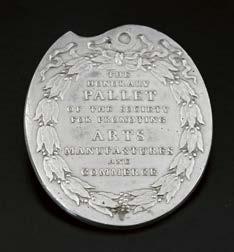



695. An early nineteenth-century unmarked silver Arts prize medal, ‘The Honorary Pallet of the Society for Promoting Arts Manufactures and Commerce’, the obverse, ‘To Miss Hilare Barlow MDCCCVII for a Drawing of a Landscape’, circa 1807, length 6.2cm, weight 70g/2.25ozt approx
Note: Miss Hilare Barlow was awarded ‘the greater silver palette’ for her landscape. In 1808 a Miss Elizabeth Ann Barlow was awarded ‘the smaller silver palette’ for her drawing of a landscape. It seems certain that these sisters were the daughters of Admiral Sir Robert James Barlow and his wife, Elizabeth Ann [Garrett] and that Hilare married 1st George Ulric Barlow [1817], 2nd. William Nelson, Earl Nelson, Duke of Bronte [1829], 3rd George Thomas Austen Knight [1837]. £80 - £120
696 An 18th-century unmarked silver pierced and engraved Masonic jewel for a member of the Union Lodge in York, bearing the name of Michael Coultate, length 6.3cm, weight 20g/0.64ozt approx
Note: the Union Lodge in York was founded in 1777. It was re-named as the York Lodge 236 in 1870. Michael Coultate, a vintner of Goodram Gate, York (he was later in Monkgate and Micklegate). Coultate joined the lodge in 1784, aged 26, and his house was used as a meeting place for the lodge in 1789/90. He had married Dorothy Place at St. Maurice near the Walls (now demolished) in 1780. He is still listed in York pollbooks in 1835. £400 - £600
697 A George III silver engraved Rochdale Theatre Ticket, circa 1794, ‘No. 2’, ‘Mr. Hamer.’, apparently unmarked, length 4.5cm, weight 7g/0.22ozt approx £300 - £400
698 Sheffield interest, an unmarked silver subscriber’s ticket for the Sheffield Theatre, engraved ‘Proprietor’ and on the reverse stamped ‘No. 4’, circa 1835, length 3cm, weight 7g/0.22ozt approx
Note: the Theatre, later known as the ‘Theatre Royal’, was funded by a group of thirty-six subscribers, each share costing approximately £100, and the foundation stone for the theatre building on the intersection of Tudor Street, Norfolk Street and Arundel Street, was laid in August 1777. £250 - £350
699 A George III silver jewel for the Tewkesbury Lodge of Oddfellows, Number 5, ‘Holland Griffith No. 32’, London 1792, by Peter and Ann Bateman, the reverse of the jewel is engraved with a coat-of-arms for Peter Moore and his wife, Sarah, the daughter of Lt. Col. Richmond Webb, length 5.3cm, weight 21g/0.67ozt approx £400 - £600
700 Three Victorian silver school prize medals, to include a Scottish example from Free Grammar School, for the best scholar in English, hallmarked Robert Scott, Glasgow 1867, diameter 4.4cm, together with a Collegiate School Prize ‘For Good Behaviour’ 1845, diameter 4.6cm, and a ‘General Excellence at Undercraig School Langbank’, 1st prize medal, 1862, diameter 4.3cm, combined weight 54g/1.73ozt approx (3) £100 - £200



701 Three Victorian silver sporting prize medals, to include a Victorian unmarked medal for quoits, 1864, with a presentation inscription by John Craik of Manchester to Southwick Quoiting Club, the reverse with a list of winners from 1901 to 1920, diameter 6.3cm, together with a cased prize medal engraved to the ‘Blairgowrie Bowling Club for Competition 1871’, diameter 6cm, and a Victorian Eton College rowing ‘House Fours 1872’ medal, diameter 3.7cm, combined weight 140g/4.50ozt approx (3) £120 - £150

702. A late Victorian silver Scottish prize medal,1899, cased, for the ‘Best One Year Old Filly’ at Kilmarnock Farmer’s Society, won by . C. Cunninghame Esq. struck with a maker’s mark only for John Cameron and Son, of King Street, Kilmarnock, length 8.7cm, weight (sans case) 65g/2.08ozt approx £120 - £180

703. A Victorian silver agricultural prize medal, London 1853, George Richards, in a retailer’s case for John Hall of Manchester, the medal engraved as a presentation from anchester Poultry Show 1854 awarded to John Harrison Junr. of Snelston Hall, Esquire, for the best pen of black Spanish fowls the reversed engraved he judges reported that a better collection of black Spanish poultry had never been in the United Kingdom diameter 8.5cm, weight (sans case) 73g/2.34ozt approx £150 - £250

704
704 The Horticultural Society of London, a medal engraved on the reverse as a prize medal awarded to ‘Mr. Thomas Gibbs for various grass seeds 1839diameter 4.8cm, together with a William IV silver Smithfield Club Medal, London 1835, Rawlings and Summers, engraved as prize for Class VI, a Heifer, Christmas 1835, and awarded to the Breeder, Mrs. Strickland, Tewkesbury Gloucestershire, and two other prize medals, for the Patna Cattle Show Best one year old bull, and East Chester Ward Agricultural Society, first prize for ploughing 1852’, (4) £180 - £220

705 Sir Robert Peel [1788-1850; Prime Minister1835-6 and 1841-6], a silver prize medal from Whalley Agriculture Society, instituted in 1810, awarded to ‘Robert Peel, Esq., for laying down 14 Acres of Land with Pasturing Seeds, 1816.’ In original red morocco fitted case, diameter 4.7cm, weight (sans case) 44g/1.41ozt approx £200 - £300 705
706 A George IV silver medal, London 1824, Rebecca Emes and Edward Barnard, engraved on one side ‘This Medal with Five Pounds, was Presented to James Russell by several Ladies and Gentlemen of Hull as a reward for his Exertions in saving a Child from Drowning August 12th, 1824’, length 6.3cm, weight 31g/0.99ozt approx £280 - £320

707 An 18th-century oval society medal, circa 1780, engraved on one side with a pair of clasped hands below a banner, ‘The Friendly Bachelors’, engraved on the obverse with Adam and Eve being expelled from the Garden of Eden below ‘Ex Illis Exemplum Sume Tibi’, length 3.4cm, weight 9g/0.28ozt approx £300 - £400
708 A Scottish silver Clan brooch, for Muir, Peter Henderson Ltd., Glasgow 1937, length 6.5cm approx £70 - £90


709 The Brotherly Society, a George III silver medal, Hester Bateman, London circa 1780, engraved on one side with two gentlemen clasping hands below the motto, ‘The Brotherly Society’ and above ‘Love and Unity’, the reverse of one with monogram initials ‘TG’, or similar, length 7.3cm, weight 19g/0.61ozt approx
See: Davis, W.J. and Waters, A.W. (1922). Tickets and Passes of Great Britain and Ireland £400 - £600
710 The Brotherly Society, a George III silver medal, Hester Bateman 1781, engraved on one side with two gentlemen clasping hands below the motto ‘The Brotherly Society’ and above ‘Love and Unity’, the reverse with monogram initials ‘JE’, ‘John Edgerly’, ‘Entered December 29 1777.’, length 7.2cm, weight 15g/0.48ozt approx
See: Davis, W.J. and Waters, A.W. (1922). Tickets and Passes of Great Britain and Ireland £700 - £900

711 Queen Victoria’s Golden Jubilee, a substantial silver commemorative Jubilee container in the form of a classical Temple, imitating the Choragic Monument of Lysicrates near the Acropolis in Athens, London 1888 by Willian Hunter and Son, the lift-off lid is set with the Jubilee Medal in silver under glass and the base of the temple is engraved with texts in English, Latin and Greek, relating to the Queen: three with the initials ‘E.H.B.’ at the base and one, ‘S.A.T.Y.’”, height 20.8cm, weight 1,607g/51.66ozt gross all-in approx £1,200 - £1,500

712 A Scottish unmarked silver cloak badge, modelled in the form of the armorial crest of Rogers, within a garter surround, the obverse engraved ‘Alexr. Radcliffe’, diameter 8.5cm, together with a smaller example, hallmarked for Brook & Son, Edinburgh 1915, combined weight 98g/3.15ozt approx £100 - £150

713 A George III dining club badge in the form of a miniature griddle, engraved with contemporary initials and the motto onum Amicitiae et Gloria Solomonis. Apparently unmarked, circa 1800, length 8.6cm, weight 24g/0.77ozt approx £120 - £180

714 Anglesey Hunt, a Victorian silver commemorative hunt badge in the form of a frosted silver horn applied with a hound, London 1888, GC, possibly for George Chandler of Chandler and Williams, the end of the horn engraved ‘1859 Captain Thomas Lewis Hampton of Henllys Comptroller Miss Maria Emma Elizabeth Griffith of Carreglwydd, Lady Patroness’, length 9.7cm, weight 44g/1.41ozt approx £150 - £200
715 A George IV cast and engraved silver badge, modelled in the form of a bird in flight, Thomas Harper, London 1823, length 7.3cm, weight 56g/1.80ozt approx
717 Banf f, a nineteenth-century Scottish provincial silver friendly society badge, William Simpson, Banff, circa 1830, the pierced badge is engraved ‘Standard Bearer of Solomon’s Lodge Banff 1778’, around a flag with a dove of peace in the centre and above, below two suspension holes, with ‘Nos More Adam Vivimus Tillure Colenda.’, length 10.7cm, weight 36g/1.15ozt approx
£300 - £500
Note: the badge is presumably a Masonic collar jewel, but, if a dove, the bird shows no sign of ever having an olive branch in its beak.
£150 - £250

716 A George III silver pierced badge with the motto, ‘Upon My Honor Quid Rides’, with the date 1798, apparently unmarked, length 6.5cm, weight 17g/0.54ozt approx £300 - £500


718
718 A Victorian Apprentices Regatta silver arm badge, London 1881, Stephen Smith, struck on the reverse with an incuse number - 7158, the oval badge, with repousse decoration is engraved with ‘The Tower of London St. Botolph Aldgate & Wapping Apprentices Regatta’ and ‘Manager William Moscrop’ around an engraved view of the Tower of London and Water Gate above a plain area engraved ‘Won By’ but with no engraved name, the outer rim of the badge is pierced with small holes to allow the badge to be sewn to a sleeve, the back has also two silver wire loops to enable the attachment, length 17.2cm, weight 157g/5.04ozt approx
£500 - £800

719
719 The Free and Easy Johns, a George III society badge or jewel, the silver frame set with paste stones surrounding an oval painted image, depicting a stone plinth set in a landscape supported by two leopards with a banner ‘Free and Easy’ and a cartouche ‘W. Hay 1777 Pinxt.’, on the reverse the gilt back is engraved: ‘Presented to the Society of Free and Easy John’s LODGE No. 2 at Dover by Bros. Grubb & Loten of the Grand Lodge 18th Decr. 1777.’, length 9.9cm approx
Note: Upon the plinth stands a barrel, upright, with a lidded Tankard and a blue banner with ‘Laetitia et Amicitia’, with a jewel suspended from it and an oval with crossed sword and sceptre above clasped hands, either side of the barrel stand two infant figures, one holding a rod topped with a dog’s head, the other being a young Bacchus, above the raised hand of Bacchus a cherub flies, holding a wreath in one hand and a pole with a cap of Liberty in the other. [Laetitia was the Roman goddess of gaiety or happiness].

£700 - £900 720
720 A George II silver alms house badge with the arms granted to the Banks family of Beck Hall, Yorkshire and Revesby Abbey Lincolnshire, by Edward Vincent, London 1728, length 10.6cm, weight 156g/5.01ozt approx
Note: this Badge was one of ten by Vincent made in 1728/9 for Joseph Banks (16951741) in fulfilment of his father’s will.
£1,200 - £1,800
721 Rowing Interest, a pair of Victorian silver rowing prizes in the form of an oar and a rudder, each in its original box, London 1864, Richards and Brown. The cases with unmarked silver plaques engraved: ‘Nautilus Rowing Club, 1864, Challenge Pairs.’, length of oar 18cm approx £400 - £600
722 Two plated items to include a twohandled cup, inscribed ‘Goole & Thorn D.F.A. Minor Cup’, height 14cm, together with a desk stand (2) £80 - £120

723 Four Victorian plated naturalistic bottle coasters, the sides of each decorated with fruiting vine, with a turned wood base, and central boss, Elkington & Co., circa 1849, diameter 14cm, height 6cm approx (4) £200 - £300 724

724 William Staniforth’s biscuit box, a silver plated mechanical biscuit box with gilt interior presented by Fenton Brothers for Christmas 1877 ‘as a Memento of the Success of his Design’, ensuite with an archive of family papers, height 24.5cm approx William Staniforth [1840-1902], the son of an Innkeeper, was born at Handsworth and apprenticed in 1854 to Townend and Schofield, die-sinkers in Sheffield. On completion of his apprenticeship, he was selfemployed for a period before joining Fenton Brothers at their South Moor Works in 1870 as a designer, modeller and die-sinker. He rose to become managing director of Fentons and a partner in the business. By 1894, the firm had introduced a triplecompartment version of the ‘biscuit satchel’. Later examples of these biscuit boxes are usually also stamped ‘Staniforth’s Patent’. £200 - £250
725 Asprey, six toast racks, with warming stand and burner, each with central wooden handle, marked ‘A&Co.’, height of tallest 19cm approx (6) £200 - £250
726 Hamilton & Inches, a leathercovered glass hip flask, with a silver-plated hinged cover, secured by a bayonet fitting, height 22.5cm approx £100 - £150
727 Hukin and Heath, a biscuit box, pattern number 1928, and gilt ewer, pattern number 1891, each in the ‘Persian’ style, circa 1875, height (jug) 24.5cm approx (2)
£20 - £40

728 Hukin and Heath, an electroplated and bark wood salad bowl, en suite with matching salad servers, circa 1900, diameter 25.5cm approx
£100 - £150
729 Hukin and Heath, a golfing interest cut glass and silverplated cigarette holder, with ‘19th-hole’ in enamelled colours, pattern number 1630, the glass by Stevens and Williams, circa 1920, height 8.1cm approx
£50 - £80
730 Hukin and Heath, an electroplated tilt lidded jug, circa 1900, together with a patent pivoting tazza, pattern number 1318, diameter 28.5cm approx (2)

£50 - £70
731 Hukin and Heath, a silver-plated and hammered glass biscuit jar, circa 1890, pattern number 4577, height 15cm approx
£60 - £80
732. Hukin and Heath, an electroplated and Coalport jug, circa 1900, pattern number 9204, height 15.3cm approx
£60 - £80
733 Hukin and Heath, two electroplated pepper grinders, one novelty example modelled in the form of a coffee grinder, pattern number 17473, circa 1900, height 9.5cm, the other with a turned ebonised finial, with a mechanism by Peugeot, height 9.5cm approx (2)
£60 - £80
734 Hukin and Heath, a silver-plated and ceramic eggery, circa 1900, the four egg cups with ‘clip in’ ceramic bases by Coalport, together with a pair of similar egg cups, pattern number 18112, height (of eggery) 17cm approx (3)
£70 - £90
735. Hukin and Heath, an electroplated spoon warmer, with a ‘hammered’ finish, pattern number 11462, circa 1900, length 16.9cm approx
£70 - £90

736 Hukin and Heath, two naturalistic electroplated baskets, pattern numbers 13337, and 5386, circa 1900, height of tallest 21.5cm approx (2)
£70 - £90
737 Hukin and Heath, two naturalistic hammered pieces, to include an ice bucket, c.1890, and leaf-form dish, pattern numbers 13389, and 4373, height (of bucket) 13.5cm approx (2) £70 - £90
738 Hukin and Heath, an electroplated ‘TOAST’ novelty toast rack, pattern number 2316, circa 1900, length 19.5cm approx
£70 - £90
739 Hukin and Heath, an electroplated ‘TOAST’ novelty toast rack, pattern number 4338, circa 1900, length 12cm approx
£70 - £90
740 Hukin and Heath, an electroplated ‘TOAST’ novelty toast rack, registered design number 88793, retailed by Thornhill of Bond Street, circa 1900, length 10.2cm approx
£70 - £90
741 Hukin and Heath, two electroplated toast racks, pattern numbers 6454, and 6458, circa 1900, length (of larger) 23cm approx (2)
£70 - £90
742. Hukin and Heath, an electroplated and glass serving dish, the handle formed as a raised bifurcated foliate tendril, pattern number 5051, height 14cm approx
£70 - £90
£70 - £90
743 Hukin and Heat h, two silver-plated asparagus serving dishes, pattern numbers 15050, and 17569, circa 1910, length (of longest) 44.7cm approx (2)
744 Hukin and Heath, two electroplated pedestal bowls, pattern numbers 17186 and 17187, circa 1890-1910, diameter of larger 25cm approx (2)
£70 - £90
745 Hukin and Heath, an electroplated dish with two boats, and glass shell, pattern number 9470, circa 1900, height 16.5cm approx
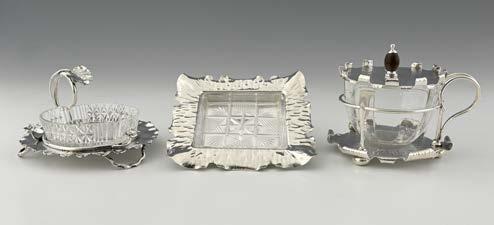

£80 - £120 746
746 Hukin and Heath, a silver-plated smokers’ compendium, together with a ‘hammered’ kettle, and sugar bowl, pattern numbers 6524, 7880, and registered design 137119, height (of kettle) 18.5cm approx (3)
£80 - £120
747 Hukin and Heath, two silver plate mounted glass jam pots, pattern numbers 22093 and 18388, each with patented opening mechanism, circa 1920, height (to top of raised handle) 15cm approx (2)
£80 - £120
748 Hukin and Heath, two bowls, each with a scalloped rim, and a hammered body, registered design numbers 15483, and 5392, respectively, diameter (of larger) 25cm approx (2)
£80 - £120
749 Hukin and Heath, three electroplated egg cup stands, pattern numbers 6521, 6520, 7931, respectively, circa 1890, height 8cm approx (3)
£80 - £120
750 Hukin and Heath, five hammered beakers, together with a heart-shaped dish or stand, pattern number 7559, circa 1890, length of dish 21.5cm approx (6)
£80 - £120
751 Hukin and Heath, a pair of Wedgwood beakers, and a jug, each with a gilt metal mount, circa 1885, height of jug 20cm approx (3)
£80 - £100
752. Hukin and Heath, three electroplated naturalistic salvers or waiters, pattern numbers 3482, 4139, and 2221, circa 1890, diameter (of largest) 29cm approx (3)
£80 - £120
753 Hukin and Heath, an electroplated and glass spirits or liqueur set, comprising a jug and eight shot glasses, retailed by ‘Albert Barker 5 New Bond St London W’, made by Hukin and Heath but unmarked, circa 1890, height of jug 14.5cm approx (9) £80 - £120
754 Hukin and Heath, two electroplated butter dishes, circa 1890, each with a glass insert, pattern numbers 7928 and 5001, together with one other unmarked example, with turned wood finial, height (of tallest) 10.3cm approx (3)
£80 - £120
755 Hukin and Heath, three electroplated dishes, pattern number 16584, circa 1910, and a salver, diameter 40.5cm approx (4)
£90 - £120
756 Hukin and Heath, a basket with fixed handle and scalloped rim, and two bowls, pattern numbers 2879, 8518, and 21822, respectively, circa 1880-1910, height (of tallest) 14cm approx (3)
£90 - £120

757
757 Hukin and Heath, an egg coddler, with textured exterior, ensuite with burner, and fitted interior, height 22cm, together with two naturalistic four-cup egg cruets, circa 1880 (3)
£100 - £150

758 Hukin and Heat h, two naturalistic four-cup egg cruets, together with a further example by Goldsmiths and Silversmiths, circa 1880, height 8.3cm approx (3)
£100 - £150

759
759 Hukin and Heath, a late nineteenth-century electroplated novelty spoon warmer, modelled in the form of a nautilus shell, the textured ceramic body by Coalport, pattern number 10857, circa 1891, together with a flower basket, with Coalport body, pattern number 7842, both pieces struck with the eagle mark, height 19cm approx (2)
£100 - £150

760
760 Hukin and Heath, a plated teapot designed by Dr. Christopher Dresser, with rattan-covered handle, and detachable cover, the underside with design registration lozenge, height 7.5cm approx
£100 - £150
761 Hukin and Heath, a pair of electroplated ‘TOAST’ novelty toast racks, pattern number 10499, circa 1900, length 11cm approx (2)
£100 - £150
762 Hukin and Heath, a silver plated ‘Persian’ style box and cover, pattern number 1636, circa 1875, height 10cm approx
£100 - £120
763 Hukin and Heath, a toast rack and warmer, with burner, by Asprey’s, engraved “A gift from the Earl of Lonsdale, Xmas 1910”, height 19cm approx
£100 - £150
764 Hukin and Heath, two grape dishes, each with hammered detail to the exterior, pattern numbers 6523, and 3671, respectively, circa 1890, height 20.5cm approx (2)
£100 - £150
765 Hukin and Heath, two naturalistic hazel leaf chambersticks, each with conical snuffer, and integrated match holder with striker, pattern number 7936, height (of tallest) 9.5cm approx (2)
£100 - £150
766 Hukin and Heath, three silver-plated crumb trays, circa 1900, to include a pair of hazel leaf examples, pattern number 5163, and a ‘hammered’ crumb tray, 5460, length (of larger) 31cm approx (3)
£100 - £150
767 Hukin and Heath, a trio of naturalistic silver-plated crumb trays, circa 1900, pattern number 4414, together with another tray, marked for Henry Wilkinson & Co. of Sheffield, length (of larger) 27.3cm approx (4)
£100 - £150
768 Hukin and Heath, a cased silver-plated and ceramic child’s nursery rhyme set, comprising mug, plate, and spoon, together with an egg cup, and a mug, the ceramic marked Royal Doulton, circa 1925, height (of mug) 9cm approx (3) £100 - £150
769 Hukin and Heath, a collection of silver and plated metalmounted ceramic table wares, to include a fruit set, milk jugs, tea cups, and a box and cover, together with a three-piece tea set, with metal mounts marked ‘B.E.P.W.F’, Berliner Elektroplated Warenfabrik, the ceramics by Coalport, circa 1890, faults (qty) £100 - £150
770. Hukin and Heath, three entree dishes, each with hammered textured finish, pattern numbers 4425, 8770, and 9296, circa 1900, length (of largest) 28cm approx (3) £100 - £150

771
771 Hukin and Heath, a silver-plated ‘hammered’ pail and dish, pattern numbers 4628 and 4709, circa 1885-1900, diameter of dish 18cm approx (2)
£100 - £150
772. Hukin and Heath, four naturalistic ‘hammered’ dishes, to include a pair, with pattern number 13869, and two others, pattern numbers 13870 and 13866, length of largest 27.1cm approx (4) £100 - £150
£100 - £150
773 Hukin and Heath, three electroplated naturalistic baskets, to include one example with a fixed acorn-decorated handle, pattern numbers 4888, 3951, and 12521, circa 1890-1910, height of tallest 20cm approx (3)
774 Hukin and Heath, a pair of electroplated naturalistic baskets, pattern number 4367, circa 1885, height 19.8cm approx (2)
£100 - £150
775 Hukin and Heath, a strawberries and cream set, with ‘hammered’ finish, the central bowl flanked by a sugar bowl and cream jug, secured in a frame formed as a foliate tendril, pattern number 12656, together with a fruit stand, pattern number 6491, height 14.3cm approx (2)
£120 - £150

£120 - £180
776 Hukin and Heath, an electroplated asparagus dish and butter boat, pattern number 9540, circa 1900, length 44.2cm, together with a rectangular asparagus dish, pattern 6526, length 18cm approx (2)
782 Hukin and Heath, an electroplated egg boiler, with stand and burner, pattern number 5114, circa 1885, together with a tilting jug, pattern number 20139, circa 1905, height 19cm approx (2)
£140 - £180
777. Hukin and Heath, five electroplated hammered naturalistic crumb scoops, circa 1900, length (of largest) 35cm approx (5)
£120 - £180
778 Hukin and Heath, three naturalistic electroplated pedestal dishes, pattern numbers 4888 and 5392, circa 1890, diameter of largest 28.2cm approx (3)
£120 - £180


£120 - £180
779. Hukin and Heath, a plated biscuit barrel and cover, the textured body with dual looped handles formed as foliate tendrils, with turned ebonised finial, pattern number 9464, height 15.5cm, together with a pair of fern pots, circa 1890, pattern number 17624, height 10.2cm approx (3)
780 Hukin and Heath, two patented collapsible cake stands, one circular and one rectangular, pattern number 21607, and 143711, respectively, circa 1900 and 1930 respectively, length (of rectangular) 19.5cm approx (2)
£120 - £180
781 Hukin and Heath, two glass double dishes, and a single glass dish, each with an electroplated cover, pattern numbers, 116, 21055, and 12651, respectively, height (of taller) 16cm approx (3)
£120 - £180
783. Hukin and Heath, an electroplated double sauce tureen and cover, with ladles, pattern number 4370, length (across handles) 32.5cm, height 18cm approx
£150 - £200
784 Hukin and Heath, a grape stand, with hammered finish, pattern number 6971, and a rectangular dish, pattern number 9380, circa 1900, height (of tallest) 24cm approx (2)
£150 - £250
785 Hukin and Heath, a plated serving tray, of hearth-shaped form, the body with textured decoration, and boar’s tusk handle, the underside marked, ‘H&H’ 10313, length (to tip of handle) 38.5cm, together with a crumb tray of similar form, length (to tip of handle) 14.5cm approx (2)
£150 - £200
786 Hukin and Heath, five silverplated hammered naturalistic dishes, pattern numbers 5394, 8409, 8408, 8070, length (of largest) 25cm approx (5)
£150 - £200
787 Hukin and Heath, a plated four egg cup stand, registered design number 264946, circa 1900, together with a smoker’s compendium with Doulton ceramic standing figure of Mr. Micawber, circa 1920, pattern number 312, and a set of six silver-plated novelty ramekins, pattern number 16669, circa 1900.
£150 - £200
788 Hukin and Heath, four silver-plated naturalistic chambersticks, pattern numbers 6977, 11632, 7251, and 5123, circa 1900, height (of tallest) 8.2cm approx (4)
£150 - £200
789 Hukin and Heath, a pair of electroplated and glass claret jugs, with clip on mounts, pattern number 19058, height 21.8cm approx (2)
£180 - £220
790 Hukin and Heath, three electroplated hammered rectangular trays, together with asparagus servers, and tongs, pattern numbers 16128, 15853, 8473, 8722, circa 1900, length (of largest) 59.5cm approx (6)
£180 - £220
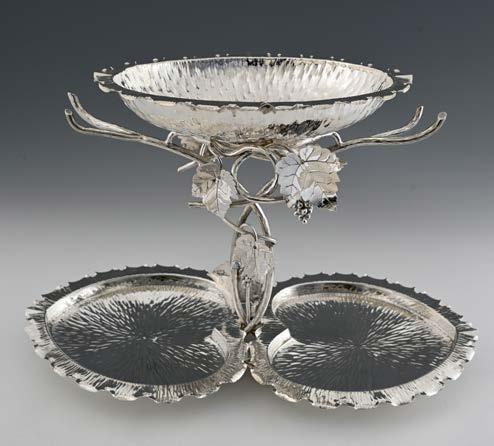

794
791. Hukin and Heath, a grape stand, with hammered finish, with naturalistic central stem, flanked by two heart-shaped removable dishes, and a central removable bowl, pattern number 7090, circa 1890, height 29.2cm approx
£180 - £220
792 Hukin and Heath, a table service with a centrepiece, comprising one large dish, six smaller dishes, pattern number 14854, and a dish with two bowls and a central fixed handle, pattern number 21530, the centrepiece with three smaller baskets, pattern number 21569, circa 1900, height (of centrepiece) 31cm approx (9)
£200 - £250
793 Hukin and Heath, a plated cylindrical naturalistic biscuit box or bon bon box, with swing handle and hinged cover, atop four supports, the underside marked ‘H&H’ 5385, height 24.5cm approx
£200 - £250

795
794 Hukin and Heath, an electroplated, patented bottle cradle, circa 1900, with textured exterior, and tilting mechanism operated with a crank, height 31cm approx
£200 - £250
795. Hukin and Heath, an electroplated lemon squeezer, the central cast lemon constructed in two pieces and secured with a hinge and clip, the interior with a screw thread wooden plunger, pattern number 4771, height 29.5cm approx
£200 - £250
796 Hukin and Heath, a large round Lotus dish punch bowl, pattern number 4141, ensuite with an unmarked ladle, circa 1885, diameter 25.7cm, height 11cm approx (2)
£200 - £250
797 Hukin and Heath, a group of silver-plated naturalistic ‘hammered’ dishes, to include a set of five two-handled bowls, pattern numbers 5867, 10672, and 5866, diameter (of larger) 26.3cm approx (7)
£200 - £250
798 Hukin and Heath, a set of five electroplated water lily bowls, pattern number 2867, circa 1880, height 10cm approx (5)
£200 - £250
799 Hukin and Heath, an electroplated aesthetic style biscuit box, pattern number 2157, with a sugar scuttle and scoop, 2299, circa 1880, together with a round salver atop three peg feet, pattern number 1998, circa 1880, diameter 34cm approx (3) £200 - £250

802 Hukin and Heath, a pair of small ‘hammered’ jugs, of circular waisted form with ‘self-righting’ lids and boar’s tusk handles, circa 1890, pattern number 13571, size ‘2’, height 14.8cm, maximum diameter 11.8cm approx (2) £250 - £300
£200 - £250
800. Hukin and Heath, in the style of Dr. Christopher Dresser, a gilt metal-mounted Coalport lemonade jug, with a patented ice well, pattern 8425, together with a green Coalport and gilt-metal water jug, pattern number 12470, circa 1890, height of larger 27.2cm approx (2)
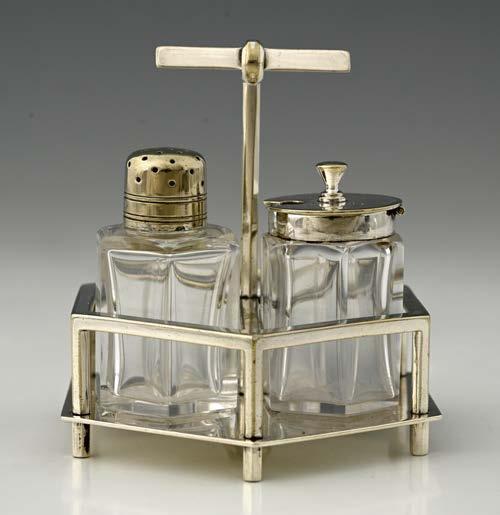

803
803 Hukin and Heath, a pair of covered vegetable dishes, one with a pea pod finial, pattern no. 5018, size ‘1’, the other with a foliate finial, pattern no. 14877, circa 1890. diameter 26.5 cm, height 14.5cm and 15.2 cm, respectively, approx (2) £250 - £300
801 Hukin and Heath, designed by Dr. Christopher Dresser, a Victorian electroplated cruet, with hexagonal glass condiments, design registration lozenge, dated 11 April 1878, pattern number 1867, height 10.1cm approx
£250 - £350

804
804 Hukin and Heath, an electroplated five-piece tea and coffee service, en suite with a tray, with hammered textured decoration, the tray with pattern number 4156, circa 1900, length of tray 58cm, height of coffee pot 23cm approx (6) £250 - £350
805 Hukin and Heath, three silver-plated and bark wood pieces, to include a lidded ale jug, pattern number 3351, a cylindrical mug, 3330, and a bowl, 3437, circa 1890, height (of tallest) 22cm approx (3)
£250 - £300
806 Hukin and Heath, a late Victorian wood and electroplated bottle holder, the design attributed to Dr Christopher Dresser, pattern number 3098, the oak body with rod handle, and stamped marks, circa 1885, height 17.5cm approx £250 - £300
814 Hukin and Heath, a group of hammered naturalistic electroplated bowls, ladles, and sifters, pattern numbers 5866, 3500, 5840, 16895, 5829, circa 1890, height (of tallest) 14.2cm approx (21) £300 - £350
807 Hukin and Heath, a late Victorian bark wood and electroplated bottle holder, pattern number 3350, circa 1890, height 16.5cm approx
£250 - £300
808 Hukin and Heath, an electroplated and bark wood biscuit box, with faux boar’s tusk handle, pattern number 3297, registered design number 17037, circa 1885, length 19.3cm, height 13.3cm approx
£250 - £300
809 Hukin and Heath, an electroplated and bark wood biscuit box, with faux boar’s tuck handle, pattern number 3297, registered design number 9429, width 19.2cm, height 13.5cm approx
£250 - £300

815
815 Hukin and Heath, a suite of eight coloured egg cups, three with yellow ceramic bases, two pink, two blue, and one green, seven marked H&H, one marked Mappin & Webb, patent number 2070-06, seven ceramic bases by Royal Doulton, one Jackson & Gosling, circa 1920, height 7cm approx (8) £300 - £350
£250 - £350
810 Hukin and Heath, a group of naturalistic hammered serving pieces, to include salad servers, and punch ladles, together with a pocket watch stand and magnifier, circa 1900, pattern number 8489 (13)
811 Hukin and Heath, a pair of plated pitchers, the flared cylindrical bodies with textured decoration, each with a flat cover secured by a swivel and counter-weight, and boar’s tusk handle, marked on the underside, ‘H&H’ 13572, height 18.5cm approx (2)
£250 - £350
812 Hukin and Heath, a silver-plated and ‘hammered’ glass claret jug, with a wooden simulated tusk form handle, pattern number 3869, circa 1890, height 24.2cm approx £280 - £320
816 Hukin and Heath, an electroplated suite of hammered baskets, comprising two larger fixed handle baskets, pattern number 8074, a mid-size basket, 5055, and six smaller baskets, pattern number 7644, length of larger 23.5cm approx (9) £300 - £500
817 Hukin and Heath, four spirit lamps, “Hinks’s Duplex Patent”, with hammered finish, pattern numbers 6352, 5618, and two 4849, height (of tallest) 74cm approx (4) £300 - £400
818 Hukin and Heath, a silver plated, glass, and china, evening drinks set, circa 1897, given as a race prize, comprising liqueur set, coffee set, and smoking set, with presentation inscription, “II.Preis Herrenfahren Marburg-Graz, 5.Juni 1897”, length of tray 56.5cm approx
£280 - £320
813 Hukin and Heath, a silver-plated and glass claret jug, with a wooden simulated tusk form handle, pattern number 4232, circa 1890, height 24cm approx
Note: the distance from Marburg to Graz is approximately 495 miles. £450 - £550

819 Hukin and Heath, a late Victorian cased picnic set, retailed by Clark, 20 Old Bond Street, commemorating the 1893 Grand National winner ‘Cloister’, the rectangular case with hinged lid opens to reveal a fitted interior comprising of Hukin & Heath plated sandwich boxes, a pair of flasks, rectangular trays, collapsible beakers, and condiments, each piece engraved ‘Cloister’, both large trays engraved, ‘Grand National 1893. Cloister 12st 7lbs time 9 min:42.2/5 sec: won in a canter by 40 lengths beating all record’, the top of the outer case in tooled lettering, ‘Given to Prince A.de Chimay by A.Yates Bishop Sutton’, ensuite with key and working lock, dimensions 33.5x20.7x23.5cm approx
Note: Cloister was among the finest steeplechasers of the 19th century, securing second place in two Grand Nationals before triumphing in 1893, winning by a record 40 lengths. His training took place under Arthur Yates at his facility in Bishop’s Sutton, Alresford, Hampshire.
£1,000 - £1,500


820. Hukin and Heath, a silver-plated magnum Champagne bottle holder and cooler, the textured body with dual boar’s tusk handles, the domed detachable cover with tusk finial, the underside marked ‘H&H’ 14779, height 40cm approx £1,500 - £2,000

These Conditions of Sale and Business constitute the contract between Kinghams Auctioneers limited and the seller, on the one hand, and the buyer on the other. By bidding at the auction, and/or consigning to Kinghams Auctioneers limited, you agree to be bound by the following terms.
1. DEFINITION
In these terms of business: Kinghams Auctioneers Ltd is referred to as ‘Kinghams’. The Kinghams representative conducting the auction is referred to as the ‘auctioneer’.
2. AGENCY
The auctioneer normally acts as agent only and disclaims any responsibility for default by sellers or buyers if the transaction is not completed and paid for.
3. TERMS OF SALE
The seller acknowledges that lots are sold subject to the stipulations of these Conditions in their entirety and on the Terms of Consignment.
4. DESCRIPTIONS AND CONDITION OF LOTS
Every effort is made to ensure the accuracy of statements relating to authorship, descriptions, origin, date, age, provenance and condition of lots. Statements made orally or in the catalogue are opinions given after careful consideration and research. Prospective buyers are given ample opportunity to view lots before any sale. When bidding, buyers acknowledge that they are fully satisfied as to the description and condition of the lot.
5. ATTRIBUTION OF PICTURES
(a) If the forename(s) (or asterisks where not known) and surname of the artist are given, this indicates that in the opinion of Kinghams the picture is a work by the named artist.
(b) If the initials of the forename(s) and the surname of the artist are given, this indicates that in the opinion of Kinghams the picture is a work of the period of the named artist and may be wholly or in part his work.
(c) If the surname of the artist is given, this indicates that in the opinion of Kinghams the picture is a work of the same school of the named artist, or by one of his followers, or in his style and of uncertain date.
(d) The term ‘Bears signature’ indicates that in the opinion of Kinghams this is not the signature of the artist.
(e) All other terms are self-explanatory.
6. FORGERIES
Notwithstanding Condition 4, any lot which proves to be a deliberate forgery may be returned to us by you within 21 days of the auction provided it is in the same condition as when bought, and is accompanied by particulars identifying it from the relevant catalogue description and a written statement of defects. If we are satisfied from the evidence provided that the lot is a deliberate forgery we shall refund the money paid by you for the lot including any buyer’s premium.
7. THIRD PARTY LIABILITY
Every person on Kinghams premises before, during or after a sale shall be deemed to be there at their own risk and shall have no claim against Kinghams in respect of any injury they may sustain or any accident which may occur.
8. DISPUTES
Any dispute not covered in these terms of business will be settled at the sole discretion of Kinghams.
9. GENERAL
We shall have the right at our discretion, to refuse admission to our premises or attendance at our auctions by any person.
a) Any right to compensation for losses liabilities and expenses incurred in respect of and as a result of any breach of the Conditions and any exclusions provided by them shall be available to the seller and/or the auctioneer as appropriate.
b) Such rights and exclusions shall extend to and be deemed to be for the benefit of employees and agents of the seller and/or the auctioneer who may themselves enforce them.
Any notice to any buyer, seller, bidder or viewer may be given by first class mail or email in which case it shall be deemed to have been received by the addressee 48 hours after posting.
Special terms may be used in catalogue descriptions of particular classes of terms in which case the descriptions must be interpreted in accordance with any glossary appearing at the commencement of the catalogue.
Any indulgence extended to bidders, buyers or sellers by us notwithstanding the strict terms of the Conditions or of the Terms of Consignment shall affect the position at the relevant time only and in respect of that particular concession only; in all other respects these Conditions shall be construed as having full force and effect.
English law applies to the interpretation of these Conditions.
1. INTERPRETATION
In these Terms the words ‘you’, ‘yours’, etc. refer to the Seller and if the consignment of goods to us is made by an agent we assume that the Seller has authorised the consignment and that the consignor has the Seller’s authority to contract. Similarly the words ‘we’, ‘us’ etc. refer to Kinghams Auctioneers Ltd.
2. WARRANTY
The Seller warrants that possession in the lots can be transferred to the Buyer with good and marketable title, free from any third party right and encumbrances, claims or potential claims. The Seller has provided all information concerning the items ownership, condition and provenance, attribution, authenticity, import or export history and of any concerns expressed by third parties concerning the same.
3. COMMISSION
Commission is charged to sellers at a flat rate of 15%, 1.5% insurance, and a £5/10 entry fee per Lot plus VAT.
4. REMOVAL COSTS
Items for sale must be consigned to the saleroom by and stated deadline and at your expense. We may be able to assist you with this process but any liability incurred to a carrier for haulage charges is solely your responsibility.
5. LOSS AND DAMAGE OF GOODS
a) Loss and Damage Warranty – Kinghams is not authorised by the FSA to provide insurance to its clients and does not do so. However, Kinghams for its own protection, assumes liability for property consigned to it at the lower pre-sale estimate until the hammer falls. To justify accepting liability, Kinghams makes a charge of 1.5% of the hammer price plus VAT. The liability assumed by Kinghams shall be limited to the lower pre-sale estimate or the hammer price if the lot is sold.
b) If the owner of the goods consigned instructs us in writing not to take such action, the goods then remain entirely at the owners risk unless and until the property in them passes to the Buyer or they are collected by or on behalf of the owner, and clause 5(a) is inapplicable.
6. ILLUSTRATIONS
The cost of any illustrations is borne by you. If we consider that the lot should be illustrated your permission will be asked first. The copyright in respect of such illustrations shall be the property of us, the auctioneers, as is the text of the catalogue.
7. MINIMUM BIDS AND OUR DISCRETION
Goods will normally be offered subject to a reserve agreed between us before the sale in accordance with clause 8. We may sell lots below the reserve provided if we can account to you for the same sale proceeds as you would have received had the reserve been the hammer price. If you specifically give us a “discretion” we may accept a bid of up to 10% below the formal reserve.
8. RESERVES
a) You are entitled to place prior to the auction a reserve on any lot consigned, being the minimum hammer price at which that lot may be sold. Reserves must be reasonable and we may decline to offer goods which in our opinion would be subject to unreasonably high reserves {in which case goods carry the storage (Condition 17) and loss damage warranty (Condition 5(a) charges as stipulated in these Terms of Consignment}.
b) A reserve once set cannot be changed except with our consent.
c) Where a reserve has been placed only we may bid on your behalf and only up to the reserve (if any) and you may in no circumstances bid personally.
d) Reserves are not usually accepted for lots expected to realise below £50.
9. ELECTRICAL ITEMS
These are subject to detailed statutory safety controls. Where such items are accepted for sale you accept responsibility for the cost of testing by external contractors. Goods not certified as safe by an electrician (unless antiques) will not be accepted for sale. They must be removed at your expense on your being notified. We reserve the right to dispose of unsafe goods as refuse, at your expense.
10. SOFT FURNISHINGS
The sale of soft furnishings is strictly regulated by statute law in the interests of fire safety. Goods found to infringe safety regulations will not be offered and must be removed at your expense. We reserve the right to dispose of unsafe goods as refuse, at your expense.The rights of disposal referred to in clauses 9 and 10 are subject to the provisions of The Torts (Interference with Goods) Act 1977, Schedule 1, a copy of which is available for inspection upon request.
11. DESCRIPTIONS
Please assist us with accurate information as to the provenance etc. of goods where this is relevant. There is strict liability for the accuracy of descriptions under modern consumer legislation and in some circumstances responsibility lies with sellers if inaccuracies occur. We will assume that you have approved the catalogue description of your lots unless informed to the contrary. Where we are obliged to return the price to the buyer when the lot is a deliberate forgery under Condition 4 of the Conditions of Sale and we have accounted to you for the proceeds of sale you agree to reimburse us the sale proceeds.
12. UNSOLD ITEMS
If an item is unsold it may at our discretion be re-offered at a future sale. Where in our opinion an item is unsaleable you must collect such items from the saleroom promptly on being so informed. Otherwise, storage charges may be incurred.
13. WITHDRAWN AND BOUGHT IN ITEMS
These are liable to incur charges on being bought in or withdrawn after being catalogued.
14. CONDITIONS OF SALE
You agree that all goods will be sold subject to our Conditions of Sale. In particular you undertake that you have the right to sell the goods either as owner or agent for the owner. You undertake to compensate us and any buyer or third party for all losses, liabilities and expenses incurred in respect of and as a result of any breach of this undertaking.
15. AUTHORITY TO DEDUCT COMMISSION AND EXPENSES AND RETAIN PREMIUM AND INTEREST
You authorise us to deduct commission at the stated rate and all expenses incurred from your account from the hammer price and consent to our right to retain beneficially the premium paid by the buyer in accordance with our Conditions of Sale and any interest earned on the sale proceeds until the date of settlement. You authorise us at our discretion to negotiate a sale by private treaty not later than the close of business 48 hours after the day of sale in the case of lots unsold at auction, in which case the same charges will be payable as if such lots had been sold at auction and so far as appropriate these Terms apply.
17. STORAGE
We disclaim all liability for goods delivered to our saleroom without sufficient sale instructions and reserve the right to make storage charges.
18. SETTLEMENT
Subject to funds having cleared in our account we aim to pay you no later
than four weeks following the sale. If the buyer has not paid for the goods no settlement will be made but we will take your instructions in the light of our Conditions of Sale. You authorise any sums owed by you to us on other transactions to be deducted from the sale proceeds. Please note the liability to reimburse the proceeds of sale to us as under the circumstances provided for in Condition 11 above and you should therefore bear this in mind before parting with the proceeds of sale.
1. INTRODUCTION
The following notes are intended to assist buyers particularly those who may be inexperienced or new to our saleroom. All sales are conducted in accordance with our Conditions of Sale. Our staff will be happy to help you with anything you do not fully understand.
2. AGENCY
As auctioneers we usually contract as agents for the seller whose identity, for reasons of confidentiality, is not normally disclosed. Accordingly, if you buy your primary contract is with the seller.
3. THE BUYER
The highest bidder acknowledged as such by the auctioneer will be the buyer. If any dispute arises, the auctioneer has absolute discretion to settle the matter. The auctioneer rules the bidding and bids cannot be retracted. The auctioneer reserves the right to refuse any bid.
The successful bidder, whether bidding for himself or for a third party, is entirely responsible for paying for the lots they have bought in accordance with Kinghams’s Conditions of Sale and Business. The auctioneer reserves the right to bid on behalf of the sellers for any lot and to withdraw, consolidate or divide any lot or lots.
4. REGISTRATION
Unless registered already on a bidding platform, it is essential that all prospective buyers register with us, giving their full name, address, contact telephone number(s) and email address. First time buyers will be required to provide proof of identity (i.e. driving licence/passport), a valid debit or credit card and a copy of a utility bill confirming their name and address. Upon receipt of the above a paddle will be issued, which is only valid for the current sale. The paddle may be used to indicate your bids to the Auctioneer during the sale. If successful, the bidder must ensure that their number can be seen by the Auctioneer and that it is their number that is called out. Should there be any doubts as to price or buyer, please draw the Auctioneer’s attention to it immediately.
5. BUYER’S PREMIUM - COMMISSION CHARGES
There is a buyer’s premium of 26% plus VAT on the hammer price of each lot up to and including £500,000. The buyer’s premium is 18% plus VAT on the hammer price of each lot on the excess of £500,001 up to and including £1,000,000. The buyer’s premium is 15% plus VAT on the hammer price of each lot on the excess of £1,000,001.
6. VALUE ADDED TAX
Lots on which the buyer may have to pay VAT on the ‘hammer price’ are indicated in the catalogue with the following symbol *. The buyer must pay this VAT at the rates that apply on the day of the auction in addition to the buyer’s premium and VAT thereon.
7. AUCTIONEERS MARGIN SCHEME
This scheme allows auctioneers to sell items without VAT on the hammer price. The buyer then pays an amount equivalent to VAT. This amount cannot be refunded and is not shown separately on the invoice.
8. PAYMENT
Buyers must pay in full before items can be removed from the premises (please see “payment methods” below).
Invoices will be issued from the day of the sale. Buyers must pay their invoice in full within 24 hours and advise when they will be collecting their item(s). Any invoices which remain unpaid after seven days will incur interest at 5% above the base rate, charged from the date of the sale. If buyers are unknown to us, we cannot hand over purchases unless we have adequate references or payment is cleared.
Payment Methods
We accept payment by:
Cash - up to £9,000 (subject to money laundering regulations).
Cheques - we do not accept cheques.
Debit cards accepted - we do not accept any credit cards.
Please note that we are unable to accept any card payments where the cardholder is not present.
Bank transfer to:
HSBC Bank, Bridge St, Evesham WR11 4RU
Account no.: 51655345
Account name: Kinghams Auctioneers Ltd
Sort code: 40-20-27
IBAN: GB91MIDL40202751655345
SWIFTBIC: MIDLGB22
Please note that a fee of £15 will be added for international bank payment.
9. LIVE INTERNET BIDDING
Live online auctions are in conjunction with the-saleroom.com, invaluable.com and easyliveauction.com
We ask that you register for the sale a minimum of 24 hours before the auction.
When you have registered, you can watch the auction in real time; simply click the bid button to place a bid.
If your bid is successful we will notify you after the sale for payment. Charges will be made for internet bidding dependent on the auction platform. See their terms and conditions for details.
10. TRANSFER OF RISK
Each lot is the buyer’s sole responsibility from the fall of the hammer.
11. COMMISSION BIDS
If instructed, Kinghams will execute bids and advise prospective buyers. This service is free.
Buyers who cannot come to a sale may leave their bid with our staff after/during viewing, or make their bid in advance by telephone or email (enquiries@kinghamandormeauctioneers.com). Such bids are placed at the buyer’s own risk.
Bids must be made at least one hour before the sale starts, but we advise buyers to make bids at the earliest possible opportunity. When making bids, buyers must provide:
Their full name
Address
Email address
Contact telephone numbers
The number of the lot they wish to buy
Their maximum bid amount – excluding commission which will be added to the invoice afterwards
Buyers must state what their maximum bid would be. We cannot accept an instruction to ‘buy’ or unlimited bid.
We will ensure that lots are bought as cheaply as possible depending on the bids made and other reserves. If identical bids are placed, they will be dealt with on a “first come first served” basis.
12. TELEPHONE BIDS
Lines for telephone bidding should be booked 24 hours before the auction. Lines are booked on a “first come first served basis.” Full name, address and telephone numbers will be required together with proof of identity and address. Bank and credit/debit card details are also necessary to secure the line.
Kinghams will use information provided by its clients or obtained by Kinghams relating to its clients for the provision of auction services or as required by law. Kinghams may need to record telephone conversations for security or legal reasons or as necessary to provide a higher quality of service. Clients agree that Kinghams may use sensitive information that they supply to Kinghams. Unless permitted by law, Kinghams will not otherwise process sensitive personal data without express consent. By agreeing to the Conditions of Sale and Business, clients agree to the processing of their personal information.
14. STORAGE AND COLLECTION
Please note all items after the auction will be removed to store. Arrangements for collection can be made with the office.
15. ELECTRICAL GOODS AND SOFT FURNISHINGS
These are sold as ‘antiques’ only and if bought for use must be checked over for compliance with safety regulations.
16. EXPORT OF GOODS
Buyers intending to export goods should check whether an export licence is required and whether there is any specific prohibition on importing goods of that character because e.g. they may contain prohibited materials such as ivory. Ask us if you need help.
17. PACKING AND DESPATCH
We offer a packing and despatch service for smaller lots. We also use national and local carriers. Further details can be obtained from our office.
18. DROIT DE SUITE ROYALTY CHARGES
A picture or work of art by an applicable living artist, or those who have died within the last 70 years, which costs more than £1,000 hammer price will incur a royalty charge paid by the buyer. We pass this payment on to the Design and Artists Copyright Society (DACS), and do not charge a handling fee. Buyers can calculate royalty charges on the DACS website. Items marked with the † symbol in the catalogue will potentially incur royalty payments.
The actual qualifying threshold is calculated by the Artist’s Resale Right Service Hub and can be found on the DACS website.
The royalty charge for pictures and works of art that achieve a hammer price of more than £1,000, but less than that of £50,000 is 4%. On pictures and works of art that achieve a hammer price of more than £50,000 a sliding scale of royalty charges applies. For a complete list of the royalty charges and threshold levels please download more information from the DACS website.
The royalty charge is added to invoices and must be paid before purchases are removed. VAT is not paid on royalty charges.
Clients intending to import/export any item derived from natural history specimens into/from a non-European country should first check for any Import/Export and possession restrictions prior to bidding/selling.
Certain species (λ) are also subject to CITES regulations when exporting/ importing these items out of the EU. CITES regulations are given on www.ukcites.gov.uk or maybe obtained from Animal Health, Wildlife Licensing and Registration Service, Zone 1/17, Temple Quay House, 2 The Square, Bristol BS1 6EB. Those species that are covered by the US Endangered Species Act (USESA) or The Migratory Bird Treaty Act (MBTA): potential US bidders should check with USF&W (US Fish and Wildlife Services) for trade/possession restrictions in the US prior to bidding.



